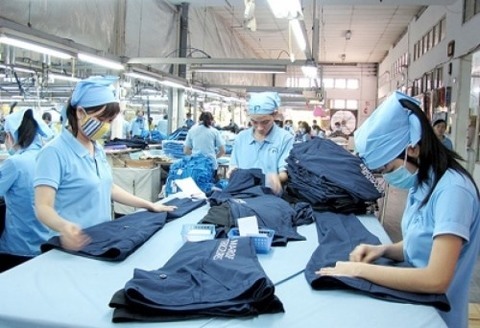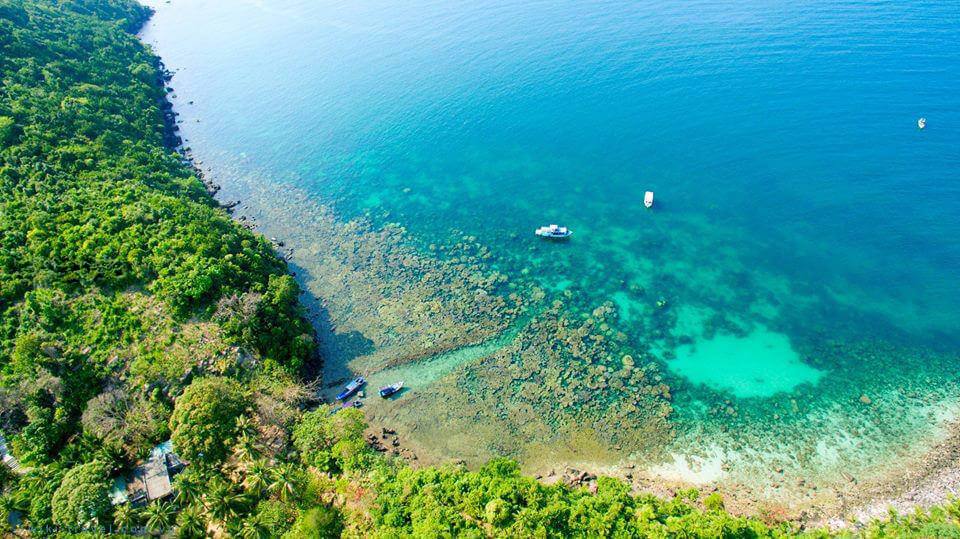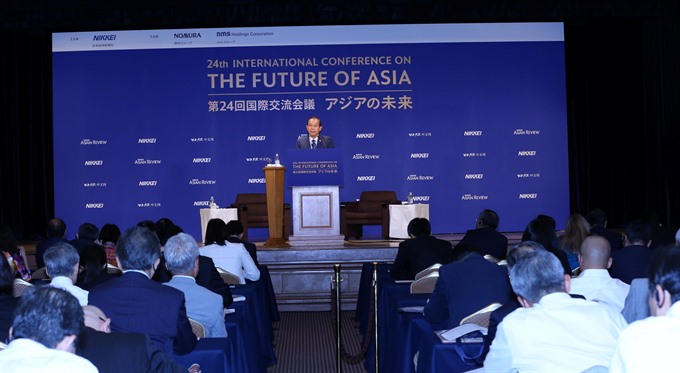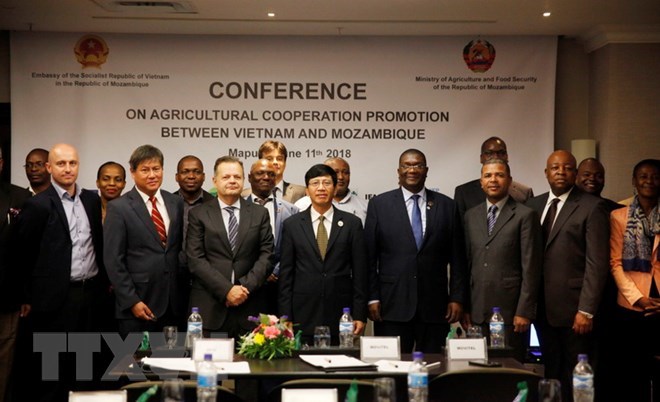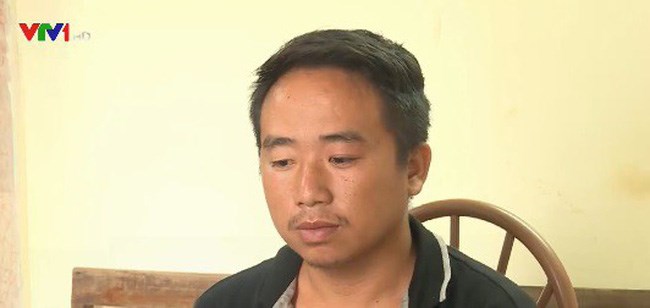Ministry optimistic about fruit-veggie export prospectsHanoi – With effective cooperation between farmers, businesses and State management agencies, Vietnam is likely to realise its goal of 10 billion USD in fruit-vegetables export turnover by 2020.  Dragon fruits for exports (Photo: VNA) The Ministry of Agriculture and Rural Development is devising measures to increase the export turnover of fruits and vegetables to 4 billion USD in 2018 from 3.5 billion USD in 2017. According to Nguyen Quoc Toan, head of the ministry’s agricultural product processing and market development department, Vietnam earned 1.32 billion USD from exporting fruits and vegetables in the first four months of 2018, a year-on-year rise of 29.5 percent This is a good sign reflecting the effective coordination of localities and enterprises, he said. Vietnam has great potential in agriculture with competitive fruits and vegetables. The export turnover of fruits and vegetables has seen impressive growth in recent years, which topped 1 billion USD in 2015 and 2 billion USD in 2016 and hit 3.5 billion USD in 2017. Seeing fruits and vegetables as a strong product, businesses and farmers have joined hands to make long-term investment. Toan added that Vietnamese fruits and vegetables have been sold in 170 countries and territories. Vietnam has signed nearly 16 bilateral and multilateral free trade agreements, he said, adding that the international economic integration in agriculture has brought both opportunities and challenges for the country. “If we can organise production effectively, the proportion of Vietnamese fruits and vegetables in the global market will increase,” he said. Despite impressive achievements in 2017, up to 70 percent of Vietnamese fruits and vegetables were exported to China, while the ratio to other major markets like the Republic of Korea, Japan, the US and the EU was limited. This was attributed to shortcomings in processing, preservation and logistics infrastructure, Toan said, adding that building material supply areas for processing plants is a headache for State management agencies. He suggested businesses improve quality and invest in fruit and vegetable preservation to reach out further to the global market. VNA |
Article 0
↧
↧
Article 4
Cambodian PM vows to stay in power for another two termsPhnom Penh – Cambodian Prime Minister Hun Sen has announced that he would stay in power for another two terms to ensure political stability and national development.
Cambodian Prime Minister Hun Sen (Photo: AFP/VNA) Speaking at a ceremony in the capital city of Phnom Penh on June 5, PM Hun Sen said he wants to turn Cambodia into a middle-income nation. Maintaining the leadership role will help him to realise the target, he said. Meanwhile, Cambodian King Norodom Sihamoni has called for the people to vote in the forthcoming national election, saying that it is the only chance to elect their leaders in every five years. In a royal message released to the media on the same day, King Sihamoni said the forthcoming election is a free, fair, and confidential election. Cambodia is scheduled to hold a national election for the 125-seat National Assembly on July 29. Twenty political parties will contest in the forthcoming election, which will see some 8.3 million people cast their ballots, according to the National Election Committee (NEC). The ruling Cambodian People's Party (CPP) of PM Hun Sen is forecast to continue winning the election as the Cambodia National Rescue Party (CNRP) - the biggest opposition party - was dissolved by the Supreme Court in November 2017 after its leader Kem Sokha was arrested and charged with treason for conspiring with a foreign power in an attempt to overthrow the government. Up to 118 senior members of the CNRP have also been prohibited to participate in political activity for five years. In the last election five years ago, eight political parties joined the race. As a result, the CPP won 68 seats against 55 seats for the CNRP in the then-123-seat National Assembly. VNA |
↧
Article 3
Việt Nam GDP to grow by 6.6% in 2018: ICAEW HÀ NỘI – Việt Nam’s gross domestic product (GDP) is expected to grow 6.6 per cent in 2018, down slightly from 6.8 per cent last year.
Việt Nam’s gross domestic product (GDP) is expected to grow 6.6 per cent in 2018, down slightly from 6.8 per cent last year.– Photo vietnamnet.vn The forecast was made by the Institute of Chartered Accountants in England and Wales (ICAEW), who organised a seminar on economic insight for Southeast Asia in Hà Nội on Wednesday. Growth in the region is forecast to come in at 4.9 per cent from 5.3 per cent last year, as a result of moderate export growth across the region from the sharp acceleration last year. Unlike the US and Europe, Asia had a promising start this year, with Southeast Asia economies expanding 5.2 per cent year-on-year, slightly softer than the 5.3 per cent in the previous quarter. In Việt Nam, economic growth eased back in the first quarter, to 7.4 per cent year-on-year, following a stellar end to last year. However, the quarterly result was still the strongest Q1 outcome in a decade driven by ongoing strength in the manufacturing sector, solid service sector activity and improving agriculture output. Mark Billington, ICAEW regional director for Southeast Asian, said: “Although for Việt Nam external demand is expected to moderate, domestic demand is forecast to strengthen in 2018, driven by solid foreign direct investment inflows, buoyant consumer spending and expansionary monetary policy conditions.” In 2019-20, we expect growth to ease back slightly to around 6.3 per cent from our forecast of 6.6 per cent this year amid a less expansionary monetary policy and a maturing of the global trade cycle,” he added. Monetary conditions will also remain supportive of domestic demand. In July last year, the central bank lowered its rediscount and refinancing rate to 4.25 per cent and 6.25 per cent respectively. The increase in private credit will also encourage household spending. The State Bank of Việt Nam aims to achieve credit growth of 17 per cent this year after bank lending increased by 18.2 per cent last year. However, this rapid expansion of lending does raise risks to financial stability and inflation. Indeed, while headline inflation has so far been below the government’s 4 per cent target this year, inflation is expected to rise to an average of 3.9 per cent this year as food prices exert less of a drag. But there is a risk that price pressures pick up more significantly. In this event policy makers will either need to accept lower growth rates or take a chance on inflation. Separately, rising US-China trade frictions have increased the risks of a “bad case” trade war scenario. As a small open economy heavily dependent on external trade, an increase in protectionism and slower global trade would have significant knock-on effects for Việt Nam, even if it is not the direct target of increased tariffs. Its dependence on foreign investor flows also make it vulnerable to changing global sentiment, attendees heard at the seminar. Nonetheless, it is more likely that tariff imposition will be contained and greater intra-regional trade and the increase in domestic demand’s contribution to GDP will likely protect Asia’s growth to some extent. Commenting generally on the region, Sian Fenner, ICAEW Economic Advisor and Oxford Economics Lead Asia Economist, said: “Manufacturing Purchasing Managers Index (PMI) and recent trade data all point to a more moderate growth in the region going forward. This is consistent with our view that export growth across the region will ease from 2017’s performance, reflecting softer Chinese import demand and normalisation in the global electronics cycle”. We forecast moderate easing in Southeast Asia’s GDP growth to 4.9 per cent in 2018. The slowdown is expected to be broad-based, with only Indonesia growing faster than 2017, she said. VNS |
↧
Article 2
BUSINESS IN BRIEF 7/6 Agricultural sector asked to better meet market demands The Vietnamese agricultural sector should find out a right way of approach, consider market as the target and market standards as quality measurement to help agricultural products better meet both domestic and international market requirements. The suggestion was made by Minister, Chairman of the Government Office Mai Tien Dung at a Vietnam Economic Forum discussing solutions to develop trading of Vietnamese farm produce in Hanoi on June 5. Vietnam has high potential to develop its agriculture sector as the country has exported to 180 markets worldwide, including many choosy markets. Export turnover of agricultural products is expected to exceed 40 billion USD this year. Experts to the forum agreed that new technologies are key to advancing the agriculture sector in Vietnam, as they can boost products’ value to make them more competitive on the global market. The application of technologies in the sector is needed as the market has shown rising demand for clean products with traceable origins. According to Terry Chan, Chairman of Hong Kong E-commerce Supply Chain Association (HKeCSC), blockchain technologies should be deployed as much as possible in agriculture to connect Vietnamese products to the world market. As e-commerce is developing rapidly and new trading platforms are used across the world, agricultural outputs must meet customers’ demands and ensure the quality of the whole production chain, he said. The Vietnamese agricultural sector is trying to integrate into the world’s market, but it has encountered some challenges regarding product quality, supply chains and transparency of the product, Chan said. The sector should propose the Government allow advanced technologies to be applied to resolve existing issues and make safe, high-quality, standardised and traceable products, said Vu Truong Ca, chairman of the management board of Lina Network. Though the government has been giving strong support to the agriculture sector and has issued policies to help farmers, the sector has yet to meet the market requirements, he said. Blockchain technology is strong enough to change the world in the future. It is currently in the early stages, similar to the internet 25 years ago, so Vietnam is capable of exploiting this technology and applying it in the agriculture sector, Ca stated. According to him, Vietnam has big advantages in mathematics and technology, proven by its high rankings in international math competitions. As the whole world has the same starting point in this technology, Vietnam could take the lead. Dao Ngoc Chien, Deputy Director of the High Technology Department under the Ministry of Science and Technology, said that the ministry will accompany businesses in this issue. He said his department is drafting a development plan and submitting it to the ministry this month. The draft plan contains four topics: evaluation of the fourth industrial revolution and its impacts in some key sectors, and key technological applications for economic industries. Dairy maker TH Group is a typical example of successfully using high-tech applications in businesses, said Vo Van Quang, Deputy General Director of the Bac A Joint Stock Commercial Bank. He said that the bank in 2009 started funding dairy maker TH Group to develop cattle farms. However, TH Group was able to apply Israeli technologies for cattle raising, from grass development to attaching chips to cows to keep track of cattle’s health and productivity. Thus the dairy producer’s outputs meet standards in domestic and overseas markets. To develop farm produce production, Minister Mai Tien Dung stressed the need to solve land-related issues. Farmers should let out their agricultural land to businesses in order to facilitate labour restructuring and the application of technologies in production in rural areas, he suggested. According to him, Prime Minister Nguyen Xuan Phuc will chair a national conference on hi-tech agriculture and land accumulation in late June. GoBear: Fintech is shaping business digital transformation GoBear Vietnam today hosted its first BEARTalk event on the topic “How fintech is shaping your digital transformation”. The event attracted over 20 senior executives from financial services, real estate and The event hosted by GoBear Vietnam attracts many senior executives from financial services, real estate and fintech organisations operating in Vietnam During the event, keynote speakers Rachan “Butch” Reddy, general partner of IDG Ventures Vietnam and Marnix Zwart, co-founder and chief product officer of GoBear shared key domain expertise and engaged the audience in meaningful discussions about the development of fintech in Vietnam, as well as how to positively disrupt the market via digital transformation. “It was an honor and a pleasure speaking at the BEARTalk event in front of such a distinguished group of industry leaders. I look forward to building on the strong relationships that were formed today,” Rachan “Butch” Reddy said. On this occasion, Sean Preston, country manager, Visa Vietnam, Cambodia, and Laos also shared: “The event is a great opportunity for those who are interested in fintech to network and have engaging conversations on developments in the industry. I also learned more about GoBear, the good services they offer, and can now make others aware in my interactions with clients and the industry.” “It is my great pleasure that the BEARTalk event provided knowledge and effective networking for our honored guests. GoBear Vietnam has also received more exposure from potential partners in different industries, which is very encouraging. I will continue to host future events to provide meaningful sharing opportunities and to raise awareness for the fintech community,” Bao Nguyen, GoBear Vietnam’s country manager concluded. Since the official launch in Vietnam in early December 2016 with five products - comparison of credit cards, personal loans, travel insurance, fixed deposits, and bank accounts - as well as educational pages for credit cards, bank accounts, and unsecured loans, GoBear Vietnam has landed over four million sessions to become a trusted provider of comparison services for financial products in Vietnam. GoBear is Asia’s first and only metasearch engine in insurance and financial products. It was founded based on the simple premise that a consumer should find freedom and ease in choosing complex financial products like insurance, credit cards and loans. Headquartered in Singapore since early 2015, GoBear has established presence in Singapore, Thailand, Malaysia, the Philippines, Hong Kong and Vietnam and will continue to expand across Asia in 2018. As one of the fastest growing fintech startups in Asia, GoBear is leading the way in making financial products accessible to all with its unbiased and personalised comparison process. GoBear’s user-oriented platform neither aggregates nor sells products. GoBear simply offers consumers a free and transparent comparison process based on their financial needs, and not influenced by service providers’ commissions or advertising. The result is a user-friendly experience that empowers users to make better informed decisions efficiently, saving both time and money. Capital shortage hinders social housing projects The social housing development program has achieved 30 percent of the goal of the national housing providing strategies because of a capital shortage, said the Ministry of Construction. According to the Ministry, developers are facing difficulties in accessing to loans for building houses for low-incomers and workers in industrial parks and export processing zones; subsequently, pace of housing construction is sluggish. 186 projects including 75,700 apartments have been put into use as the Vietnam Bank for Social Policies just disbursed over VND1.2 trillion, meeting 13 percent of demand for the period 2018-2020. In 2018, the bank has not disbursed while it was asked to disburse VND500 billion ($21,909,748) before. The amount will be provided to low incomers to buy social houses. A representative from the Ministry of Construction said that the sluggish pace of social housing construction is due to a capital shortage of credit institutions which will give loan to incomers. The government has stipulated that social house buyers and leaseholders are allowed to ask for loan with preferential interest rate from the Bank for Social Policies, however, in reality, no buyers, tenants and developers are able to access the capital. As per the statistical figure in localities, 206 social housing projects including 168, 700 apartments are sluggish or halted. Investors of some projects asked to transfer social housing to commercial housing projects. Additionally, local administrations don’t take heed to social housing construction. Plus, investors neglect building houses with small area and cheap price. To reach the goal of the social housing development plan in 2016-2020 under the national social housing development strategy, by 2020, the country has targeted 12.5 million square meter of social houses. Lately, the Ministry of Construction has proposed the government to provide additional VND3 trillion to the Vietnam Bank for Social Policies for the goal of social housing projects until 2020 as well as VND3,431 billion for credit institutions to offset loan interest in 2018. After the preferential loan package of VND30 trillion (US$1.3 billion) for affordable home purchases ended in 2016, property companies in Ho Chi Minh City have asked the Government to solve hiccups along the way of implementation of social housing policies as per the House Law 2014 and the government’s edict No. 100/2015/ND-CP. Moreover, realty companies petitioned that all social housing policy bracket can enjoy interest rate for loans at 4.8 percent and 130 percent for overdue debt in the bank for social policies or nominated credit institutions. In its document responding to the petition, the State Bank said that credit institutions have not provided capital for offsetting loan interest for buying social houses. Right after these credit institutions were granted the capital for offsetting loan interest, they will be directed to apply new law for buying social houses as per the government’s decision No. 18/2018. 300 businesses to participate in HCMC Industry and Trade Promotion Fair 2018 The 2018 HCM City Industry and Trade Promotion Fair will be held at Phu Tho Stadium in HCMC’s district 11 on July 14-19, announced the municipal Department of Industry and Trade. 300 businesses to participate in HCMC Industry and Trade Promotion Fair 2018 According to director of the Ho Chi Minh City Center of Support Industries Development Hoang Tho Vuong, this year’s event will attract more than 450 display booths of over 300 businesses. The fair is one of the activities of the city’s industry and trade promotion program in 2018, aiming at maintaining economic growth of HCMC, supporting enterprises to strengthen their competitive ability, boosting trade and production and promoting brand names. The annual event also encourages the Vietnamese people to give priority to using made-in- Vietnamese products. Ministry optimistic about fruit-veggie export prospects With effective cooperation between farmers, businesses and State management agencies, Vietnam is likely to realise its goal of 10 billion USD in fruit-vegetables export turnover by 2020. The Ministry of Agriculture and Rural Development is devising measures to increase the export turnover of fruits and vegetables to 4 billion USD in 2018 from 3.5 billion USD in 2017. According to Nguyen Quoc Toan, head of the ministry’s agricultural product processing and market development department, Vietnam earned 1.32 billion USD from exporting fruits and vegetables in the first four months of 2018, a year-on-year rise of 29.5 percent This is a good sign reflecting the effective coordination of localities and enterprises, he said. Vietnam has great potential in agriculture with competitive fruits and vegetables. The export turnover of fruits and vegetables has seen impressive growth in recent years, which topped 1 billion USD in 2015 and 2 billion USD in 2016 and hit 3.5 billion USD in 2017. Seeing fruits and vegetables as a strong product, businesses and farmers have joined hands to make long-term investment. Toan added that Vietnamese fruits and vegetables have been sold in 170 countries and territories. Vietnam has signed nearly 16 bilateral and multilateral free trade agreements, he said, adding that the international economic integration in agriculture has brought both opportunities and challenges for the country. “If we can organise production effectively, the proportion of Vietnamese fruits and vegetables in the global market will increase,” he said. Despite impressive achievements in 2017, up to 70 percent of Vietnamese fruits and vegetables were exported to China, while the ratio to other major markets like the Republic of Korea, Japan, the US and the EU was limited. This was attributed to shortcomings in processing, preservation and logistics infrastructure, Toan said, adding that building material supply areas for processing plants is a headache for State management agencies. He suggested businesses improve quality and invest in fruit and vegetable preservation to reach out further to the global market. Experts: Vietnam-Australia trade set to grow Bilateral trade between Vietnam and Australia is poised to grow thanks to lower tariffs under free trade agreements, according to Vo Tan Thanh, Vice Chairman of the Vietnam Chamber of Commerce and Industry (VCCI). Speaking at a conference on Vietnam-Australia relations on June 5, Thanh said that Australia would remove 90 percent of its import tariffs from the Association of Southeast Asian Nations (ASEAN) and New Zealand within 2018, and the remaining 10 percent in 2020, in accordance with the ASEAN-Australia-New Zealand Free Trade Agreement. In addition, the upcoming Comprehensive and Progressive Agreement for Trans-Pacific Partnership (CPTPP) would help promote trade between Vietnam and Australia. Thanh said that the two countries have had a close business partnership for 45 years and have seen great developments in trade, investment and tourism. Australia is Vietnam’s eighth biggest trade partner and has invested around 400 projects valued at 1.8 billion USD into the country, ranking 19th among 126 countries and territories investing in Vietnam. Vietnamese companies are also investing in several projects in Australia. Thanh is confident that Australia will rise to be one of the top 10 countries investing in Vietnam in the future. Australia is one of Vietnam’s biggest official development assistance (ODA) providers, pouring around 150 million USD into Vietnam annually. However, according to Le Thanh Tung, Director of Tien Thinh International Migration and Investment Consulting, while Vietnam is Australia’s 15th largest import market, Vietnam’s export value to Australia only accounts for 1.7 percent of Australia’s total import turnover. There would be more opportunity for Vietnamese companies to increase their export volume to Australia, with the help of market research and counselling, he said. However, he added that Australia had tough requirements for the goods it imports, so Vietnamese firms must ensure that their goods meet Australian requirements. Gary Dawes, senior trade advisor from Austrade TradeStart and New South Wales Business Chamber, said that exporting Vietnamese goods to Australia could be a good way for Vietnam to enter other foreign markets as Australia is the 5th most developed economy in the Asia-Pacific region and also exports to other markets such as New Zealand and the US. He also advised Vietnamese firms before investing to carefully research Australia’s demands and make sure they stand out from competitors. In 2017, bilateral trade was at 6.5 billion USD. Vietnam exported 3.3 billion USD worth of goods to Australia. Thanh Ha litchis to be introduced to customers in Hanoi 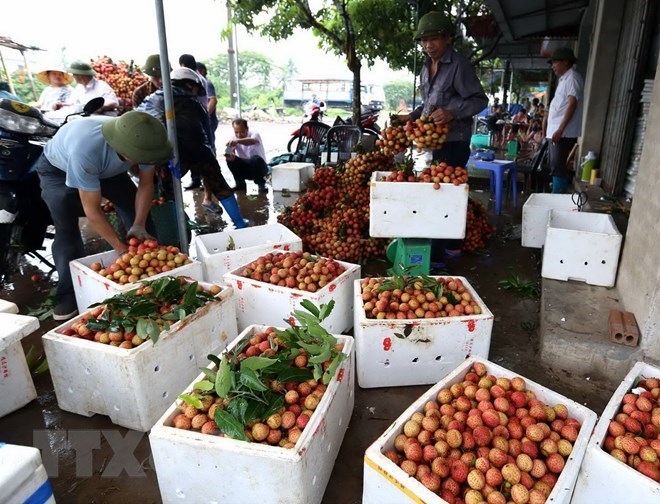 A litchi selling point in Thanh Ha district of Hai Duong province Thanh Ha litchis, a specialty of northern Hai Duong province, will be introduced to customers in Hanoi during a week-long festival from June 12-18. The information was released at a press conference held by the organisers in Hanoi on June 5. The festival is designed to promote consumption of the fruits. To serve the festival, the An Viet Group Joint Stock Company is coordinating with ABA Cooltrans Company in providing transportation and cool storage services. With a 25,000 sq.m cold storage which has a capacity of 10,000-15,000 tonnes of products, the preservation time of litchi will last at least 20 days. Hai Duong litchis received a geographical indication from the Ministry of Science and Technology’s National Office of Intellectual Property in 2007. The local fruits were in the Top 10 quality products in 2013 and 2014 and received the Gold Brand prize in 2015. The Vietnam Association of Food Science and Technology granted a “trustful and safe food brand” certificate to Thanh Ha litchis in 2016. The same year, the ancient litchi tree in Thuy Lam village was recognised as the oldest of its kind in Vietnam. Thanh Ha district has 3,900 hectares of litchis, which are expected to yield 35,000 tonnes of fruits this year. According to Nguyen Thi Ha, Vice Director of the provincial Department of Industry and Trade, the province has 10,500 hectares of litchis, expected to yield 55,000-60,000 tonnes of fruits this year. The harvest time is from May 15 to the end of June. Currently, 131.68 hectares of local litchi cultivation are qualified for export to the US, EU and Australia. The province is also home to 334 hectares of litchis grown in accordance with VietGAP standards. Besides the domestic market, Thanh Ha litchis have increased its presence outside the country. The fruits have been sold in Australia, Canada, China, France, Malaysia, the Philippines, Singapore, Sweden, Thailand, the United Arab Emirates and the US. Ho Chi Minh City’s retail market thrives Ho Chi Minh City’s revenue from retail sales in the first half of this year is estimated at more than 328.58 trillion VND (14.47 billion USD), accounting for 65.3 percent of the city’s total earnings from retail sales and services and up 12.9 percent from the same time last year. The municipal Department of Industry and Trade said on June 5 that the robust development of the local retail market has created opportunities for domestic producers and suppliers. The market has been rather stable and there is no scarcity of products or price shocks during the January-June, said Nguyen Phuong Dong, vice director of the department. Along with the price stabilisation programmes, the department launched the “Vietnamese people prioritise Vietnamese goods” campaign in which products must ensure food quality, safety and hygiene. The event drew the participation of 90 organisations, including 78 businesses and 12 credit organisations. Loans worth 19.65 trillion VND (865.6 million USD) in total were offered to businesses joining in the price stabilisation programmes in the city. Since the outset of the year, the southern largest economic hub has accelerated brand building, and improved prestige for the programmes in general and local businesses in particular by stepping up communications campaigns and supporting enterprises in expanding markets. Provinces and cities in the southeast and southwest regions have received assistance to carry out the price stabilisation programmes. Meanwhile, assistance has been given to many firms to renew their production facilities. In addition, the city has developed the network of price stabilisation shops which sell made-in-Vietnam products, and products cultivated in line with VietGAP and GlobalGAP standards. Logo of the price stabilisation programmes will be labeled on specific products to raise the public awareness of the programmes’ significance and efficiency. Dung Quat oil refinery among top 10 green factories The Dung Quat Oil Refinery operated by Binh Son Refining and Petrochemical Joint Stock Company (BSR) has been in top ten eco-friendly factories in Vietnam for the second consecutive year. The accreditation came from the Vietnam Association for Environmental Economics (VIASEE) under the Ministry of Natural Resources and Environment. The BSR has paid due attention to the investment of waste treatment technologies including the use of chemicals and micro-organisms which meet all environmental sanitation requirements in treating solid waste, waste water, and air as well. In addition, its products, unleaded E5 RON 92, RON 95 petrol, and Diesel Oil 0.05S, were in top 20 products friendly with the environment. Besides performing stable and profitable business, the operator of Dung Quat Oil Refinery has made significant contributions to the environmental protection and sustainable development. According to VIASEE Chairman Truong Manh Tien, the “top ten green and friendly plant” award is part of the efforts to accelerate the national strategy on green growth, raise public awareness of the significance of green growth, and promote the use of clean and renewable energies. Also, it encourages local enterprises to apply advanced technology in production, and recycle energies in manufacturing to improve competitive capacity and create prestigious products towards benefits and good health of the consumers. Ministry to auction stake at Bach Dang Construction Corporation The Ministry of Construction will auction all of its stake, equivalent to over 205 billion VND (8.97 million USD) or 94.61 percent of total shares, at Bach Dang Construction Corporation – JSC on June 18. The auction will be held at the Hanoi Stock Exchange, and the starting price is 13,300 VND per share, the exchange said. The firm has charter capital of more than 217 billion VND (9.49 million USD) at present. The Bach Dang corporation has one subsidiary, Bach Dang 201 Construction JSC, and owns 55.31 percent of the capital in this firm. It also owns between 4 and 37 percent of the capital of 20 associated companies. In 2018, Bach Dang Construction Corporation targets over 3.56 trillion VND (155.75 million USD) in revenue and 20 billion VND (875,000 USD) in post-tax profit, up 60.82 percent and 35.6 percent from last year, respectively. It is operating in industrial structure construction; irrigation; post; airport; ports; urban and industrial park infrastructure; housing, rail and road infrastructure building; and property business. Hanoi’s economy performs well in five months Hanoi’s industrial production index rose by 7.8 percent in the first five months of this year, said Director of the municipal Department of Planning and Investment Nguyen Manh Quyen. Total retail and services revenue increased 10.4 percent to 983 trillion VND (43.68 million USD), compared to 7.4 percent in the same period last year. The city lured 860 million USD in foreign direct investment and granted licenses to 225 projects worth 529.2 million USD. There were 27 projects using non-State capital valued at 27 trillion VND and while 13 others registered additional capital of 1.98 trillion VND. Total State budget collection was estimated at 92.4 trillion VND. Foreign tourist arrivals in the capital hit 1.92 million, up 27.3 percent annually. The city ranked 13th in the provincial competitiveness index, up one place, and moved up one slot to second in the provincial administrative reform index among 63 cities and provinces nationwide. It generated jobs for 89,000 people, or 58.5 percent of the yearly plan and approved national fund loans worth 578 billion VND to create jobs to 21,900 workers. About 15,500 people who served the nation received benefits. Up to 250 billion VND in housing support was provided for poor households via the Vietnam Bank for Social Policies. Since early this year, 296,370 health insurance cards have been issued to the poor and those subject to social protection. As many as 261 people received care in social protection establishments. Hanoi approved a plan to simplify 61 administrative procedures in seven State management fields and announced several amended and supplemented administrative procedures under the management of the municipal Department of Information and Communications and Public Health. Between now and the year’s end, the city will continue strengthening discipline, stepping up administrative reform to offer optimal support to businesses and people, renovating apparatus to improve the efficiency of legal enforcement and leadership of departments and agencies. It will also take measures to improve business climate and competitiveness. The city will step up supply-demand connectivity programmes, facilitate capital access to manufacturing and trade and accelerate construction and disbursement in key projects. During the monthly meeting, Chairman of the municipal People’s Committee Nguyen Duc Chung urged localities to hasten disbursement in construction and site clearance. The municipal Department of Home Affairs was asked to rearrange health stations in ward and district levels and further cut administrative procedures. Technology can raise quality of agricultural products New technologies are key to advancing the agriculture sector in Viet Nam, as they can boost products’ value to make them more competitive on the global market. Experts and specialists told a Vietnam Economic Forum conference yesterday that advanced technologies, including blockchain, could help companies, organisations and households in the agricultural sector raise productivity, save costs and create higher quality products. Nguyen Quoc Toan, acting director of Agricultural Market Processing and Development, said Viet Nam has high potential to develop its agriculture sector. The country has exported to 180 markets worldwide. Of all products, vegetable exports reached US$1.5 billion in 2016 from $105 million in 2003 and are expected to touch $3.5 billion this year. The application of technologies in the sector is needed as the market has shown rising demand for clean products with traceable origins. According to Terry Chan, chairman of Hong Kong E-commerce Supply Chain Association (HKeCSC), blockchain technologies should be deployed as much as possible in agriculture to connect Vietnamese products to the world market. As e-commerce is developing rapidly and new trading platforms are used across the world, agricultural outputs must meet customers’ demands and ensure the quality of the whole production chain, he said. The Vietnamese agricultural sector is trying to integrate into the world’s market, but it has encountered some challenges regarding product quality, supply chains and transparency of the product, Chan said. The sector should propose the Government allow advanced technologies to be applied to resolve existing issues and make safe, high-quality, standardised and traceable products, Vu Truong Ca, chairman of the management board of Lina Network, said. Though the Government has been giving strong support to the agriculture sector and has issued policies to help farmers, the sector has yet to meet the market requirements, he said. “Blockchain technology is strong enough to change the world in the future. It is currently in the early stages, similar to the internet 25 years ago, so Viet Nam is capable of exploiting this technology and applying it in the agriculture sector,” Ca said. According to Ca, Viet Nam has big advantages in mathematics and technology, proven by its high rankings in international math competitions. As the whole world has the same starting point in this technology, Viet Nam could take the lead. Dao Ngoc Chien, deputy director of High Technology Department under the Ministry of Science and Technology, said that the ministry would accompany businesses in this issue. He said his department is drafting a development plan and submitting it to the ministry this month. The draft plan contains four topics: evaluation of the fourth industrial revolution and its impacts in some key sectors, and key technological applications for economic industries. Dairy maker TH Group is a typical example of successfully using high-tech applications in businesses, said Vo Van Quang, deputy general director of Bac A Joint Stock Commercial Bank (Bac A Bank) He said that the bank in 2009 started funding dairy maker TH Group to develop cattle farms. However, TH Group was able to apply Israeli technologies for cattle raising, from grass development to attaching chips to cows to keep track of cattle’s health and productivity. Thus the dairy producer’s outputs meet standards in domestic and overseas markets. PetroVietnam contributes US$1.79bn to State budget The National Oil and Gas Group (PetroVietnam) contributed VND40.8 trillion (US$1.79 billion) to the State budget in the first five months of 2018. This exceeds the plan by 32 per cent and fulfils 55 per cent of the yearly target. According to PetroVietnam, the petrol market has seen unexpected developments in the past five months, negatively affecting the firms’ business. The group operationalised the Bungka Pakma-PM3CAA field from May 12, a month and 19 days earlier than scheduled. The firm’s total production of oil reached 10.44 million tonnes in May, exceeding the plan for the five-month period by 2.7 per cent and representing 45.7 per cent of the annual target. The firm also produced 9.8 billion kWh of power in the January-May period, surpassing its plan by 6.1 per cent, along with 695,000 tonnes of nitrogen and 2.69 million tonnes of petroleum. PetroVietnam’s revenue in the first five months of the year reached VND234.5 trillion, 21 per cent higher than its plan. The group’s after-tax profit reached VND9.8 trillion, exceeding the plan by 15 per cent and fulfilling 51 per cent of its yearly target. Vietcombank gains GPI certification Vietcombank has received SWIFT’s Global Payments Innovation Initiative (GPI) certificate, becoming the first bank in Viet Nam to gain the accolade. Speaking at the SWIFT go-live announcement ceremony in Ha Noi on Monday, Le Hong, SWIFT’s representative in Viet Nam, said Vietcombank is the 60th bank worldwide to receive the certificate. “SWIFT highly values Vietcombank’s efforts to successfully implement GPI within only six months even with the bank’s large number of transactions and numerous payment systems,” Hong said. “The bank is also a pioneer in bringing the best services to customers.” Dao Minh Tuan, Vietcombank’s deputy general director, said becoming a GPI bank will boost Vietcombank’s efforts to provide comprehensive money transfer solutions to customers. He also said Vietcombank plans to launch new functions to increase transaction speeds in the coming phases of its GPI project. SWIFT GPI has links with 165 banks around the world, of which more than 50 are officially GPI banks. These include some of the world’s leading banks such as JPMorgan Chase, Wells Fargo, Deutsche Bank, and HSBC, as well as Citibank. Banks belonging to the SWIFT community account for over 25 per cent of total commercial payment transactions in the world. SWIFT aims to have all cross-border payment transactions implemented by GPI banks by 2020. VIB awarded best bank partner in region Vietnam International Commercial Joint Stock Bank (VIB) has been awarded the “Best Trade-Operations Bank Partner in East Asia and Pacific in 2017". This recognition was within the framework of the Global Trade Finance Program (or GTFP) by IFC, a member of the World Bank Group. The award aimed to honour the banks that have been active in the GTFP, which helped expand and enhance the trade finance capacity of domestic banks in supporting import-export enterprises in emerging markets, including Viet Nam, VIB said in its statement. According to IFC, Vietnamese import-export enterprises highly appreciated VIB’s innovation and flexibility in providing trade finance products, especially quick and accurate trade operations. Besides, VIB has successfully connected and worked with more than 7,500 banks and branches of the correspondent banks in 61 countries and territories to support Vietnamese import-export enterprises in many fields such as oil, metals, chemicals, agricultural products and food to access to global markets. "The award given to VIB is the recognition of the bank’s efforts and success in trade finance in general and IFC’s GTFP in particular,” Anurag Mishra, IFC representative said. Thanks to its participation in the banking network of GTFP, VIB is known by banks worldwide, helping it access to other markets and has a good liquidity, he said, adding that on that basic, the Viet Nam-based bank is ready to meet the demand for loans of import-export enterprises at preferential and competitive interest rates. IFC also advised VIB on small and medium-sized enterprise (SME) banking to serve these firms effectively and sustainably as one of the main development orientations of the bank in the coming time, he said. Since joining the GTFP in 2011, VIB has increased the trade finance line four times by IFC with the current limit up to US$120 million. Total disbursement to VIB through IFC’s guarantee in 2017 reached $260 million. In November 2017, IFC announced $185 million of syndicated loans to VIB, including $100 million from IFC and $85 million from three international banks such as Cathay United Bank, Industrial and Commercial Bank of China - Hong Kong Branch and Kiatnakin Bank of Thailand. This loan aims to solve two key development challenges in Viet Nam, including the financing gap faced by SMEs and lack of affordable housing. Masan Consumer to pay high dividends despite struggles Food and beverage company Masan Consumer will pay a high cash dividend rate in June despite a steep decline in business in 2017. The consumer goods arm of Masan Group decided to pay shareholders cash dividends at 45 per cent, which means each share is worth VND4,500 (20 US cents). The payment will be made on June 28 and the company will finalise the list of shareholders for the payout on June 18. In addition, it plans to pay bonus shares to existing shareholders this year at the rate of 15 per cent. The net revenues of Masan Consumer dropped 11 per cent in 2017, totaling VND13.2 trillion (US$579 million). Its net profit hit a six-year low at nearly VND2.13 trillion, down 20 per cent year-on-year. Masan Consumer has set a target for net revenues of VND17 trillion to VND18.5 trillion in 2018, a growth of 29 per cent to 40 per cent against last year. Its after-tax profit is also projected to increase between 45 per cent and 59 per cent to VND3.1 trillion to VND3.4 trillion. The company reported net revenues of VND3.53 trillion and net profits of nearly VND780 billion in the first quarter. Masan Consumer is trading on the Unlisted Public Company Market (UPCoM) at around VND100,000 ($4.39) per share. Shark Tank back for season 2 TV reality show Shark Tank will be back from July to nurture start-ups in the country and connect them with investors. In this the second season, each episode will last 45 minutes and be broadcast at 8.30pm on Wednesdays on VTV3. According to the organisers - TVHub and VTV24, the programme has attracted many start-ups from the industrial sector, indicating the impact of technology 4.0 on start-ups. In the show, start-up entrepreneurs will talk about their companies to a panel of business owners and executives, hoping to raise investment from them by selling stakes. The four “sharks” in the panel this year are Nguyen Xuan Phu, chairman of Sunhouse Group; Thai Van Linh, head of strategy & operations of VinaCapital; Pham Thanh Hung, deputy chairman of CEN Group; Nguyen Ngoc Thuy, chairman of EGroup. They will be joined occasionally by Dzung Nguyen, director of CyberAgent Viet Nam and Thailand; Louis Nguyen, general director of Saigon Asset Management; Nguyen Thanh Viet, chairman of Intracom; and Dang Hong Anh, deputy chairman of TTC. Shark Tank attracted many viewers when it debuted last season with 48 start-ups and saw 22 of them raise a total amount of over VND116.6 billion (US$5.1 million). Since then, with guidance from their mentors, some of the start-ups like Tigtac, Emwear, Ogami, Supership, Phleek, and Soya Garden have done exceedingly well. Soya Garden, in which Thuy invested VND20 billion ($877,000), has planned to open 30 restaurants around the country. The show also offered viewers many lessons on how to develop a business and explore the market. Shark Tank, developed by Sony Pictures, has two versions -- Shark Tank and Dragons’ Den. Since starting in Japan in 2001, the programme has appeared in 35 nations and territories and attracted 300 million views. In the US, the programme receives an average of 250,000 registrations every season, with 48 per cent of the start-ups succeeding in raising funds from investors. Viettel announces data-focused strategy for Myanmar Viettel Group has announced it will focus on data and new digital services as its new company in Myanmar, Mytel, begins operations on June 9. Its motto would be DATA, the company said, standing for D-igital & new services, A-dvanced technology, T-rustworthy, A-ffordable & various services. In its first year of operations, Mytel plans to focus investment in infrastructure, setting up more than 7,000 4G base transceiver stations (BTSs) and laying over 30,000km of fibre-optic cable. Mytel is Myanmar’s fourth mobile phone network after State-owned MPT, which has a 42 per cent market share, Telenor (Norway), which has 35 per cent, and Ooredoo (Qatar), which has 23 per cent. But when it launches operations, Mytel will be the first mobile network in Myanmar to simultaneously provide 4G services nation-wide. The others first entered big cities before expanding to smaller cities and rural areas. In the beginning, Mytel will provide calling and texting services at 50 per cent of current market rates and data at 37 per cent below market rates. Calling, to be offered from June 9, will be billed in 1-second blocks instead of the 15- and 20-second blocks by other operators. As an inaugural promotion, Mytel will offer the Mite Tal (meaning “super cool” in Burmese) strategic fee package. For 4,000 Myanmarese kyats (US$3), subscribers will get 5GB and 250 minutes of calling within the Mytel network for 30 days. But as an introductory offer, on top of this, the company is providing for free 1.5GB and 150 minutes of calling for three months, 100 per cent bonus on top-up value and call billing in 1-second blocks after the free calls are used up. Le Dang Dung, Viettel’s deputy general director, said while Myanmar has experienced rapid economic growth, mobile phone penetration remains low, creating opportunities for telecom operators, especially Viettel. “We are targeting two to three million customers in Myanmar in 2018.” Mytel is the brand name of Telecom International Myanmar, a joint venture between Viettel and two local partners, Star High Public Company and Myanmar National Telecom Holding Public. Mytel has invested $1.5 billion, accounting for 66 per cent of all Vietnamese investment in Myanmar. With the project, Viet Nam jumps from 10th place to seventh among the 49 countries and territories investing in Myanmar, and is the second largest ASEAN investor. Myanmar has been Viettel’s foreign market with the highest economic growth rate, at 7 per cent so far and largest number of population with 53 million. It also has high growth in the telecommunications and IT sector. From having with the lowest mobile phone usage rate in the world (higher only North Korea), Myanmar has experienced a stunning mobile phone SIM usage per capita growth from 10 per cent to 90 per cent after only three years of opening its economy. The total number of subscribers has risen from 600,000 to over 16 million. The International Monetary Fund (IMF) said Myanmar could increase its economy’s scale four-fold to $200 billion by 2030. The IMF also said the finance, banking, energy, telecommunications and IT sectors offer the most opportunities for foreign investors in terms of both market potential and human resources. VNN |
↧
Article 1
Social News 7/6 Japanese Encephalitis threatening children’s lives 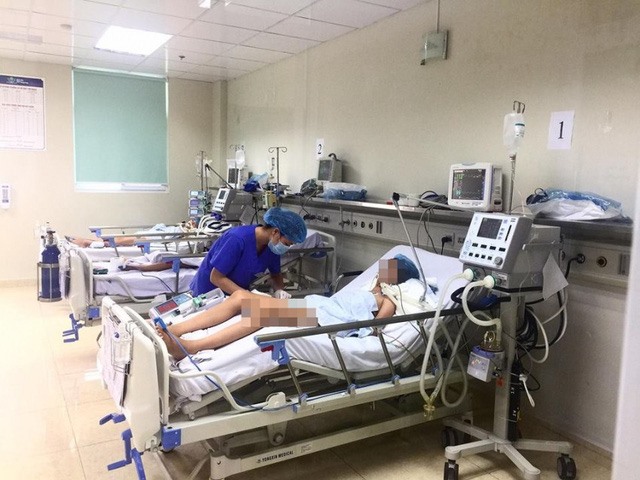 The thirteen-year-old girl from Hải Dương Province was hospitalised after suffering from acute fever and convulsions.—Photo dantri.com.vn Thirty severe cases of Encephalitis—Meningitis are being treated at the Department of Infectious Diseases of Việt Nam National Children’s Hospital, reported Phụ Nữ Việt Nam (Việt Nam Women) newspaper. Of all the cases, two children were diagnosed with the deadly Japanese Encephalitis, a contagious disease carried by mosquitoes. Both were not vaccinated properly, or possibly not at all. Lê Quỳnh Tr., a thirteen-year-old from Hải Dương Province was hospitalised after suffering from acute fever and convulsions. The child was reported to be nauseous, unresponsive to antipyretics and experiencing headaches. She then had doctors at a provincial hospital test her condition, and perform a CSF (cerebrospinal fluid) puncture before diagnosing her with the disease and moving her to the Việt Nam National Children’s Hospital. Even while receiving respiratory help and being treated with anti-edema drugs for ten days, the child’s condition remained unstable. Another child suffering from Japanese Encephalitis, Nguyễn Đức A, 15 months old, from Bắc Ninh Province, was luckier, acquiring a stable state of health after just four days of similar treatment. Japanese Encephalitis is a malicious disease with a high risk of fatality (25—35 per cent), according to Đỗ Thiện Hải, vice chairman of the Department of Infectious Diseases at the National Paediatrics Hospital. He warned that the disease is difficult to diagnose in its early stages since the symptoms resemble common infections, but after two or three days discernible signs begin to emerge, such as sudden high fever, nausea, dry vomit and dull reactions. The disease spreads so quickly and severely that children could experience tremors, fall into a coma, or even die after just a day or two, Hải said. What’s more, complications that follow could impair patients’ capabilities to communicate or work, he added. The most efficient preventive step against Japanese Encephalitis is through a proper vaccination process of three shots: the first shot being given while the child is one year old, followed by the second after a week or two, and the third a year later. Five to seven years after that, the child will became vulnerable to the infection again, so the process must be repeated until the child turns 15, Hải suggested. The second best prevention is to ensure a clean environment whereby parents frequently sanitise to prevent the growth of harmful bacteria. Experts suggest sleeping with a mosquito net to refrain from being bitten. When children are feverish or show signs of central nervous system damage, they should be hospitalised promptly for timely diagnosis and treatment. Court reviews asset embezzlement case at PVP Land 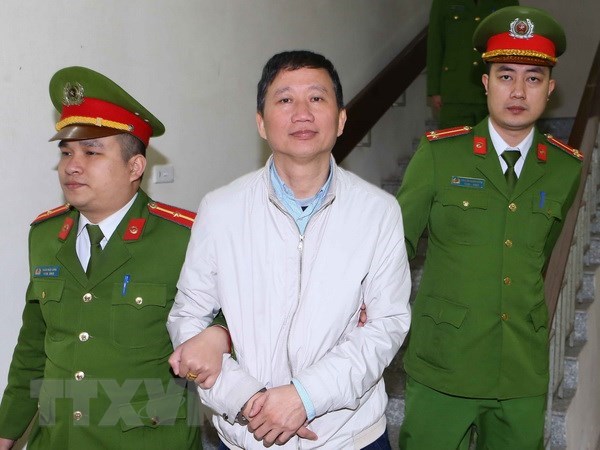 Trinh Xuan Thanh, former Chairman of the Board of Directors of PetroVietnam Construction Corporation (PVC), is led out of the court. The High-Level People’s Court in Hanoi on June 5 opened a trial to look into the appeals of the defendants in the asset embezzlement case at PetroVietnam Power Land JSC (PVP Land). The court is scheduled to last until June 7. In February 2018, the Hanoi People’s Court sentenced Trinh Xuan Thanh, former Chairman of the Board of Directors of PetroVietnam Construction Corporation (PVC), to life imprisonment. Thanh’s accomplices, Dao Duy Phong, former Chairman of PVP Land’s Board of Directors, was given a jail sentence of 16 years. Dinh Manh Thang, former Chairman of the Board of Directors of Song Da Oil and Gas Investment and Commerce JSC, got nine years in prison. Le Hoa Binh, former Chairman of the Board of Directors of 1/5 Construction and Services JSC and Minh Ngan JSC, and Nguyen Thi Kim Thoa, former chief accountant of 1/5 Construction and Services JSC and Minh Ngan JSC were sentenced to eight-year and six-year imprisonments, respectively. Thai Kieu Huong, former Deputy General Director of Vietsan Investment JSC, and Huynh Nguyen Quoc Duy, a self-employed trader, each received a prison sentence of 10 years. All these defendants were charged with “asset embezzlement” in accordance with Article 278, Clause 4, Count a of the 1999 Penal Code (now is Article 353, Clause 4, Count a of the 2015 Penal Code), according to the court. Six out of the eight defendants lodged their appeals against the first-instance sentences. However, Thanh and Phong then withdrew their appeals. Meanwhile, Thang, Huong and Duy asked for a reduction of their jail terms. Thoa claimed she is innocent in the case. Phong’s wife, Nguyen Thuy Hoa, who was involved in the case as a person with related interests and obligations, also lodged an appeal requesting the return of 2 billion VND of the money that her family had paid to correct the consequences of the case as the cash is more than the requested amount. Between February and mid-April 2010, Thanh, as Chairman of the Board of Directors of PVC, along with Thang, Duy and Huong, with the support of Binh and Thoa instructed Dao Duy Phong and Nguyen Ngoc Sinh, representatives of PVC’s capital at PVP Land, and Dang Sy Hung, chief of PVP Land’s economic and planning division, to transfer 12.12 million shares of PVP Land at Trans-Pacific Services JSC – the parent company of Vietsan to Minh Ngan JSC with a price lower than the deposit price. They appropriated a differential sum of more than 87 billion VND (3.86 million USD). Of the money, Thanh arrogated 14 billion VND, while Thang pocketed 5 billion VND; Phong, 8 billion VND; and Sinh, 2 billion VND. The defendants received a total of 49 billion VND from the deal. According to the verdict of the first-instance trial, among the defendants, Thanh played the decisive role in the case, followed by Phong and Sinh. Religious followers in Hanoi join hands to protect environment 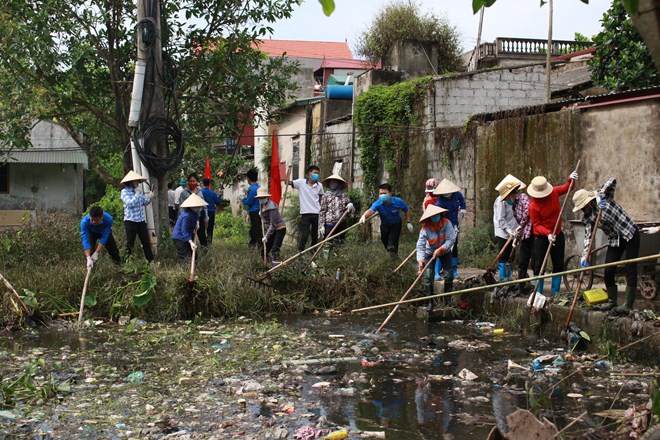 Residents in Tri Thuy commune of Phu Xuyen district, Hanoi, clean a canal near Provincial Road 428 after an environmental protection campaign launched on June 5 Religious followers in Hanoi joined municipal authorities in an environmental protection campaign launched at the church of Hoang Nguyen Parish in Tri Thuy commune, Phu Xuyen district, on June 5. The campaign was part of activities in response to the World Environment Day (June 5) and the action month for the environment. At the launching ceremony, President of the municipal Vietnam Fatherland Front Committee Vu Hong Khanh said religious organisations have done good work to protect the environment. Efforts to protect the environment and respond to climate change in the capital city have resulted in many positive outcomes over the last couple of years, he noted, elaborating that the municipal committee of the Vietnam Buddhist Sangha has combined environment-related content with activities of Buddhist training schools. The Caritas of the Archdiocese of Hanoi has organised “Green Saturdays” to promote clean-up activities. The Hanoi Capital Oratory of Caodaism has encouraged followers to practice food safety and use vegetarian food. Meanwhile, dignitaries of the Bahá'í Faith called on its followers to popularise environmental protection messages on the occasion of the bicentenary of Bahá'u'lláh, the founder of the Bahá'í Faith, last year, the official added. He asked authorities, religious organisations and local residents to continue working to protect the environment and respond to climate change. Priest Joseph Dao Ba Thuyet, head of the Caritas of Phu Xuyen Deanery, described the campaign as a driving force for religious followers to be more responsible in environmental protection. He also called on all Catholics to act for a clean and beautiful world. According to the municipal Department of Natural Resources and Environment, activities have been taking place across the city from May 15 to July 31 in response to the action month for the environment, including promoting waste collection and treatment, stepping up examination and settlement of projects with high pollution risks and enhancing cooperation with foreign partners to ensure effective and sustainable use of water resources. Young ASEAN leaders contribute ideas to protect Mekong Delta environment 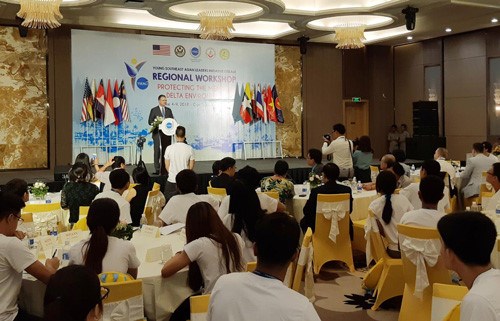 At the workshop (Source: tapchicongsan.org.vn) Some 120 young leaders from the Association of Southeast Asian Nations (ASEAN) contributed their ideas to protecting the environment in the Mekong Delta of Vietnam at a workshop which opened in Can Tho city on June 5. The event, which runs until June 9, was organised by the US Mission to Vietnam and the Resource Centre for Community Development from An Giang University. Participants will study the consequences of changes in the environment in the Mekong Delta such as landslides, salinisation, river flooding, sea level rising, degradation of water resources and the effects of building hydroelectric plants, which all impact on people’s lives and the economic development of the region. Through presentations, case studies, site visits and interactive activities, participants will explore potential short and long term solutions and strategies for addressing changes in the environment that are causing serious consequences in Can Tho city and the Mekong Delta. US Ambassador to Vietnam Daniel Kritenbrink said the US government is investing for the sustainable future of countries in the Mekong River basin. Protecting the environment in the Mekong Delta not only brings benefits for residents living along the Mekong River but also helps promote development and security in Southeast Asia, he added. The US will devise policies to support food and energy resources in the Mekong Delta in the long run as well as programmes to improve the management of water resources, reduce environmental pollution and build clean energy solutions. It will also carry out projects to help farmers develop agriculture adapting to climate change, the diplomat said. During their stay in the Mekong Delta, young Southeast Asian leaders will make fact-finding tours to areas that bear the brunt of climate change in An Giang, Can Tho and Bac Lieu. The workshop is part of the Young Southeast Asian Leadership Initiative (YSEALI) – a programme launched by the US government in 2013 to strengthen leadership development and networking in Southeast Asia. YSEALI seeks to build the leadership capabilities of youths in the region, strengthen ties between the US and Southeast Asia and nurture an ASEAN community. Vietnam launches design for clean energy future 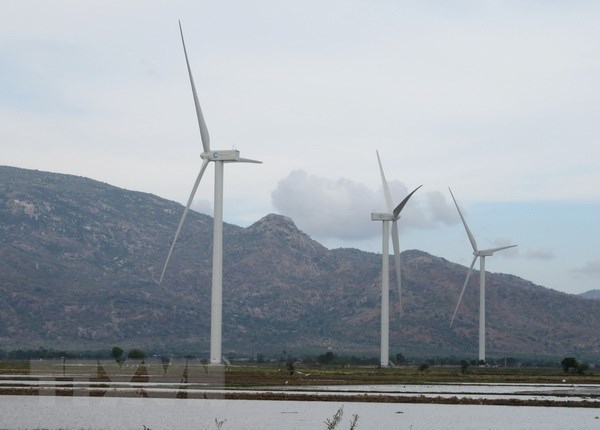 The Dam Nai wind power project The design of a clean energy future in Vietnam was announced at a conference held in Hanoi on June 5. Nguy Thi Khanh, Executive Director of the Green Innovation and Development Centre (GreenID), said the design is the result of a GreenID study on development scenarios for electricity sources in Vietnam. With criteria focusing on health benefit, feasible cost, and national energy security, the research showed Vietnam might not need to build coal-fired thermal power plants but still archive energy security at affordable prices. Nghiem Vu Khai, Vice Chairman of the Vietnam Union of Science and Technology Associations (VUSTA), said green energy is a smart move for Vietnam in response to climate change, as the country hold potential in solar and wind power. Dao Trong Tu, deputy head of the Centre for Sustainable Development of Water Resources and Climate Change Adaptation, highlighted a number of benefits brought about by the design. According to him, the design will help ensure energy security in the country via reducing coal imports and avoid the construction of about 25 coal-fired thermal power plants by 2030, thus cutting the pressure of mobilising 60 billion USD for the building. As a result, the country will not have to burn approximately 70 million tonnes of coal per year, which also means Vietnam will save about 7 billion USD a year from cutting coal imports. The volume of CO2 emissions will drop by about 116 million tonnes annually, while the air and water will become less polluted. The design is estimated to help prevent 7,600 early deaths per year by 2030. Participants showed their approval of the design, stating that the study put forth a safe and suitable option in meeting Vietnam’s future demand for energy. The design presents a country adequate energy with the environment and human health protected, said Nguyen Trong An, Deputy Director of the Research and Training Centre for Community Development. Border communes in Dak Nong connected to national grid 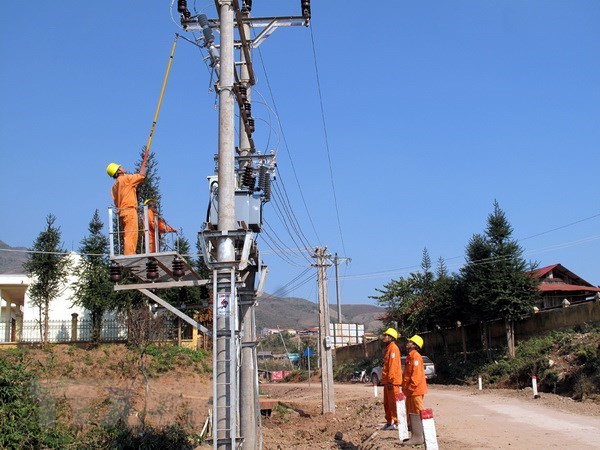 Almost 95 percent from Thuan Ha and Thuan Hanh border communes in Dak Song district, the Central Highland province of Dak Nong, have accessed electricity thanks to a local power project in 2014-2020 period Almost 95 percent from Thuan Ha and Thuan Hanh border communes in Dak Song district, the Central Highland province of Dak Nong, have accessed electricity thanks to a local power project in 2014-2020 period. Dak Song district has 21 hamlets to get benefits from the project, prioritising the provision of electricity for 1,743 households from 11 hamlets in Thuan Ha and Thuan Hanh communes. In the first quarter of 2018, the Dak Nong Power Company put into operation seven transformation stations with a capacity of 650kVA in Thuan Hanh commune. The company also built a new transformation station with a capacity of 100kVA along with a 1.6km medium-voltage power line and a 2.5km low-voltage power line for more 80 households. Apart from upgrading the power network, the company has also simplified procedures to supply electricity and promote the application of information technology to improve customers caring services. Director of the company Tran Van Thuan said the implementation of power projects in border areas not only significantly contributes to the local socio-economic development but also completing the national target on rural electrification. Dak Nong province shares over 120km borderline with Cambodia. As of 2017, 99.98 percent of communes nationwide and 98.83 percent of households accessed to electricity. One decade ago, the rates were 97 percent and 93.4 percent, respectively. Experts warn ASEAN countries against plastic waste Southeast Asia is home to the world’s top marine plastic polluters and environmental protection goals set by the governments of regional countries are insufficient, warned experts on World Environment Day (June 5). Globally, some 8 million tonnes of plastic is dumped into the oceans every year, threatening the marine life and entering the human food chain, according to the United Nations Environment Programme. Five Asian countries, including China, Indonesia, the Philippines, Vietnam and Thailand, account for up to 60 percent of the plastic waste leaking into the oceans, according to a 2015 report by the environmental campaigner Ocean Conservancy and the McKinsey Centre for Business and Environment. The five economies have "generated exploding demand for consumer products", the report said, but lacked the waste management infrastructure to cope with the surge in plastic garbage. In Thailand, months after the military seized power in a 2014 coup, the junta made waste management a priority and set goals for 2021. They included cutting the use of plastic bags and bottles in government agencies and businesses and plastic bans in tourist destinations. A tax on plastic bags was also mentioned, along with a target to recycle up to 60 percent of plastic by 2021. Other governments have also set ambitious goals. Indonesia, ranked second behind China in the 2015 study of mismanaged plastic waste from communities living near coastal areas in 192 countries, has pledged 1 billion USD a year to reduce marine plastic debris by 70 percent by 2025. The Philippines has not imposed a nationwide ban on plastic bags, but some local authorities regulate the use of the products. Some shopping malls have also replaced plastic bags with paper ones and encouraged reusable bags. Malaysia is likely to introduce a nationwide ban on plastic bags soon, said government officials. Anchalee Pipattanawattanakul, an ocean campaigner with Greenpeace in Southeast Asia, said the region needs a coordinated strategy on plastic waste. She noted that ASEAN countries are aware of the issue, but there is no action plan that will actually decrease the use of plastic. Susan Ruffo, Ocean Conservancy's managing director for international initiatives, stated that recognising the impact of plastic waste is not just a government responsibility, as corporations, civil society and citizens all have a part to play. ’Think Before You Share’ online safety campaign launched in Việt Nam  Facebook, in collaboration with the Management and Sustainable Development Institute (MSD), officially launched “Think Before You Share,” an online safety programme, in Việt Nam on June 5. — Photo MSD Facebook, in collaboration with the Management and Sustainable Development Institute (MSD), officially launched “Think Before You Share,” an online safety programme, in Việt Nam on Tuesday. MSD is a Vietnamese non-government organisation that acts for the rights of marginalised groups, especially children and youth. Through a series of workshops, training sessions and online resources, “Think Before You Share” will provide the youth with tools and guidelines on sharing information safely and responsibly on social media. “Keeping our community safe is core to everything we do, and we want to help youth in Việt Nam make better decisions about what they share online. With ‘Think Before You Share,’ Vietnamese youth will have the tools they need to do just that. We are committed to working with local partners to reach more youth across Việt Nam and build a positive online community,” said Clair Deevy, director of Community Affairs, APAC at Facebook. Executive Director of MSD, Nguyễn Phương Linh, said that “The Think Before You Share” programme was an important part of her work to support the online safety of young people and ensure they have the right skills to contribute to creating positive online communities. “The programme has been designed to help students analyse content on social media and use their own critical thinking and empathy to understand how it informs their opinion. We want to empower students as digital citizens to use social media safely, smartly and create a positive social media experience,” Linh added. Facebook and MSD kick-started the campaign with a two-day summit, which will be attended by more than 100 Vietnamese NGO participants from 15 provinces and cities nationwide. The summit will provide NGOs with tools and practical skills to enhance their efforts in building a secure and useful network environment, create a positive online presence and promote responsible digital citizenship. Through design thinking, critical thinking and empathy, NGOs will create social campaigns that promote better and safer online communities. Besides workshops and training sessions, the initiative will also make online resources and videos available, covering digital literacy, online safety, critical thinking and empathy. As part of this programme, these resources will continue to be shared by Facebook and its partners in more than 100 schools across Việt Nam. The programme, which will visit 15 cities and provinces across Việt Nam, seeks to train approximately 30,000 youth aged between 13 and 18 years old, as well as 1,500 teachers, 100 NGOs, and more than 40 youth trainers. In addition, the initiative aims to reach more than 250,000 youth in Việt Nam online. Prevent strokes since curing is difficult: doctors 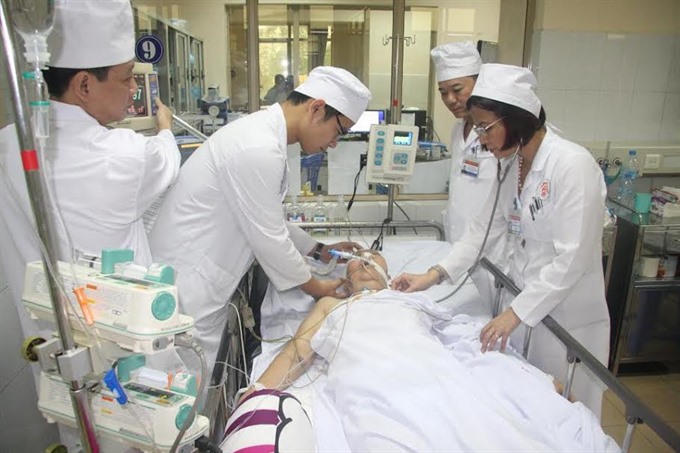 On a recent Saturday morning in the meeting room of Tâm Đức Heart Hospital in District 7, HCM City, a seminar was held on “Atrial fibrillation effective management: the role of new generation anticoagulants in preventing stroke in atrial fibrillation patient”. It was a unique event in the fact that all participants were heart disease patients or people with an elevated risk of stroke. The seminar disseminated useful information as doctors discussed what causes atrial fibrillation (AF), how to control it and what new generation anti-coagulants are available to treat atrial fibrillation. The seminar has been a regular activity organised by Tâm Đức Hospital in recent years for its stroke patients club. Dr Tôn Thất Minh, the hospital’s director, said the incidence of stroke is increasing globally and in Việt Nam due to modern habits like smoking and eating fast food and work-related stress. Yet people barely know about it, he said. “They know a stroke is dangerous since it could cause death. Many do not know how to protect themselves from the disease, how a stroke will seriously affect their lives or what to do when a family member suffers a stroke.” A stroke will impact both the patient and their families, he said. It was for this reason that the hospital, with sponsorship by Bayer Vietnam, set up the club for stroke patients to share knowledge and experiences about the disease, how to prevent it and cure it, how to take care of stroke patients, and how to use medicines correctly. The club has achieved useful results. Minh told Việt Nam News: “Patients’ knowledge has significantly improved compared to two years ago. They know a lot about the disease and some of them can talk about it like a doctor.” Since in the case of stroke it is better to prevent than cure, providing knowledge about it is critical, he said. Trịnh Khắc Nhơn, 58, of District 3 told Việt Nam News that two years after joining the stroke patients club in Tâm Đức Hosptial he has acquired a lot of knowledge. Before joining the club he would often seek information on social networks or from people. “There are many sources of news about medicines and methods to treat heart diseases and stroke. But after joining the club I have discovered all that information is not correct.” He has been taught about new generation medicines and how to use them. He also said he has passed on to relatives and friends the information he has acquired. Nguyễn Thị Bích Hoa, 48, of District 1 is another member of the Tâm Đức Heart Hospital’s stroke patients club. She regularly goes to the club and, thanks to information acquired there, can take care not only of herself but also her mother in the correct way. Such a club has been set up not only at Tâm Đức Hospital but also many other hospitals like Chợ Rẫy and Thủ Đức Hospital, and they have become popular among patients and their families. A stroke club is useful not just for patients and their relatives since when someone gets a stroke, their whole family is impacted. At a seminar Bayer organised in Singapore on stroke, a stroke victim, Anthony Quek, surprised attendees by saying the lives of the five other people in his family too had been affected after he had the stroke. He recalled the difficult early days, saying he couldn’t walk or take a bath by himself, and needed his family’s support for everything. Normal life had ceased to exist, and the five other members in his family had to serve him. Dr N Venketasubramanian Ramani of Raffles Hospital in Singapore said: “A stroke occurs when the blood supply to any part of the brain is blocked, which in turn cuts off the oxygen supply essential to the functioning and survival of brain cells. If it is not treated early enough, a stroke can damage the brain, which may leave it unable to function as it did previously.” A stroke is a medical emergency that can have serious consequences for both patients and their families and friends, he warned. At a seminar held to discuss stroke prevention for non-valvular atrial fibrillation patients organised late last week by the Vietnam Cardiology Association and sponsored by Bayer, Dr Nguyễn Lân Việt, the president of the association said: “To achieve better stroke prevention, especially in high-risk AF patients such as those who had a stroke, kidney failure, etc, patients need to strictly adhere to the treatment regimen regarding the use of anti-coagulants prescribed by doctors and informing doctors in time about disease conditions.” But while underlining the dangers of strokes, doctors also assured that they are completely preventable. “FAST” is an acronym that needs to be learnt by heart, they said. FAST refers to Face, Act, Speak and Time: When you smile, is one side droopy? When you raise your arms, is one side weak? When speaking simple sentences, do you slur or find you are unable to do it? The doctors said anyone having any of these symptoms needs to be rushed to hospital, the last important factor being “Time”. Remember to take the patient to a hospital as soon as possible since 60 minutes is considered the “golden hour” for treating a stroke. Within 60 minutes is the best time for cells to recover, the doctors said. PM approves development plan for resettlement areas 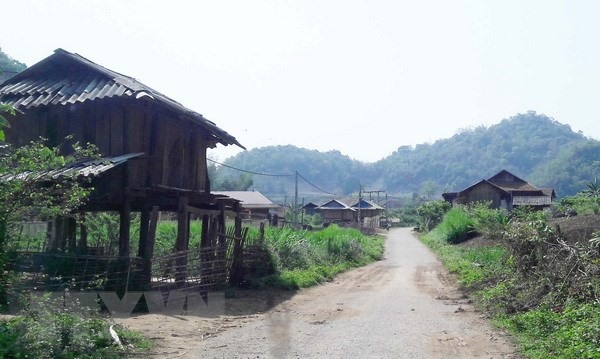 Part of a resettlement area in northern Sơn La province. Prime Minister Nguyễn Xuân Phúc has approved a socio-economic development plan for resettlement areas following the construction of the Sơn La hydropower plant. The plan will be implemented between 2018 and 2025 in 82 communes in Sơn La, Điện Biên and Lai Châu provinces. Ahead of the plant’s construction, as many as 21,820 households, comprising 93,201 people, in these provinces were relocated. The Sơn La hydropower plant is one of the key national projects to supply electricity for socio-economic development, industrialisation and modernisation. It will also play a significant role in preventing floods during the rainy season and providing water in the dry season to residents in the country’s north-west region. The development plan aims to promote agricultural production, increase the rate of trained rural workers and improve the spiritual and material life of people after sustainable resettlement. It targets to increase the per capita income of the local people by two folds by 2020 from 2014 and reduce the rate of poor households to below 10 per cent by 2020. The per capita income is expected to increase by three folds by 2025 and the number of poor households by that year is expected to reduce to zero, according to the plan. The rate of households using safe water is expected to increase to 90 per cent by 2020 and to 100 per cent by 2025. The plan also aims to train and change the jobs of more than 47,000 rural workers by 2020. It will focus on upgrading and building infrastructure in the resettled areas in Sơn La, Điện Biên and Lai Châu as well as stabilise the living conditions and production of 500 households in Quỳnh Nhai and Mường La districts in Sơn La province who were affected due to a shortage of land or by landslides and flash floods. The Sơn La hydropower plant, which became operational in 2013, has six generators and a designed capacity of 2,400MW. It supplies an average of 10.2 billion kWh per year to the national grid. Thái Nguyên warns about rising streptococcus suis infection cases 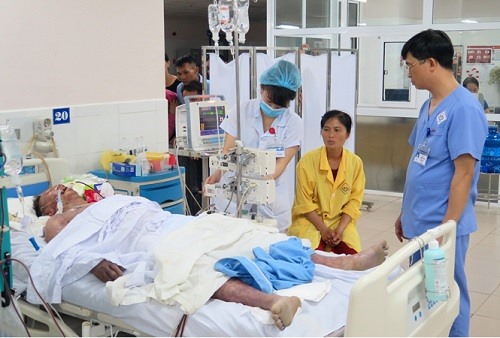 Thái Nguyên Central Hospital has raised a warning over rising streptococcus suis infections, after two fatalities were reported within less than a week of each other.– Photo baogiaothong.vn Thái Nguyên Central Hospital has raised a warning over rising streptococcus suis infections, after two fatalities were reported within less than a week of each other. Dr Lê Hùng Vương, head of the hospital’s Intensive Care and Anti-poison Department said that at least two patients died of streptococcus suis infection after eating unhygienic meat. Ma Đình Du, 34, was hospitalised after cooking and eating meat from a dead goat on May 27. He suffered from vomiting, severe stomache ache and breathing difficulties. He died one day later. La Văn Hào, 49, was in the same condition after being hospitalised on May 31. The patient’s family said they had no idea what kind of food he had eaten previously. Hùng warned that streptococcus suis infection is on the rise due to humid and hot weather. People should not eat raw meat, meat from ill or dead animals and blood soup, to protect themselves from being infected. Đồng Nai to fund VNĐ10 billion to help fish farmers 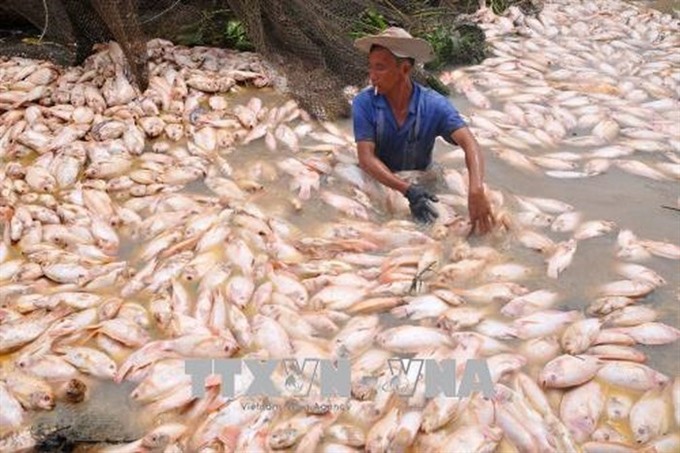 Local authorities said that a natural disaster caused the mass fish deaths on the La Ngà River in Đồng Nai Province on May 20. Đồng Nai Province plans to offer VNĐ10 billion (US$438,115) to fish farmers affected by mass fish deaths on the La Ngà River caused by a natural disaster two weeks ago. The province’s People’s Committee said it was providing assistance under a decree which calls for aid for farmers in case of losses caused by natural disasters and epidemics. More than 1,500 tonnes of dead fish were found on the La Ngà River in the province’s Định Quán District on May 20. Many fish have continued to die. Most of the dead fish belonged to farmers in the district’s La Ngà and Phú Ngọc communes. Most were lăng fish (hamibagrus), diêu hồng fish (read tilapia) and chép fish (carp). Huỳnh Thành Vinh, director of the province’s Department of Agriculture and Rural Development, said an investigation was launched immediately after the incident. Samples of river water and dead fish were collected for tests, while agencies inspected suspicious waste discharged from businesses located upstream from where the deaths occurred. Based on test results, scientists at the HCM City-based Research Institute for Aquaculture No 2 and the Centre for Environmental Monitoring and Analysis said the losses were caused by discharged waste water from businesses. Analysis showed that the decline of dissolved oxygen content caused the fish to die. The concentration of dissolved oxygen in the river water was between 2.6 mg/l to 3.2 mg/l, but the required ratio was 4 mg/l. The test also found an unusual level of NH4 (Ammonia), 5.6-11 times higher than normal, while NO2 (Nitrite) was 10-20 times higher than the allowable levels for fish farming. A heavy rainfall prior to the incident possibly carried a large volume of water polluted with garbage and compounds from upstream. In combination with NH4 and NO2, this also contributed to the fish deaths. In addition, the high density of fish and the narrow distance between cages reduced the volume of oxygen in the living environment of the fish, the local authorities said. Emergency centre lacks infrastructure and personnel  Due to the lack of both infrastructure and personnel, Hà Nội’s emergency centre is able to serve only seven out of every 100 calls. Hà Nội’s 115 emergency department under the municipal Department of Health currently has 21 ambulances which are able to serve only seven out of every 100 calls, according to the centre. The low response rate is blamed on lack of budget. There are 22 ambulances but one has broke down waiting to be scrapped, Nguyễn Thành, Hà Nội’s 115 centre’s director said. Five medical emergency stations are placed citywide in charge of saving people. One is the headquarter station at 11 Phan Chu Trinh Street in the city centre. Four others are in the districts of Thanh Trì, Long Biên and Hà Đông. “According to World Health Organisation, there needs to be 15 medical emergency teams to serve one million people. Hà Nội (with the population of nearly 10 million) is in need of 150 taskforces,” Thành said. “We have 14 emergency teams working every day and we are unable to provide the service to outlying districts of expanded Hà Nội area because they are too far away,” he added. However, the problem causing the biggest headache persists in personnel shortage. Thành said since 2015, five doctors and ten nurses asked to leave. Two doctors moved to other facilities. The city now has 188 staff including 28 doctors, 25 nurse practitioners, 63 nurses, six pharmacists and 48 ambulance drivers. “28 doctors is not enough. Literally 42 taskforces need 42 doctors,” he said. Medical staff on the mission also have to suffer from attacks from relatives of patients. “Some encounter drug addicts. Right after seeing our staff, they take out weapons. In some other cases, at the accident sites, relatives of the victims told us ‘We don’t need you’,” Thành said. He added that many doctors of the centre have not been granted a work permit. The doctors are required to work at medical facilities which have patient beds. But the 115 centre does not have beds so doctor who even work here for ten years have not been certificated. If ambulances come earlier and collaboration is better, more people will be saved, Nguyễn Đình Hưng, director of Saint Paul general hospital said, adding there should be more measures to support the centre in the future. Who will drive ambulances? To save money, the centre did not ask to buy 150 new vehicles with the budget forecasted to amount to hundreds of billions of đồng but instead only replaced more than ten old ambulances, director Thành said. But even when the ambulances are bought, who will drive them, he asked, once again raising a headache question over personnel. Hưng, director of general hospital of Saint Paul, said that Hà Nội should follow emergency model of France where the centres are managed by the hospital. This solution helps solve problems related to infrastructure and personnel shortages. Following local authorities’ order, the city will develop a network of emergency stations which connect with 115 centre and hospitals. Then it is hoped a hospital specialising in emergencies will be built. There needs to be four elements: a core hospital, a network of ambulances, a training centre and a collaborating centre, he said. Road at construction site facilitates illegal coal mining 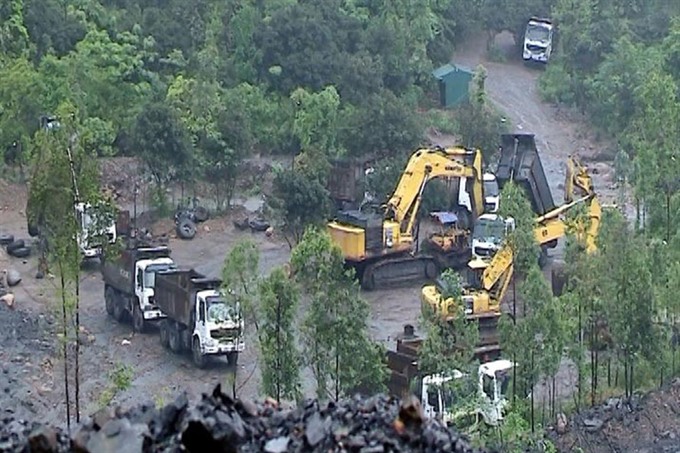 Equiment and vehicles are used for illegal coal mining at the road leading to construction site of Hồ Thiên Pagoda. — Photo laodong.vn The road which was opened to transport materials to the construction site of Hồ Thiên Pagoda in Bình Khê Commune, Đông Triều Town, is being used for illegal coal mining. The town People’s Committee has asked the investor in the road project to speed up the closure of the road and restore the environment by the end of this month, Vietnam News Agency reported on Tuesday. The move followed a request by Secretary of the Quảng Ninh Province’s Party Committee Nguyễn Văn Đọc late last month as the road was not built according to the approved design. Moreover, it was reportedly used by illegal coal miners. The illegal coal mining left negative impacts on the natural environment and destroyed the road from Ngọa Vân (Lying Clouds) Temple to Yên Tử Mountain. The Hồ Thiên Pagoda is located on Phật Sơn Mountain – a part of Yên Tử Range in Bình Khê Commune, Đông Triều Town. The town People’s Committee sent a special group, led by a vice chairman of the committee, to supervise the environmental restoration, including the growing of trees there. The local authority also carried out work to open a road to transport materials to the pagoda construction site by following the approved design strictly. Yên Tử Mountain, located some 50km from Hạ Long City, is surrounded with scenic landscape and ancient pagodas. This sacred mountain is where King Trần Nhân Tông (1258-1308) abdicated his throne and founded Trúc Lâm Zen. It is considered the capital of Vietnamese Buddhism. VNN |
↧
↧
Article 0
Forbes Vietnam announces top 50 firmsHanoi - Forbes Vietnam has announced Vietnam’s 50 top listed companies for 2018, which account for 70.8 percent of total market capitalisation on the HCM and Hanoi stock exchanges.
 The HCM Stock Exchange dominates the 50-best-listed-firm list with 47 companies including Saigon Securities, Vinamilk and FPT Corporation. (Photo: kinhtedothi.v) The 50 listed companies on the two stock exchanges have recorded a combined total profit of nearly 107 trillion VND (4.75 billion USD), a yearly increase of 34 percent. Forbes Vietnam in 2017 reported the figure at 79.4 trillion VND. The firms listed with the highest revenue was the Vietnam National Petroleum Group (Petrolimex) with 153.7 trillion VND worth of revenue, while Vietnam Dairy Products Joint Stock Company (Vinamilk) tops the list in terms of post-tax profit, posting 10.3 trillion VND. Property developer Vingroup is the largest company by market capitalisation, according to Forbes Vietnam, with its market value reaching 15 billion USD on May 15. Financial-banking, real estate, retail and consumer companies account for a large proportion of the market value, notably companies such as Vietinbank, Vietcombank, insurer Bao Viet Holdings, digital retailer Mobile World Investment Corporation and food and beverage producer Masan Group. The HCM Stock Exchange dominates the 50-best-listed-firm list with 47 companies while the Hanoi Stock Exchange has just three. Compared to last year, there were 10 changes in the list with seven making their first entries, including VPBank, Viet Capital Securities and Southern Basic Chemicals JSC. “Forbes Vietnam’s sixth list of top companies in Vietnam reflects the movement of the Vietnamese economy and the securities market in the last year,” said Nguyen Lan Anh, editor of the Forbes Vietnam magazine. “Positive conditions of the financial market have increased the number of well-performing financial-securities firms, followed by some other key industries such as property development and logistics,” she said. In the past 12 months, the Vietnamese stock market has made some significant achievements despite recent volatile weeks. The benchmark VN Index set its new historical high of 1,204 points in early April and the derivatives market also operated officially after having been delayed for a while. In addition, the State’s divestment from some large-cap firms like dairy producer Vinamilk and brewer Sabeco beat analysts’ expectations and the listing of large-cap private companies like Vinhomes, Vincom Retail and Techcombank has boosted the total market value. By mid-May, the total market value of the Vietnamese stock market reached 168 billion USD, equal to 80 percent of Vietnam’s gross domestic product (GDP). That excludes the market value of the high-end property developer Vinhomes, which debuted on the HCM Stock Exchange on May 17 and has a market value of 13 billion USD. Forbes Vietnam applies company ranking methods of Forbes (an American Business Magazine), taking into consideration the characteristics of the businesses listed in Vietnam. The assessment is based on the financial statements audited for five consecutive years from 2013 to 2017. Forbes considered all the listed shares and arranged them by each sector group. The list has been compiled to provide information on companies with outstanding business results and high profits for investors. Besides this, it is also to honour and encourage the spirit entrepreneurialism. VNA |
↧
Article 0
BUSINESS IN BRIEF 8/6 Vietnam AutoExpo 2018 opens in Hà Nội The Vietnamese economy is witnessing a good growth momentum, marking a positive signal for the development of the automobile market, said deputy minister of Industry and Trade Do Thang Hai. Speaking at the opening ceremony of the 15th International Exhibition on Automobile, Transportation and Supporting Industries (Vietnam AutoExpo 2018) at the National Convention Centre in Ha Noi’s Nam Tu Liem District on Wednesday, Hai said the Government would build the automobile industry into an important industry to meet the domestic market demand for trucks, passenger cars and special-purpose vehicles. The Government is also striving to provide a market supplying auto components, parts and some high-value component sets for the global automotive industry, he added. It is predicted that by 2030, Viet Nam will have between 466,000 and 863,000 new cars entering the automobile market. By 2020, the number of motorbikes is expected to reach 36 million units. Hai said the Government has paid attention to the development of the supporting industry and issued many supportive and preferential policies to promote the industry. In addition to this, the improved infrastructure is also a favourable factor helping automobile and motorbike manufacturers and supporting suppliers to develop production and business. With the above predictions and the Government’s efforts, the automobile industry, the auto and motorbike market and the supporting industry in Viet Nam offer a lot of potential for businesses to invest in this industry. Taking this trend forward, the Vietnam AutoExpo 2018 is seen as a meaningful activity for manufacturing and trading enterprises in the automotive, motorcycle and supporting industries. The exhibition will act as a bridge for domestic and foreign enterprises to meet, exchange and co-operate in business as well as investing in, expanding and developing the market. In doing so, they will contribute to promoting the domestic industry in future. Covering nearly 10,000sq.m with 450 booths, the Vietnam AutoExpo 2018 aims to provide visitors with a complete understanding of the market of automobiles, motorcycles and supporting industries in Viet Nam. In the field of transportation, the Vietnam Engine and Agricultural Machinery Corporation and brands from Russia, South Korea and China are showcasing many new products, including trucks, buses, commercial vehicles and special-purpose vehicles. Also on display at the exhibition are popular motorcycle manufacturers, such as Ducati, Harley Davidson, Triumph, Royal Enfield and Kawasaki, with hundreds of models in high-engine displacement. There are hundreds of exhibits on supporting industries, spare parts and components, maintenance and repair services as well as domestic and foreign car accessories. During the exhibition, there will be a seminar on developing the supporting industry, connecting demand and supply to serve production and assembly of commercial cars and special-purpose vehicles in Viet Nam. The exhibition will conclude on June 9. Major export earners report steady growth Vietnam’s major export earners still maintained their growth tempo in the first five months of the year, according to Sai Gon Giai Phong newspaper. Particularly, phones-phone parts topped the list with US$19.5 billion (up 19.8%), followed by computers-electronic products-accessories with US$10.9 billion (up 14.2%) and textiles-garments with US$10.7 billion (up 13.3%). In addition, export revenues from machinery-equipment-tools-spare parts reached US$6.4 billion (up 29.7%), footwear US$6.1 billion (up 7.9%), vehicles-components US$3.3 billion (up17.2%) and wood-wooden products US$3.3 billion (up 10%). In January-May, Vietnam shipped abroad US$93.09 billion worth of goods and spent US$89.7 billion on imports, up 15.8% and 8.2% respectively, resulting in a trade surplus of US$3.39 billion. Foreign direct investment (FDI) enterprises contributed US$66.66 to export revenue, growing 15% and accounting for a whopping 71.6% of the country’s total export turnover. Meanwhile, domestic firms posted outbound sales of US$26.43 billion, a year-on-year increase of 17.8%. According to the Ministry of Industry and Trade, as of May, the U.S. remained Vietnam’s largest importer with revenue of US$17.4 billion, rising 9% over the year-ago period, followed by the EU with US$16.9 billion and China with US$13.8 billion, up 13.6% and 30.8% respectively. Especially, phone and phone part shipments to China were up fivefold against the same period last year. Besides, revenues from computer-electronic product-component exports to the northern neighbor surged 32% and vegetables-fruits 16.5%. The ministry has directed trade counselors and relevant agencies to accelerate the removal of unnecessary requirements hindering export activities and promote meetings with foreign commercial agencies to strengthen cooperation with other markets. VIMF 2018 opens in Bac Ninh 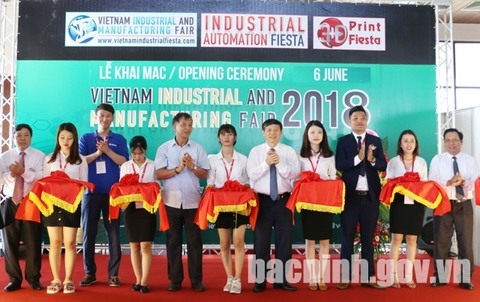 The Vietnam Industrial and Manufacturing Fair (VIMF) 2018 opened at the Kinh Bac Cultural Centre in the northern province of Bac Ninh on Wednesday. More than 200 booths are exhibited at the three-day event. Representatives of many countries and territories are in attendance, including Singapore, Japan, South Korea, India, China, Taiwan, Thailand, Malaysia, the US, Indonesia, Germany, Australia and Viet Nam. Products exhibited at the expo include machine tools and metalworking, welding and coating, automotive and contract manufacturing, sheet metalworking, plastic manufacturing, woodworking and cooling systems. VIMF 2018 is an ideal foundation for manufacturers, producers, investors, suppliers and traders in and outside the country to promote new products; meet customers directly; contact agents and distributors; and develop and expand the market. This is also a chance to enhance investment and co-operation, contributing to improving the competitiveness of enterprises and integrating the provincial economy more deeply and effectively into the international economy. Along with event, there are also Industrial Automation Fiesta 2018 and 3D Print Fiesta 2018. Hai Duong to host litchi festival this weekend The first-ever Thanh Ha Litchi Festival will take place on June 10 in Thanh Ha district in the northern province of Hai Duong, some 60 km from Hanoi. The festival aims to introduce the fruit in the country’s “litchi kingdom” of Thanh Ha and promote its potential and investment opportunities. It is also a chance to link farmers with supermarkets and shopping malls as well as enterprises involved in processing, purchasing, and exporting agricultural products. Some 60 booths will offer litchis, with visitors also seeing a 200-year-old litchi tree in Thuy Lam village in Thanh Son commune, which is the oldest of its kind in Vietnam. They can also visit litchi orchards that meet local Vietnamese Good Agricultural Practices (VietGAP) standards for export to the US, Japan, Australia and the EU, and enjoy the sweet taste of the fruit. After the festival, “Thanh Ha Litchi Week” will be held in Hanoi at the Exhibition Fair, Transaction Economic and Commerce Area at 489 Hoang Quoc Viet Street in Cau Giay district from June 12 to 18, aimed at introducing and promoting Thanh Ha litchi among consumers in the capital and neighboring areas. Along with booths offering Thanh Ha litchi, there will be also be presentations of dishes made using the fruit and a workshop identifying Thanh Ha litchi specialties. Hai Duong litchi received geographical indication (GI) from the Ministry of Science and Technology National Office of Intellectual Property in 2007, which is a label used on products that have a specific geographical origin and possess qualities or a reputation that are due to that origin. The local fruit was in the country’s Top 10 quality products in 2013 and 2014 and received a Gold Brand Prize in 2015. The province has 10,500 ha of litchi, which are expected to yield 50,000 tonnes of fruit each year. The harvest is from mid-May to the end of June. Thanh Ha litchi has been exported to Australia, Canada, Japan, China, France, Malaysia, the Philippines, Singapore, Sweden, Thailand, the United Arab Emirates, and the US. Talenta hosts first blockchain event in Vietnam Talenta, a blockchain consulting firm established in 2017, kicked off the “MaxiBlockVietnam” event in Ho Chi Minh City last weekend, introducing phenomenal blockchain technology and various consensus algorithms used across popular decentralized applications, with a lineup of featured speakers presenting their revolutionary blockchain-based initiatives. “MaxiBlockVietnam” marked Talenta’s first footprint in Vietnam and was a sequel to its successful predecessor, “MaxiBlockGlobal”, which was held at the opulent Shangri-La Singapore earlier this year. Amid a flurry of investigations surrounding a recent $660 million cryptocurrency scam, MaxiBlockVietnam received a pleasantly optimistic reception, paving the way for more blockchain meets in the near future. The most notable speaker was Mr. Edward Du, CEO of MaxiMine, the cornerstone project that hosted MaxiBlockVietnam. Mr. Du has a strong technical background, having been Deputy Director of the Tsinghua German Innovation Center, and also holds an MBA from the prominent INSEAD business school. Opening the evening, he gave a short introduction to the blockchain-based MaxiMine project before moving on to talk about the multitude of solutions it offers as a decentralized cloud mining network and its place as a disruptive technology that can transform life, business, and the global economy. Other blockchain projects featured during the evening included Usechain, the world’s first mirror-identity blockchain, and SAGE, a blockchain-based personal information and behavioral data bank. The evening closed with an address from Ms. Sharon Paul, Managing Director of Cipher Ventures, on the state of digital assets and the rise of Vietnam with its high trading volumes and a growing developer community. Talenta identifies promising blockchain projects in its home country of Singapore as well as initiatives worldwide, offering them an international platform to showcase their ideas to the world. JLL to manage VV Mall in Da Nang JLL has entered into a partnership with VV Mall, a luxurious shopping center set to open in central Da Nang city in the second quarter of next year, becoming the exclusive marketing and leasing agent. “The decision to appoint JLL as the exclusive agent of VV Mall was based not only on its renowned expertise in retail leasing but also the integrated marketing experience provided to create a successful platform,” said Mr. Lisheng Weng, Chairman of VV Mall Shopping Centre. “I am convinced that this partnership will deliver an unforgettable shopping experience in Da Nang in the near future.” “Da Nang has witnessed a significant increase in tourism over the past few years and VV Mall will provide a truly international shopping mall experience that has yet to be seen in the city,” said Mr. Stephen Wyatt, Country Head of JLL Vietnam. Ms. Trang Bui, JLL Vietnam Head of Markets, added that: “We are very excited to work on this project. Given the location and the concept, we believe that the addition of VV Mall will refresh the retail experience in Da Nang.” Located on the highway from Da Nang to Hoi An, with 35,000 sq m of leasable space, VV Mall will offer a wide array of brands to appeal to the retail appetite of local people and tourist alike. This includes renowned fashion brands, an international duty-free store, and restaurants serving various cuisine. VV Mall is also connected to Crowne Plaza Da Nang, providing beachfront access to its customers. Based on a design concept of “Shopping while traveling and traveling while shopping”, VV Mall will become one of the must-visit places in Da Nang for both domestic and international guests upon opening. Led by Ms. Trang Bui, JLL has one of the most active leasing teams in Vietnam, dealing with many Fortune 500 and multinational companies (MNCs). Vietnam’s 50 best-performing listed firms account for 70% of market cap Forbes Vietnam magazine has announced the 50 best-performing companies listed on the Hanoi and Ho Chi Minh Stock Exchanges in 2018. These firms account for more than 70% of Vietnam’s stock market capitalisation and have total profits of nearly VND107 trillion (US$4.7 billion). Among the top 50 listed companies, oil retailer Petrolimex leads the pack in terms of revenue, at VND153.7 trillion (US$6.76 billion), while the most profitable firm is the dairy producer Vinamilk at nearly VND10.3 trillion (US$453.2 million). In terms of the market cap, Vingroup is the largest company at US$15 billion as of May 15. According to experts, Vietnam’s stock market has recorded positive developments overall over the past 12 months, with the VN-Index setting a new record of 1,207 points in April this year. The past year also saw the launch of the derivatives market, better-than-expected capital disinvestment from major companies, such as Vinamilk and Sabeco, and the listing of many large private firms such as Vinhomes, VPBank and Techcombank. By mid-April, Vietnam’s stock market cap reached US$168 billion, equivalent to 80% of GDP. Vietnam AutoExpo 2018 opens in Hà Nội 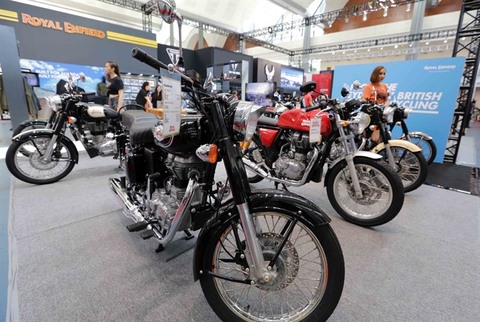 The AutoExpo 2018 showcases popular motorcycle manufacturers, such as Ducati, Harley Davidson, Triumph, Royal Enfield and Kawasaki, with hundreds of models in high-engine displacement. The Vietnamese economy is witnessing a good growth momentum, marking a positive signal for the development of the automobile market, said deputy minister of Industry and Trade Do Thang Hai. Speaking at the opening ceremony of the 15th International Exhibition on Automobile, Transportation and Supporting Industries (Vietnam AutoExpo 2018) at the National Convention Centre in Ha Noi’s Nam Tu Liem District on Wednesday, Hai said the Government would build the automobile industry into an important industry to meet the domestic market demand for trucks, passenger cars and special-purpose vehicles. The Government is also striving to provide a market supplying auto components, parts and some high-value component sets for the global automotive industry, he added. It is predicted that by 2030, Viet Nam will have between 466,000 and 863,000 new cars entering the automobile market. By 2020, the number of motorbikes is expected to reach 36 million units. Hai said the Government has paid attention to the development of the supporting industry and issued many supportive and preferential policies to promote the industry. In addition to this, the improved infrastructure is also a favourable factor helping automobile and motorbike manufacturers and supporting suppliers to develop production and business. With the above predictions and the Government’s efforts, the automobile industry, the auto and motorbike market and the supporting industry in Viet Nam offer a lot of potential for businesses to invest in this industry. Taking this trend forward, the Vietnam AutoExpo 2018 is seen as a meaningful activity for manufacturing and trading enterprises in the automotive, motorcycle and supporting industries. The exhibition will act as a bridge for domestic and foreign enterprises to meet, exchange and co-operate in business as well as investing in, expanding and developing the market. In doing so, they will contribute to promoting the domestic industry in future. Covering nearly 10,000sq.m with 450 booths, the Vietnam AutoExpo 2018 aims to provide visitors with a complete understanding of the market of automobiles, motorcycles and supporting industries in Viet Nam. In the field of transportation, the Vietnam Engine and Agricultural Machinery Corporation and brands from Russia, South Korea and China are showcasing many new products, including trucks, buses, commercial vehicles and special-purpose vehicles. Also on display at the exhibition are popular motorcycle manufacturers, such as Ducati, Harley Davidson, Triumph, Royal Enfield and Kawasaki, with hundreds of models in high-engine displacement. There are hundreds of exhibits on supporting industries, spare parts and components, maintenance and repair services as well as domestic and foreign car accessories. During the exhibition, there will be a seminar on developing the supporting industry, connecting demand and supply to serve production and assembly of commercial cars and special-purpose vehicles in Viet Nam. The exhibition will conclude on June 9. Forum seeks solutions to expand market for Vietnamese farm produce A symposium on agriculture themed 'Solutions to trade development of Vietnamese agricultural products' was held in Hanoi on June 5 in the aim of promoting public-private dialogues on macroeconomic strategies. The event, which is held by the Private Economic Development Research Board (IV Board) under the Government’s Advisory Council for Administrative Procedure Reform, is the opening activity of a series of symposia under the framework of the Vietnam Economic Forum (ViEF). The symposium discussed the main challenges to Vietnamese agricultural products, including the expansion of markets, the application of high-technology to meet market demands, the enhancement of transparency during the production process, and the traceability of agricultural products. Addressing the event, Minister and Chairman of the Government Office, Mai Tien Dung, said that the private sector has made significant contributions to the growth and development of Vietnamese agriculture. Besides its achievements, the Vietnamese agriculture sector has revealed unsolved shortcomings including the lack of linkage with the value chain, and inadequacies in input materials, the quality of agricultural products, the application of science and technology in agriculture, and in brand building, Minister Dung noted. He also asked relevant ministries and sectors to continue to promote administrative reforms related to agriculture and market development to facilitate investors and firms in this area. Solutions proposed at the symposium will be submitted to the Prime Minister at the plenary session of the ViEF 2018 scheduled for December 2018, under which the PM will hold a direct dialogue with the private sector and stakeholders. Township near HCMC to get off ground soon Construction of Waterpoint, a mega urban area spanning 355 hectares in HCMC’s neighboring province of Long An, will start late this month. The first phase, from 2018 to 2023, will be implemented in a 165-hectare area with an investment of some VND6.9 trillion and is expected to generate an estimated VND10.7 trillion in revenue for its developer - Nam Long Investment Corporation (NLG). Waterpoint is the township project that has taken NLG over 14 years preparing land. The planned township has three sides surrounded by the Vam Co Dong River, and the remaining edge stretches along Provincial Road 830 from Duc Hoa town to Saigon-Trung Luong expressway and National Highway 1 in Ben Luc Town. From Waterpoint, it takes only 30-40 minutes to reach Phu My Hung urban area in HCMC’s District 7 or HCMC downtown by taking Nguyen Van Linh Parkway or National Highway 1 and Vo Van Kiet Street. NLG has up to now invested VND1.504 trillion in the Waterpoint project. Chairman of NLG Nguyen Xuan Quang said that the project has been planned and designed in line with international standards with partners from Australia and the Netherlands. Besides, with the foundation being three meters high, the project is not affected by flooding in at least 80 years regardless of any weather conditions. The real estate ecology of Waterpoint comprises low-rise homes with townhouses/villas, high-rise condo buildings, office-shopping-service complex, hospital, preschool and primary school, college and sport facilities. otably, the project features a central park covering 21 hectares with canals across the area. “Waterpoint is intended to be a small city that has all amenities included and close association with the nature. In addition, there is an emphasis on outdoor and sport activities to enhance connections among residents,” Quang shared. HCMC’s real estate market no longer has much land available for new projects, especially large-scale ones. Even in neighboring areas of HCMC it is rare to find a large land site like Waterpoint. Therefore, the project is regarded as a prime land site, which promisingly creates a drive of development for surrounding areas when it is officially implemented. As Thi truong Dia oc has researched, Long An Province, particularly areas bordering HCMC, is emerging as a hot spot for property developers. Big names in the field like Vingroup, Him Lam, Van Thinh Phat and T&T Group are grabbing land in these areas to develop their projects. In addition, inter-regional connectivity is growing fast in preparation for HCMC’s urban planning. There is still room for growth of Long An’s real estate market. “That NLG is quick in launching such a large-scale project as Waterpoint in the area west of HCMC at this time will bring the investor many competitive advantages in attracting customers. It is because the need for estates in this area is big, but there is no project on the market that is comparable to Phu My Hung in the south of HCMC or Sala in the east,” the director of a real estate trading floor in District 7 said. Quang said that besides NLD’s own capital, the Waterpoint project is arousing interest of many foreign property investors. “We are currently in talks with real estate firms from Japan and Malaysia. It is expected official information will be released very soon.” According to a recent report, global real estate services firm Cushman & Wakefield valued Waterpoint’s phase one with 165 hectares at roughly US$106.8 million, or some VND2.43 trillion. Meanwhile, the project’s entire 355 hectares was previously estimated by NLG at VND1.504 trillion. The report of Cushman & Wakefield pointed out advantages of Waterpoint, which are the location at the point connecting HCMC and 13 southwestern localities, the site being ready, and land use fee payments done. Another advantage of the project concerns transport connections, including road, water transport and rail transport in the future. Cushman & Wakefield had confidence that townhouses/villas will have the highest value among products of Waterpoint and the selling price may amount to US$371 per square meter of land. Last year NLG offered nearly 3,000 products on the market. Its after-tax profit, after deducting shareholders’ benefits, was VND535 billion, a 55% increase against the previous year. In terms of profitability, the firm recorded a gross margin of 41% and a net margin of 17%. Such results are quite good compared to the previous year and the average figures of real estate firms. In addition to Waterpoint, this year NLG works on many other major projects such as Mizuki Park with 4,676 Flora apartments, 170 Valora townhouses/villas, EhomeS Saigon South with 1,726 apartments and Akari City with around 5,000 Flora apartments. Binh Duong’s exports reach over 9.2 billion USD in five months The southern province of Binh Duong earned over 9.2 billion USD from outbound shipments in the first five months of 2018, up 16.5 percent over the same period of 2017, according to Director of the provincial People’s Committee Nguyen Van Danh. Danh said that export revenue of the foreign-invested sector reached over 7.4 billion USD, a rise of 18.3 percent, while domestic sector also bagged 1.8 billion USD, an increase of 9.9 percent. In May alone, the province’s export revenue fetched more than 2 billion USD, a rise of 19.6 percent over the same time last year. In the first five months of this year, growth was seen in the majority of Binh Duong’s export products such as wooden products garment and footwear. Upturn was also recorded in major export markets such as the US, China, the Republic of Korea, Japan, and Europe. Danh attributed the results to efforts of local firms in expanding market and improving products’ quality, along with the province’s support to businesses’ operation. The local authorities have also helped businesses enhance the competitiveness of their products and build trademark. Alongside, the province has encouraged local enterprises to apply high technology in production and assisted them in capital access and human resources, he said. This year, Binh Duong aims for a growth of 16.5 percent growth in expert revenue.- Kien Giang stops licensing land reclamation projects The Mekong Delta province of Kien Giang has decided to suspend the licensing of new sea land reclamation projects, Sai Gon Giai Phong newspaper reported, citing an announcement of the provincial government. According to the management board for sea land reclamation projects of Kien Giang Province, two such projects have been developed in Rach Gia Bay. The Rach Gia project commenced in 1999 following a Prime Minister’s decision with a total area of 420 hectares while the Tay Bac project, which covers 116 hectares including 16 hectares of alluvial plain, got off the ground in 2015. The Rach Gia project has reclaimed land for 60,000 residents, a provincial administrative area, a square, hospitals and schools. Phu Cuong Investment JSC has got 160 hectares of land in the Rach Gia project to develop a new urban area. Meanwhile, the Tay Bac sea land reclamation project, implemented by Kien Giang Construction & Investment Consultancy Corporation, includes public facilities, commercial center and resettlement apartments for households living in makeshift canal homes in Rach Gia City. Vietnam food firms set for India expo Many Vietnamese firms are set to participate in the Vibrant Tamil Nadu Expo and Summit in Madurai city, India, to seek information and business opportunities, a meeting heard in HCM City on June 6. Speaking at the meeting, Jeevan Kandpal the Indian consul in the city, said the food industry-focused expo from August 12 to 15 will provide “opportunities to forge business partnerships world-wide.” The expo aims to bring together all the stakeholders from “farm to fork” – a reference to farmers, food processors, manufacturers, traders, exporters and importers, and consumers, he said. India is the world’s second largest producer of fruits and vegetables, marine products, and meat and poultry. It is the largest producer of milk with production estimated at 155.5 tonnes, or approximately 19 percent of the world’s production. Its food and grocery market is the world’s sixth largest, with retail contributing 70 percent of the sales. “Domestic consumption is immense, given the 1.3 billion population and increasing affluence,” Kandpal said. It will be a lucrative food market for Vietnamese firms, he said. “The Indian Government has relaxed norms for the sector, allowing up to 100 percent FDI in food product e-commerce through the automatic route, and the wide consumer base should be a magnet for creating successful business ventures.” Nguyen The Hung, Deputy Director of the Vietnam Chamber of Commerce and Industry’s HCM City office, said food is among Vietnam’s industries with the greatest potential. “Food products not only meet domestic demand but are also exported to many countries and territories around the world. Vietnam is becoming an important supplier of agricultural products and food globally.” Hung hoped through the expo Vietnamese agricultural products, foods and beverages would enter the Indian market. Vietnamese firms would also have the opportunity to network with international partners at the event, he said. Nguyen Dinh Truong, representative of the Vietnam Cashew Association, said cashew enterprises are very interested in the Indian market and, in addition to participating in the expo, would also want to visit leading cashew processing facilities there. The District 5 Business Association said it would send a delegation to the expo. K Thiruppathi Rajan, chairman of the event organising committee, provided information about the event and took questions. Kandpal said bilateral trade grew by 35 percent last year to 12.27 billion USD, and the two countries are striving to lift it to 15 billion USD by 2020. WorldTrans to add more Can Tho-Bangkok chartered flights World Transportation Services JSC, or WorldTrans, looks to launch more Can Tho-Bangkok chartered flights due to rising travel demand, Vu Duc Bien, chairman and general director of WorldTrans, said at the launch of the Can Tho-Bangkok maiden chartered flight on June 6. Bien told local media that the company has sold out tickets of 28 flights taking off in June and July, and even some flights of August for over 5,000 passengers. “Of the figure, 75% of passengers live in Can Tho City and the remaining dwell in neighboring localities,” he added. The number of passengers on Can Tho-Bangkok chartered direct flights in 2018 doubled that last year, up to 5,000 travelers compare to 2,800 in the previous year’s chartered flight program. “We are working with Vietravel to review the number of passengers,” head of the Can Tho-Bangkok chartered flight project Nguyen Vu Duy Nhat said, adding that besides above-mentioned 28 flights, WorldTrans is considering opening more flights from now to end-2018. In addition to these flights, Bien said that the company is joining hands with other localities nationwide to launch over 200 round-trip direct flights to South Korea, Taiwan, Japan, China, Myanmar, Nepal and Bhutan in 2018 and set a target of a 20% increase in 2019. Technology 4.0 key to boosting productivity: experts Technology 4.0 and market research are key to improving Viet Nam’s poor productivity, experts told a conference on in HCM City on Wednesday. Pham Ngoc Hung, deputy chairman of the HCM City Union of Business Associations, said production efficiency was key to competing in international markets as Viet Nam opens up to the world. Viet Nam’s productivity is only around 7 per cent that of Singapore’s, 17 per cent of Malaysia’s and 37 per cent of Thailand’s, according to a 2016 report. Over 90 per cent of businesses in Viet Nam are small or medium sized, and many of them still use outdated technologies, causing their quality to suffer. Hung said 70 per cent of Viet Nam’s exports are by FDI companies, admitting: “There is a lack of trust in Vietnamese products due to perceived lower quality, and many firms choose not to do business with domestic suppliers. “This in turn deters domestic suppliers from investing heavily in upgrading their facilities.” Many small firms generally struggle to improve their technologies also because they do not have access to funding and market information and the drive to constantly update their technologies, he said. Certain funding programmes are inaccessible to them due to complicated and lengthy procedures, he said. The lack of a skilled workforce is also a problem, with many university graduates lacking practical experience, he said. The relatively poor protection of intellectual property rights deter businesses from spending resources on research since they are afraid their work could be stolen, he said. Many small businesses suffer from poor market research and often make plans without considering their customer base. Ly Truong Chien from Tri Tri Consulting said to improve productivity Viet Nam has to constantly keep abreast of the rapidly changing technology trends. Businesses need to study market trends and embrace technology 4.0 and modern techniques, utilising, for instance, big data to get a better picture of their customers, make a close examination of every stage of production rather than just the end products, and focus on developing the talents of their employees, he said. He stressed the importance of market research, urging businesses (especially SMEs) to know their own products and customer base to gain a foothold in the market. But businesses should carefully examine their own situation and adopt technologies appropriately rather than blindly copy from other countries, he added. Ly Son Islands break Japan market The island district of Ly Son in the central province of Quang Ngai has exported 500 tonnes of purple onion – a unique farm product of the island – to Japan. It marks the first time a Japanese company has put in an order for farm produce from the island this year. Director of the Ly Son Island Company Nguyen Van Dinh said that purple onion will be harvested and exported from June to December this year. Dinh said the product has to meet the high requirements of the Japanese market, which means passing strict examinations and gaining a certification of origin before shipping to the country. He said farmers in the island have been successful in gradually applying safe farming techniques and have joined value chains with high productivity, making an attractive price for export. Last year, the district began construction of a high-tech farm to produce organic garlic on the island, with a total investment of VND4 billion (US$177,000). Products of Ly Son Island including garlic, onion, seafood, garlic wine, dried seafood and seaweed were recognised by the National Office of Intellectual Property of Viet Nam, under the Ministry of Science and Technology, in 2007. In 2015, 40 tonnes of Ly Son black garlic were exported to Thailand. The island has planned to produce organic black garlic as well as garlic oils for export to Japan, the US and other Asian countries. Ly Son garlic and purple onion have a distinct flavour and a high demand both at home and in foreign markets. The island produced 2,500 tonnes of garlic and 6,500 tonnes of purple onion from 1,000ha of farmland last year. The island, known as the Kingdom of Garlic in Viet Nam, has around 21,000 inhabitants, of whom 73 per cent make their living from farming garlic and spring onions, alongside fishing. Ha Nam to witness high-tech agricultural products Enterprises from 20 provinces nationwide will showcase high-tech agricultural products and technologies at a fair themed, “High-tech and safe agricultural products in the Red River Delta Region in 2018.” The exhibition will be held in the northern province of Ha Nam from June 15-21. The event will be co-organised by the Ministry of Agriculture and Rural Development (MARD) in co-operation with the Ha Nam People’s Committee. Truong Quoc Hung, head of the Ha Nam Agro-Forestry-Fisheries Quality Assurance Department, said with more than 300 booths comprising associations and enterprises from different provinces and cities, the fair would introduce a wide range of hi-tech agricultural products as well as advanced processing and preservation technologies. Ha Nam is one of the pilot provinces focusing on accumulating land serving and attracting investment in agricultural production to develop high-tech agriculture. As a result, many large enterprises have invested in and developed hi-tech agriculture in the province. The fair will be an opportunity for enterprises to expand exchanges and co-operation in the field of investment and development of high-tech agricultural production and establishment of a safe market for agricultural products. Through this, businesses will be able to grasp the needs and tastes of customers to improve the product quality and develop new products to enhance competitiveness in domestic and foreign markets. MARD will also organise the “Special week of Thanh Ha lychee” in Ha Noi from June 12-18, in co-operation with People’s Committee of the northern Hai Duong Province’s Thanh Ha District, to introduce local lychee. Thanh Ha District applies the quick response (QR) code-based payment technology to develop and protect the brand name of Thanh Ha lychee. This year, the district has so far produced nearly 3,900ha of lychee, of which nearly 93ha are suitable for exports to the United States, Australia, Japan, France and the European Union, with 30ha meeting Global GAP standards. The total lychee output of Thanh Ha District this year is estimated at 35,000 tonnes. Vietnam, Canada boost trade ties The participation of Prime Minister Nguyen Xuan Phuc in the G7 Outreach Summit and his visit to Canada from June 8-10 are expected to create more opportunities for Vietnamese and Canadian businesses to expand their partnership. According to the Ministry of Industry and Trade, Vietnam is ranked fifth in Asia in terms of export turnover to Canada, after China, Japan, the Republic of Korea and China’s Taiwan. The bilateral trade enjoys an annual average growth of 20-25 percent and hit nearly 6 billion USD in 2017. Vietnam mainly exported mobile phones, printers, electric cables, telecommunication equipment, wood furniture, garment-textile, footwear, aquatic products, coffee, cashew nuts, means of transportation and spare parts, sport equipment, rubber, plastic products, and processed fruit and vegetables to Canada. The Southeast Asian country imported from Canada agro-fishery products, soft wood, medicines, wine, navigation services, high technology and clean technology. Canada is ranking 13th among the total 112 countries and territories investing in Vietnam with 161 projects worth 5.2 billion USD. Vietnamese Trade Counselor in Canada Do Thi Thu Huong said there is still large room for Vietnamese enterprises to boost exports to Canada, a country that relies on imports for consumer goods. Although the country’s market scale is only one tenth of the US’ but its per capita import value doubles that of the US. She noted that made-in-Vietnam goods only make up over one percent of Canada’s total imports. According to Huong, the large number of people of Asian origin, including around 250,000 Vietnamese, in Canada is an advantage for businesses to boost exports of farm produce to the market. The trade official added that the Canadian Government plans to diversify the market and reduce its import from the US. Therefore, Vietnam is one of the nations with which Canadian companies want to increase trade and investment ties, she said. Huong revealed that the Vietnamese Trade Office in Canada has worked with Canada’s Trade Facilitation Office to implement projects helping Vietnamese firms make inroads into the market. Minister of Industry and Trade Tran Tuan Anh appreciated Canada’s dynamism in cooperation with the ASEAN alongside with the Trans-Pacific Partnership (TPP). In the context of rising protectionism, the role of countries with remarkable influence such as Canada is very important to international integration and globalization, the minister said. He was of the view that the Regional Comprehensive Economic Partnership (RCEP) and other bilateral and multilateral trade deals that both Vietnam and Canada might join will continue to provide an impetus for globalization. Minister Tuan Anh affirmed that Vietnam shares other ASEAN countries’ interest in researching and reaching a free trade agreement between the bloc and Canada besides the RCEP and other regional cooperative framework. The ministry has directed trade offices and relevant units to apply measures to boost exports of Vietnamese key products to Canada, he said. Apart from long-term strategies, businesses should make use of commitments and incentives from the signed agreements such as the Comprehensive and Progressive Agreement for Trans-Pacific Partnership (CPTPP) and the RCEP to promote exports to Canada, the minister added. Over the past two decades, Canada has been one of the leading providers of development assistance for Vietnam. Canada considers Vietnam a priority partner in Asia in its global market action plan, international education strategy, and development assistance policy. The two countries have also closely work at multilateral mechanisms such as the United Nations, the Asia-Pacific Economic Cooperation (APEC) Forum, and the International Organization of Francophone (IOF). FTAs drive Vietnam-Australia trade ties to new heights Vietnam and Australia have signed free trade agreements (FTAs) committing to tax rate cuts, which will help to stimulate import-export activities between the two nations. According to the ASEAN-Australia-New Zealand Free Trade Area (AANZFTA) roadmap, Australia cuts 90% of import taxes this yearand 100% of tax lines will drop to zero as from 2020. Meanwhile, the Comprehensive and Progressive Agreement for Trans-Pacific Partnership (CPTPP) will promisingly facilitate trade ties between Vietnam and Australia. Vo Tan Thanh, vice President of the Vietnam Chamber of Commerce and Industry (VCCI) and General Director of VCCI HCM City branch, told a conference on Vietnam and Australia trade connection held in the City on June 4 . Mr Thanh said Vietnam-Australia bilateral ties have seen strong development over the past 45 years, especially in trade, investment and tourism. Bilateral trade hit US$6.5 billion last year, including US$3.3 billion from Vietnam’s exports to Australia and nearly US$3.2 billion from its imports. Australia is currently Vietnam’s eighth largest trading partner while Vietnam is the 15th biggest trading partner of the Oceanic nation. By the end of last year, Australia had injected US$1.8 billion in about 400 projects in Vietnam, ranking 19th out of 126 countries and territories investing in the country. The Australian Government has been encouraging its businesses to land more investments in Vietnam, which has also run numerous projects in Australia. Thanh said he believed that with the current growth rate, Australia's investment ranking in Vietnam would be remarkably improved towards becoming one of the top ten foreign investors in Vietnam. Australia is also among the biggest official development assistance (ODA) donor countries to Vietnam. Every year, it provides around US$150 million worth of ODA for Vietnam. Nearly 300,000 Vietnamese people are living in the country, which serves as a bridge to boost bilateral trade ties. Tien Thinh International director Le Thanh Tung, said Vietnam’s exports to Australia make up 1.7% of the country’s total imports only, although Vietnam is its 15th biggest exporter. Australia is considered a potential market for Vietnamese businesses. However, to expand trade and investment activities in Australia, domestic businesses should make further research on the market as well as its investment policies and other regulations, said Mr Tung. Gary Dawes, senior international trade adviser from the New South Wales Business Chamber, said Australia is the fifth biggest economy in the Asia-Pacific region and the Australia Government has long-term and consistent investment and trade policies. Vietnamese businesses should define their target market and ability to approach if they want to invest or do business in the country. As a gateway of many economies, Vietnam will have an opportunity to penetrate other markets after its products enter Australia, said Mr Dawes. Businesses at the conference also put questions concerning exports to Australia, investment attraction policies of New South Wales, information on consumer trends in furniture, plastic packaging, real estate investment opportunities, and real estate trend in the next five years. Bac Giang rejects information about litchi glut The provincial government of Bac Giang has rejected rumors that litchi faced a glut that has prompted certain farmers to dump the unsold fruit, asserting that litchi production and consumption in the province is normal now, news website VnEconomy reports. The authorities of Bac Giang Province insisted that some 60 domestic and foreign traders had come to purchase litchi at over 40 farms in early harvest season. “The information litchi prices went down at a record low of VND10,000 per three-kilo bunch does not reflect the litchi production and consumption in the province, causing worries to farmers,” the provincial authority stressed. Litchi prices in the early season reached a peak between VND30,000 and VND45,000 per kilo. Litchi cultivated according to VietGap standard cost VND22,000 a kilo on June 1 in Tan Yen District. However, the provincial government admitted that litchi priced at VND10,000 a kilo was of poor quality with small sizes. “Bac Giang litchi consumption at the time averages out at 1,200 tons a day, with 9,000 tons having been sold, generating estimated revenue of VND170 billion,” VnEconomy cited the authority as saying. VNN |
↧
Article 0
Social News 8/6 HCM City seeks further support from INGOs 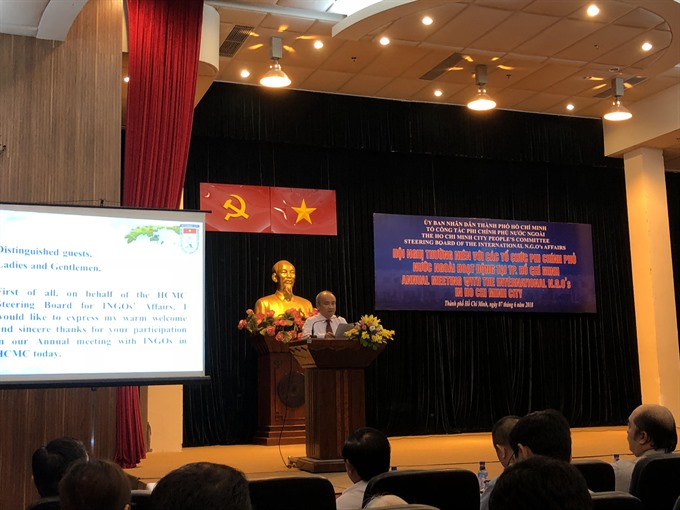 An annual meeting with representatives from international non-governmental organisations (INGOs) discussed INGOs’ vital contributions to socio-economic development in HCM City. HCM City is seeking further support from international non-governmental organisations (INGOs) in socio-economic development, said authorities at the annual meeting between the HCM City Steering Board for INGO Affairs and INGOs held on June 7 in the city. The meeting discussed INGOs’ societal contributions between 2015 and 2017, reviewed INGO activities last year as well as the first five months of the year, and sought feedback from INGOs. Attending the meeting were a representative of the US Consulate General in HCM City, Pamela Pontius; deputy head of the HCM City Emulation and Commendation Board, Ngô Thị Hoàng Cát; and chairman of the HCM City Union of Friendship Organisation (HUFO) and leader of the HCM City Steering Board for INGO Affairs, Huỳnh Minh Thiện; among others. Thiện stressed the importance of INGOs’ assistance and cooperation in conducting humanitarian and development projects in HCM City. “The meaning of humanitarian projects is not only about technical and material support but enhancing the capacity of local staff and fostering mutual understanding between the people of HCM City and other countries,” he said. “HCM City will continue to create favourable conditions for INGOs,” he said. On the occasion, the city’s People’s Committee granted merit certificates to 13 INGOs, while HUFO offered certificates to 31 INGOs and seven companies with outstanding contributions to society. HCM City has 160 INGOs with official licences, including 67 from the US, 61 from Europe, 30 from Asia Pacific and two from Africa, up one organisation compared to last year. In 2017 and the first five months of 2018, HUFO and members of the HCM City Steering Board for INGO Affairs assisted in legal procedures for two INGOs that ceased to operate; allowed 19 INGOs to organise international conferences; and assisted in visa application in 115 situations, among other activities. Although the city’s socio-economic development last year witnessed a slight improvement, achieving steady economic growth this year remains a challenging target, Thiện said. Considering the city’s rapid population growth, it is in need of long-term material and technological support as well as cooperation from the international community, he added. HCM City’s GDP reached 8.25 per cent, up 0.2 percentage points year-on-year. Contractor replaced for delayed progress of bridge 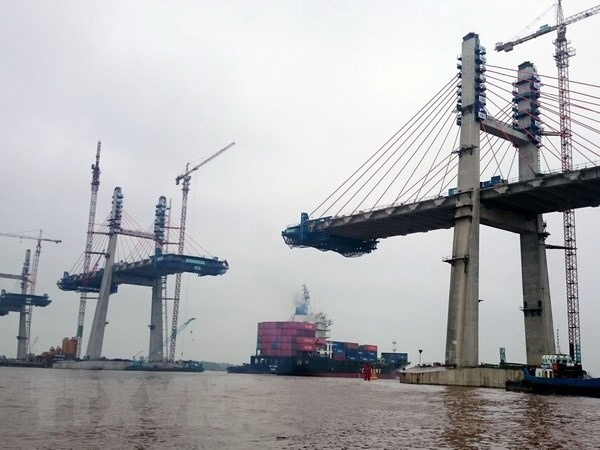 Bạch Đằng bridge is under construction. The Bạch Đằng Bridge BOT Joint Stock Company in northern Quảng Ninh province has decided to replace the contractor of the bridge for delay in construction. The Cường Thịnh Thi Construction Investment Joint Stock Company will be suspended and replaced by another contractor with a better capacity to ensure the progress of the project as scheduled. The 5.4km-long bridge across the Bạch Đằng river is being built at a cost of VNĐ7.3 trillion (US$324 million) in the form of Build-Operate-Transfer. The cable-supported bridge is 28m wide with four traffic lanes. Construction of the bridge started in January 2015. Touted as the first made-in-Việt Nam bridge, it will, together with the Hải Phòng-Hạ Long-Vân Đồn highway, connect the three economic hubs in the north---Hà Nội, Hải Phòng and Quảng Ninh---upon its completion. The bridge will reduce the distance between Hà Nội and Quảng Ninh from 175km to 125km as well as cut travel time between the two localities by half. The final segments of the bridge connecting the northern port city of Hải Phòng and the northern coastal province of Quảng Ninh were joined in April and investors committed to complete the final work before June 30. However, after the final segments of the bridge were joined, the remaining work (some seven per cent of the project) has been progressing slowly. These include spreading asphaltic concrete for the bridge surface, cleaning construction waste and installing bridge barriers. Just a few workers have been assigned to complete the remaining works, resulting in the delay. After directly inspecting the construction site, director of the provincial Transport Department Vũ Văn Khánh said a warning was given to the contractor for the delayed work. Vice chairman of the provincial People’s Committee, Vũ Văn Diên, asked the contractor to mobilise enough workers and equipment to speed up the project. He said any contractor found to have delayed the work would be replaced. Drug trafficker arrested in Thanh Hóa 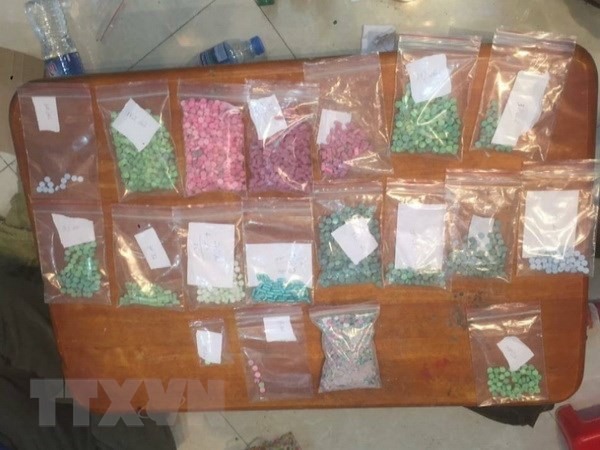 Authorities in central Thanh Hóa Province arrested a suspect who was caught illegally transporting drugs from the Việt Nam-Laos border area into the province, police said on Thursday. Nguyễn Ngọc Thành, 41, was caught in the act of transporting nearly 3kg of methamphetamine, over 5,800 pink meth pills, and nearly 40g of heroin from the border area between the provinces of Thanh Hóa and Hua Phan for sale in Thanh Hóa City. Thành said he was hired by an unknown man to transport the drugs in exchange for VNĐ50 million (US$2,200). The case is under further investigation. Vietnamese class opens for Vietnamese people in Russia 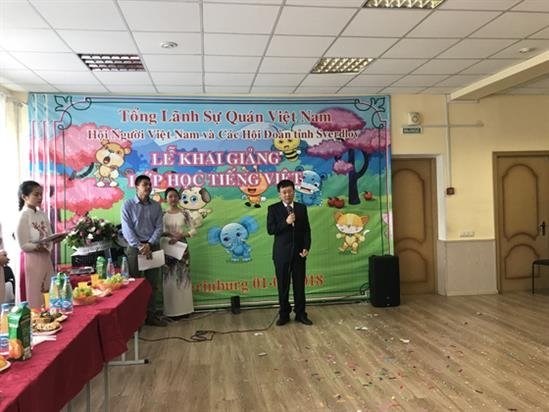 A Vietnamese language class opens for Vietnamese children in Russia.(Photo: nhandan.com) The Consulate General of Vietnam in Ekaterinburg, Russia and the Vietnamese people association in Sverdlovsk province recently opened a Vietnamese language class in Ekaterinburg city. In his opening remarks, Vietnamese Consul General Ngo Phuong Nghi lauded efforts made by the association in organising the class, which helps Vietnamese children in the host nation learn Vietnamese language. They will also have a deeper understanding about the country’s history and tradition, thus preserving national cultural characteristics, he noted. Meanwhile, Chairman of the association Le Thanh Do praised support from the Consulate General, benefactors and the Vietnamese community in organising the class. The opening ceremony also featured an art performance. 10 charged for online gambling 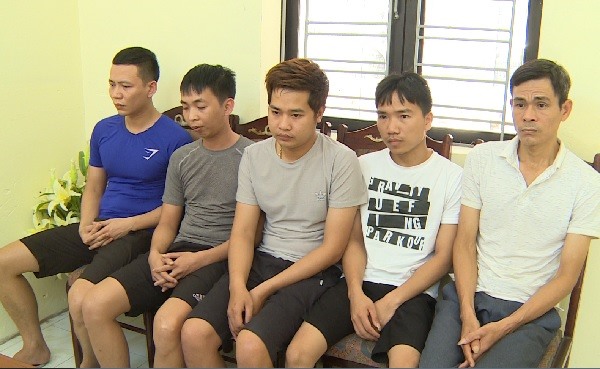 The defendants at a local police station. — Photo hungyentv.vn Police in northern Hưng Yên Province started legal proceedings against 10 defendants on Tuesday for their alleged involvement in an online gambling ring. The ring was worth more than VNĐ120 billion (US$5.3 million). Three of the defendants - Lê Quang Vinh, 31, who headed the ring; Trần Anh Dương, 22, and Nguyễn Mạnh Tùng, 22 - will be prosecuted for organising the gambling while the rest will be prosecuted for gambling. The ring was busted last month after local police checked 10 gambling points in Khoái Châu and Tiên Lữ districts. Police arrested 14 persons and seized nearly VNĐ400 million in cash, two cars, 15 mobile phones, three computers and other items. Initial investigation revealed that the defendants often used social networking sites, such as Zalo and Facebook, as well as mobile messages to organise gambling. They also used websites to join football betting games at regional and international levels. The case is under further investigation. Vietnam needs more effective urban land use  Many high-rise buildings are emerging in areas which were previously factories. As of 2017, Vietnam’s urbanisation rate was estimated at 36.6%, with more than 813 towns and cities throughout the country contributing more than 70% of economic output. Vietnam is among the countries with the fastest urbanisation rates in the region and the world, with around 700 square kilometres of land incorporated into towns and cities annually. Such figures show the importance of managing urban land resources effectively in sustainable urban development. However, experts said the efficiency of urban land use in Vietnam remains relatively low, as seen in the population density of 2,100 persons per square kilometre, compared with the regional average of 9,000. Large areas of urban land are left unused when many projects are discontinued or delayed, tens of thousands of semi-detached houses and villas are left deserted, and numerous residential tower blocks are not fully occupied, leading to billions of US dollars being untapped in these areas. The ineffective use of urban land, when a fair share of land and financial resources are earmarked for residential buildings, while little is allocated for social and transport infrastructure, has resulted in increased traffic congestion, flooding and pollution, which are also reasons why many new urban areas and satellite cities fail to attract residents. Urban land in old city centres is also used improperly and even arbitrarily, in favour of developers. Many high-rise buildings emerge in areas which were previously factories, while there is a serious lack of land for green areas, parks and schools, causing population density to rise rapidly, which runs counter to the policy of reducing the population in urban centres. Although there are already clearly drawn-up plans, local governments in some places have repeatedly failed to follow the plans, leaving new developments unconnected, reducing the efficiency of investment and impairing urban land use plans. Recently, the central government has promulgated many resolutions on land use plans but in order to enhance the effectiveness of land use management, stronger and more synchronised measures are needed. One of the top priorities should be concentrating financial and human resources to create detailed plans, currently accounting for just 35% of total master plans. The lack of detailed plans is a loophole for the arbitrary issuance of construction permits. At the same time, it is necessary to review the current plans to increase the ratio of land for social and urban infrastructure, and restrict the issuance of construction permits and land use permits for socially and economically inappropriate projects. Furthermore, the concerned authorities should step up oversight of urban land use and increase sanctions for violations in order to reduce unlicensed construction projects. Regulations and administrative procedures concerning construction in urban areas are also in need of revision. HCMC: Two massage spots violate regulations with naked stewardesses  Female hostess strippers serve guests. (Picture: DAN NGUYEN) The social and cultural patrol team number 2 in collaboration with the city's Police for Investigation of Crimes on Social Order (PC45) patroled the “sensitive business” centers last night. Surprisingly checked, two massage parlors in Tan Binh district, HCM City were discovered with dozen naked stewardesses bathed naked guests. Accordingly, at about 3 am of the same day, reconnaissance policemen and the group unexpectedly checked two massage spots: Linh Ha in Son Ky Ward and 181 (Ward 15) in Tan Binh District. Samsung Vina starts STEM Club in Da Nang 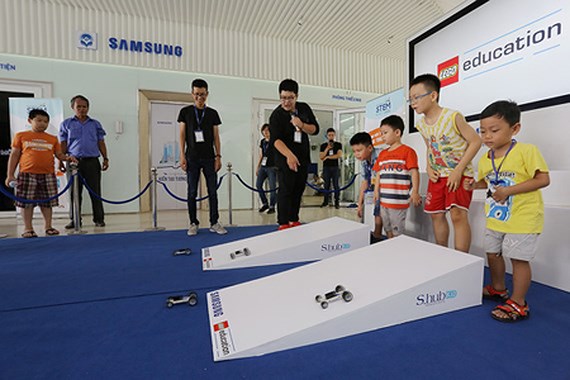 STEM education method is expected to deliver many positive values to pupils With the aim to promote the STEM (curriculum based on the idea of educating students in four specific disciplines — science, technology, engineering and mathematics) education method, Samsung Vina Electronics Co. Ltd. has launched STEM Club at S.hub Kids in the central city of Da Nang. After the grand opening ceremony was the conference ‘Happy summer time with STEM Club’, held on June 2-3, 2018 and attracting more than 500 pupils as well as parents living in Da Nang city. The conference will be held again on June 9-10, 2018. The conference successfully presented the significance of STEM education method, along with valuable information on technological thinking, computer science, and necessary skills for the 21st century via lively visual examples. Many trial STEM-robotics classes, where pupils themselves had a chance to practice programming and assembling robots by applying natural science knowledge were held. These activities are supposed to boost their creative thinking, interaction skills, team-working skills, while improving the skill to solve problems via careful observation and logical thinking. According to Communications Director of Samsung Vina Co. Ltd. Nguyen Tri Thong, with the aim of supporting education development, his company continuously had been seeking new content to show its responsibility to the society, and the introduction of the club this time had fulfilled that purpose. “We always wish that Vietnamese children could experience new education trends in the world so that their learning becomes more enjoyable and effective”, said Mr. Nguyen Tri Thong. In this June, the construction of STEM Academy for children in the Ho Chi Minh City General Science Library will also be launched. The area of 400m2 will be used for activities of technology, astronomy, STEM learning for the young, as well as a reading corner. Two new schools opened for rural communities 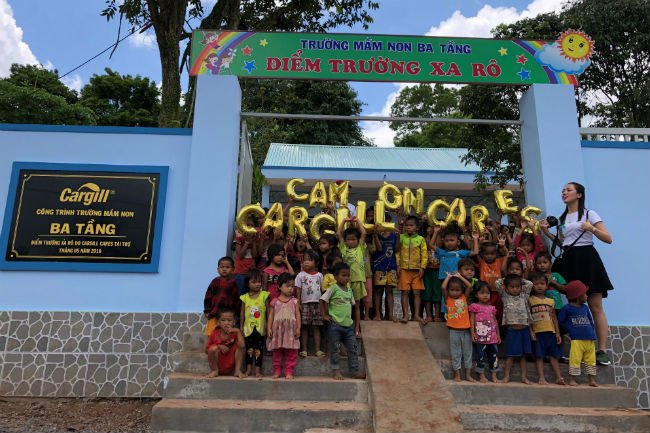 Students of Ba Tang Commune in Quang Tri Province pose in front of their new school To commemorate International Children’s Day, the feed producer Cargill has opened two kindergartens for children, one in Ba Tang Commune in Quang Tri Province and the other in Xuan Hong District of Nam Dinh Province. Ba Tang kindergarten is located in a mountainous area in the central province of Quang Tri, where both Kinh and Van Kieu ethnic people live together. Most of them are from low income families and work on banana plantations. The old school which was built many years ago was in a dilapidated condition and had to be shut down a few years ago. This forced the children of different ages to learn together in a temporary classroom located within a local’s house. The new kindergarten is the 87th one developed under the Cargill Cares school program, providing pre-school education in a safe, convenient and friendly environment for over 80 children. This newly built school has three classrooms, restrooms, a fence, a school yard, and also a water well to serve both the school and local households, satisfying their basic water and sanitation needs and relieving them of having to go far to fetch water from the stream for their daily consumption. Two weeks earlier, Cargill opened the 86th school named Xuan Hong Kindergarten in Nam Dinh Province. Inaugurated in late May, the school serves 180 children aged from two to five. The school has five classrooms, restrooms, gate and fence with total value of US$57,000. “We are excited to start the new fiscal year with the Cares school opening event and children’s day celebration. We are happy to serve the local community with a new and modern education infrastructure that promises to nurture the dreams and aspirations of the children and their parents for a better future,” said Stoney Su, Country Director of Cargill in Vietnam. Within 12 months of the last fiscal year, Cargill Cares in Vietnam built and handed over six new schools in six provinces, benefiting 1,000 children. On the same day of Ba Tang kindergarten inauguration, the Cargill Cares in Vietnam organized a memorable children’s day event for the local kids. The event featured various games, art balloons, clowns and a plentiful party run by Cargill Cares volunteers. The Cargill volunteers distributed new shoes, caps, school bags and toys to the students to help them better prepare for a new school year in September. Cargill’s school building program was initiated in 1997 to support students in agricultural communities in rural Vietnam. It is aimed at providing students access to quality education in a safe and conducive environment. The program is part of the Cargill Cares Council which is completely employee-led. Funds come from Cargill customers, partners and employees. Since 1997, around US$5 million has been raised to build schools that now provide quality education for more than 13,000 students across 46 provinces nationwide. Asia South East-Short Film Festival hits HCMC  The Asia South East-Short Film Festival was held at The Hive co-working space in HCMC’s District 2 last weekend, giving audience a chance to watch a wide variety of great short films that are produced from around the world. The festival was curated by Rod Fraser, who is also the festival director of two other international film festivals that take place in the UK including London-X4 Seasonal Short Film Festival and London-Worldwide Comedy Short Film Festival. During the two-day festival, the organizer screened all genres, from drama to action, horror, documentary, comedy and animation. Particularly, there were comedies from India, Korea and Japan, horror films from America and China, music videos from Vietnam and South Africa, documentaries from Myanmar and Canada, poetic dramas from France, India and Taiwan, amazing animation from Hungary and China, and a comedy horror film made by a nine-year-old boy from Australia. Many of these films are not in wide release or available outside of film festivals. “Since the dawn of Youtube, Facebook and cheap video camera technology there has been a real surge in independent filmmaking from every part of the world. It’s a very accessible art form now and I also love the fact that when you watch a short film you’re looking through the eyes of the filmmaker into a world that you might never actually get to see in real life,” said Rod Fraser. According to the curator, with a young, motivated and aspiring population, HCMC was a perfect place to host the short film festival. The Asia South East-Short Film Festival was previously held in Phnom Penh, Cambodia and will later visit Bali, Indonesia after HCMC. Hanoi proposes removing northern Thang Long – Noi Bai toll station Hanoi City has asked the Ministry of Transport to remove the Northern Thang Long – Noi Bai toll station as its fee collection is not used to reimburse investment capital for Vo Van Van Kiet Street in the capital city, but for the build-operate-transfer (BOT) road bypassing Vinh Yen City in Vinh Phuc Province, Lao Dong newspaper reports. That means residents, especially people living in Hanoi’s Soc Son District or passengers heading to Noi Bai International Airport, have to pay toll fees without using the bypass, arousing widespread disagreement among the city’s people. According to the written request sent to the ministry, most of the residents and enterprises have decried the toll fees at BOT stations as too high, affecting their business activities. Besides, drivers have to pay the toll fees in cash when going through the toll gates, causing traffic congestion and provoking widespread objection among vehicle users. The municipal authorities also propose the toll fees should be revised to ensure benefits for the State, investors, and road users as well, adding that collection at toll gates on crucial routes of the city should be automated in order to enhance traffic flows and efficiency. WHO & UNICEF call for full implementation of food decree  The World Health Organization (WHO) and UNICEF on June 7 called on the government and State agencies to implement Decree No. 09/2016/ND-CP, which mandates the fortification of salt, wheat flour and vegetable oil and the use of fortified salt and wheat flour by the food industry. The issuance of the decree was based on strong evidence that the country needs to step up efforts to address severe micronutrient deficiencies among the Vietnamese population. The decree is in line with global recommendations on this highly cost-effective strategy to prevent and control micronutrient deficiency and highlights the government’s commitment to improving the health of the population. WHO and UNICEF, however, noted that the decree has not yet been implemented more than two years after being adopted. This is despite the fact that food fortification, including the use of fortified food ingredients in processed foods, is already the global norm, with no detrimental impact upon the final food product or business profitability and sales. Food fortification contributes to a smart and healthy population, which benefits society and national development, including competitiveness. Iodine deficiency is a significant cause of intellectual disabilities in children and stillbirth and miscarriage in women. Vietnam is among a group of 19 countries still battling iodine deficiency. The Multiple Indicator Cluster Survey of 2011 indicated that only 45 per cent of households in Vietnam were consuming iodized salt, which is also far below the 90 per cent global recommendation on universal salt iodization. Nearly 30 per cent of children under 5 and 37 per cent of pregnant women are anemic. Zinc deficiencies are very high for children (69 per cent) and pregnant women (80 per cent). Iron deficiency increases the risk of maternal death and poor fetal development and impairs motoric and cognitive development in children and productivity among adults. Zinc deficiency increases the incidence of diarrhea, the risk of acute respiratory infection, and child mortality. Fortification of widely consumed staple foods and condiments such as salt, vegetable oil and wheat flour is a globally recognized and highly cost-effective strategy for increasing nutrient intakes without the need to change eating behaviors or outlay substantial government funds. Every dollar spent on salt iodization and flour fortification would result in benefits of more than $10. WHO recommends that all food-grade salt used in households and food processing be fortified with iodine as a safe and effective strategy for the prevention and control of iodine deficiency disorders. There is internationally-proven evidence that the use of iodized salt has no negative impact on the final product’s color, taste and smell. WHO also recommends the fortification of wheat flour when industrially-produced flour is regularly consumed by large population groups in a country. As a result, the fortification of salt, wheat flour, and vegetable oil is mandatory in 108, 85 and 29 countries, respectively, and 96 of the 108 countries that currently have mandatory legislation for edible salt iodization and all 85 countries that have mandatory wheat flour fortification include the requirement to use iodized salt in processed foods. The Vietnamese Government has acted positively to promote public health for the prevention and control of micronutrient deficiencies over the past two years and there is a need to continue. WHO and UNICEF strongly recommend the government fully implement Decree No. 09, including ensuring that processed foods are made with iodized salt and fortified wheat flour and that companies are supported to ensure compliance. Food producers and distributors should be supported by clear guiding regulations on compliance requirements and the use of fortified ingredients. In Vietnam, the main source of dietary salt and wheat flour intake comes from processed food and meals consumed outside the home. Thus, mandatory food fortification as regulated in Decree No. 09 is not detrimental to business and industry. Moreover, businesses can apply for exemptions in the rare cases when negative impacts on final products or sales are proven. An important note is that the mandatory fortification of salt, wheat flour and vegetable oil are channels of operationalization of the recent Communist Party Resolution No. 20/NQ-TW to improve people’s health. The enforcement of government regulations strengthens human capital in Vietnam and is in line with the UN Decade of Action on Nutrition. WHO and UNICEF stand as one behind the government in supporting the implementation of Decree No. 09 for the benefits of the entire country. Bridge proposed to be lifted to facilitate traffic 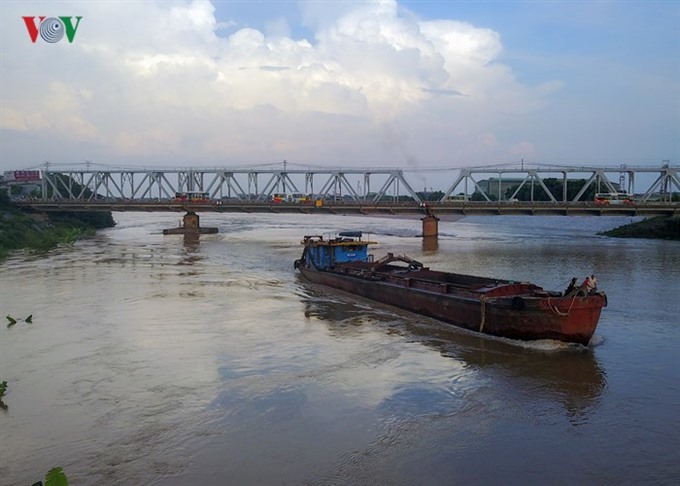 Some 200-250 vessels pass under the Đuống Bridge in Hà Nội every day. The vessels, with a load of more than 1,000 tonnes, usually have a limited range of vision, which poses risks to traffic on the bridge as well as its construction. — Photo vov.vn The Railway Projects Management Board has proposed the transport ministry to develop a project to lift Hà Nội’s Đuống Bridge to facilitate waterways traffic. The road-and-railway bridge across Đuống River has a vertical clearance of 2.5m, but according to a circular issued by the transport ministry in 2016, the bridge’s vertical clearance must be up to 9.5m to meet increasing waterways traffic and ensure traffic safety. A project to increase the bridge’s vertical clearance was introduced in 2008. Later, the ministry decided to merge the project with the Yên Viên-Ngọc Hồi urban railway project. But the project has been delayed with some land clearance work still pending. According to the Railway Projects Management Board, the vertical clearance of the bridge should be increased at the earliest and the work should be done independently. Some 200-250 vessels pass under the Đuống Bridge every day. The vessels, with a load of more than 1,000 tonnes, usually have a limited range of vision, which poses risks to traffic on the bridge as well as its construction. The risks are higher because of the strong and unpredictable water flow of the Đuống River in the bridge area. Phú Mỹ Hưng gifts public litter bins 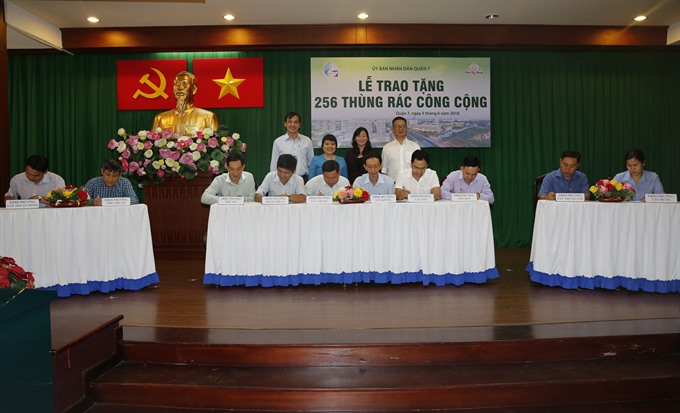 Officials in HCM City’s District 7 receive litter bins donated by the Phú Mỹ Hưng Development Corporation earlier this week. – Photo courtesy of Phú Mỹ Hưng. Phú Mỹ Hưng Development Corporation has donated 256 litter bins for public use to District 7 authorities. The urban developer said this was its contribution to the city’s plans to reduce pollution and install more litter bins and raise public awareness of keeping streets clean. The bins have a separate compartment for organic wastes. Lê Hoà Bình, chairman of the District 7 People’s Committee, said the district is working on plans to distribute the bins efficiently to enable people to use them. Nguyễn Thị Thanh Mỹ, deputy director of city Department of Natural Resources and Environment, commended the effort of Phú Mỹ Hưng Development Corporation and other companies in helping the city instal facilities such as public restrooms and garbage cans. She also hoped the businesses would continue to support the city in making the streets cleaner. VNN |
↧
Article 3
99-year land lease not regulated in draft law on special economic zones The draft Law on Special Administrative and Economic Units will not regulate the lease land of up to 99 years at special economic zones, the National Assembly (NA) Office said in its announcement released on June 9.
A corner of Phu Quoc Island This was agreed by the National Assembly Standing Committee and the Government after listening to opinions from economic experts, scientists, and the wide public, the NA Office said. Also on June 9, the Government Office released an announcement saying it had asked the NA to delay the approval of the bill to have more time for research and completion until the sixth meeting. According to the government office, the draft law has been carefully drafted to create the legal foundation for the establishment of three special economic zones, Van Don in the northern province of Quang Ninh, Bac Van Phong in the central province of Khanh Hoa, and Phu Quoc in the southern province of Kien Giang. "The bill had been proposed to legislators for the first time at the fourth session of the 14th National Assembly," the office said. "But after listening to opinions from economic experts, scientists, and the wide public, we've decided to delay the submission time to revise this draft law to ensure the success of these SEZs." Talking to the media on June 7 on the sidelines of the ongoing fifth session of the 14th National Assembly, PM Nguyen Xuan Phuc also said that he saw the need to reconsider the leasing time following opinions from the public. "We will propose reducing the leasing time to the National Assembly," Phuc told reporters. "But it is the NA who will decide on the exact time." Vietnam is planning to establish three special economic zones, Van Don in the northern province of Quang Ninh, Bac Van Phong in the central province of Khanh Hoa, and Phu Quoc in the southern province of Kien Giang. The Ministry of Planning and Investment estimates that the special economic zones will be able to bring a total of USD9.5 billion each year to the state coffers from tax payments and land related fees. Dtinews |
↧
↧
Article 2
BUSINESS IN BRIEF 11/6 Enterprises advised to know global trade policy 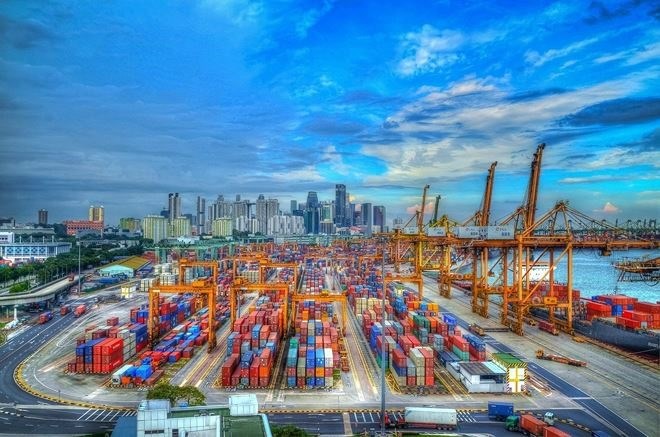 Firms are potentially missing out on key opportunities available beyond their immediate borders by focusing on trade policy developments on a regional scale, and showing lack of awareness when it comes to the broader global trade policy environment, according to an HSBC report. According to the report, a majority of businesses appear to be ignoring or undermining the impact of important policies on their operations. For companies in Vietnam, only 31 percent said the EU policy environment has had a positive impact on their business, while 66 percent saw no impact. The data was similar for the US policy environment (31 percent for the EU and 60 percent for the US), the two major markets for Vietnam’s exporters. Similarly, 74 percent of respondents said the North-American Free Trade Agreement (NAFTA) has had no impact on their business. A broad lack of awareness from businesses that have major trade and policy initiatives has put them at risk of missing out on significant international growth opportunities, according to the report. Although many firms, especially in the services sector, would consider expanding to new markets to grow their business, many could end up losing their competitive advantage if they do not recognise how trade policy is re-shaping the world’s supply chains, and where the best opportunities lie for them in the next few years, according to the HSBC report. The positive impact of initiatives that are ‘closer to home’, however, were more broadly recognised by the survey’s respondents. China’s Belt and Road Initiative and ASEAN 2025 policies received the greatest vote of confidence from business leaders, 59 percent and 56 percent, respectively, in the Asia-Pacific region. Seventy-four percent of companies in Vietnam said that ASEAN 2025 would have a positive impact on their business and 26 percent saw no impact. In addition, 50 percent of survey participants in Vietnam said the Comprehensive and Progressive Agreement for Trans-Pacific Partnership (CPTPP) was relevant to their business. Sixty-three percent of Vietnamese companies cited CPTPP as having a positive impact on their business, while 35 percent said there had been no impact. Meanwhile, 46 percent of firms in Asia-Pacific said the CPTPP trade deal was relevant for them and 48 percent expected it to have a positive impact on their business. Vu Tien Loc, Chairman of the Vietnam Chamber of Commerce and Industry (VCCI), said at a recent meeting that the CPTPP would be the backbone of international economic and trade commitments for Vietnamese businesses, despite some changes from its predecessor, the now-defunct Trans-Pacific Partnership (TPP) agreement. The CPTPP is considered a better option for Vietnam and 10 other partner countries, after the US departure from the TPP, he noted. Conducted by HSBC Commercial Banking, the report examined sentiment and expectations towards international trade in 26 countries and territories, including Vietnam, China, Hong Kong, India, the UAE, the UK and the US, among others. Vietinbank to issue 400,000 bonds in 2018 Viet Nam Bank for Industry and Trade (VietinBank) plans to issue 400,000 bonds worth VND10 million each to raise its capital by VND4 trillion (US$174.7 million). These will be non-convertible bonds unsecured by property. The scheduled date for issuance is June 28, and the deadline for registration and payment is from June 5 to 25. VietinBank plans to issue bonds to the public for a term of 10 years. After five years, VietinBank can exercise the right to buy back all the above bonds, as it is not allowed to buy a part of the bonds. The bond interest rate is floating and is determined by the reference interest rate (the 12-month saving deposit rate of Agribank, Vietcombank, BIDV and VietinBank) plus 0.8 per cent. This bonus interest rate is lower than the previous bond issuance (1.2 per cent). The proceeds are expected to supplement VietinBank’s operational capital and improve its financial capacity. Specifically, VND1.232 trillion will be used for medium- and long-term loans to enterprises operating in the field of electricity, VND893 billion for the electricity sector, VND591 billion for the water sector, VND475 billion for steel and VND220 billion for the wood industry. The remaining VND579 billion will be used for other businesses. Last year, VietinBank had two issuance bonds, which earned the bank VND4.2 trillion. MSMEs need Gov’t support to benefit from FTAs
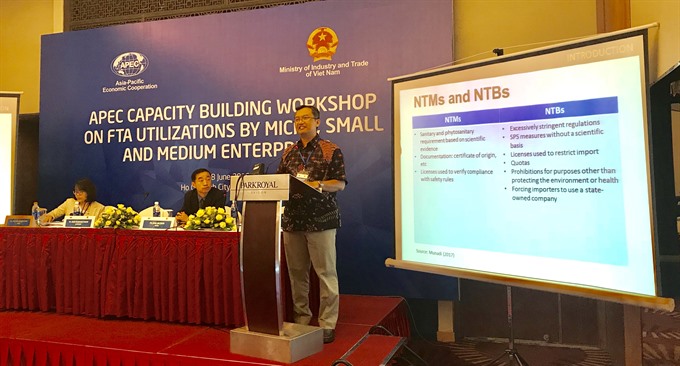 Trade facilitation, partnerships and capacity-building activities are needed for Micro, Small and Medium Enterprises (MSMEs) in APEC-member economies so they can take advantage of Free Trade Agreements (FTAs), speakers said at a workshop held on June 7 in HCM City. Pham Quynh Mai, deputy general director of the Ministry of Industry and Trade’s Multilateral Trade Policy Department, said MSMEs were the engines of growth and innovation in the APEC region. MSMEs account for over 97 per cent of all enterprises and employ over half of the workforce across APEC economies, she said. They contribute significantly to economic growth, with MSMEs’ share of GDP ranging from 20 per cent to 50 per cent in most APEC economies. However, only a limited percentage of MSMEs engage in overseas activities due to limited awareness of how to take advantage of FTAs and join regional and global supply chains, she added. In that context, one of the key pillars under an APEC initiative is improving knowledge sharing about trade facilitation, business support, partnerships, and capacity-building activities for MSMEs, according to Mai. MSMEs need to study inclusive business models, examples of successful export MSMEs, and lessons extracted from successful experiences in internationalisation and cooperation among economies. Viet Nam can benefit from its strategic geographical location in a dynamic Asia-Pacific region and its proximity to global manufacturing value chains, speakers said. Sixty-five per cent of the country’s population is under 35 years old, and there are also affordable labour costs as well as an emerging middle class. However, experts also warned that costs and risks of international integration could be significant for Vietnamese MSMEs, and as such, improving the overall business environment continues to be key. Viet Nam has committed to further institutional and structural reforms to help MSMEs, Mai said. Dr Rajan Sudesh Ratna, economic affairs officer at the UN’s Economic and Social Commission for Asia and the Pacific, said FTAs provided MSMEs with access to markets, creating value chains, bringing in FDI inflow and technologies, reducing trade costs, and enhancing linkages among industries. “FTAs also provide technical assistance, capacity building and assist FTA member economies in improving their overall capacity to benefit from trade, harmonising procedures and rules of different agreements among common economies,” he said. Regarding the Rule of Origin (ROO) in FTAs, Naoya Sumimoto, customs specialist at the Tokyo Kyoto Accounting Office, said the ROO identifies where the exported goods originated. “ROO is crucial to determine whether or not the exported goods are qualified for preferential tariffs under specific FTAs or Economic Partnership Agreements,” he said. The workshop also discussed trade in services, including issues such as market access, schedules of commitments, and most favoured nation (MFN) treatment in addition to intellectual property and competition. On June 8, the workshop will continue with a discussion about successful uses of FTAs by APEC member economies. The outcomes of the workshop will be reported to the APEC SME Working Group for consideration and will serve as input for the working group to develop action plans to facilitate MSMEs’ integration in global value chains. Last year, leaders of 21 APEC-member economies met in Da Nang to discuss ways to promote regional trade agreements and move towards the realisation of a Free Trade Area in the Asia-Pacific region. Protrade to make second share auction before shareholders’meeting Binh Duong Production and Trading Goods Corporation (Protrade) will make the second share sale prior to its first shareholders’ meeting expected in July, the company announced. Protrade will auction 32.9 million shares at the minimum bidding price of VND18,000 (US$0.79) per share, a 50 per cent higher than its starting price of VND12,000 per share in the initial public offering (IPO) on March 28. This is the number of shares that strategic investors refused to buy and not being sold out in the IPO. Under its equitisation plan, Protrade with a charter capital of VND3 trillion ($131.6 million), equivalent to 300 million shares, sold 30 million shares, a 10-per-cent stake, to the public in the IPO while selling 119.7 million shares, a 39.91 per cent capital, to strategic investors. However, the number of shares sold to strategic investors was 87 million shares while 200,000 shares were not sold out in the IPO. On May 7, Protrade put 29.8 million shares on trading on the Unlisted Public Company Market (UPCoM) at the initial price of VND17,400 per share. Protrade will hold its first annual shareholders’ meeting in July after the company completed the second share sale. Its share price rose after the announcement to VND17,500 per share on June 7 from VND16,900 apiece in the previous session. Protrade, formerly Song Be Rubber Enterprise 3-2, was established in 1982. At present, the corporation has expanded to nine subsidiaries and 10 associated companies, operating mainly in the sectors of rubber planting, wood processing, aquaculture, golf courses, industrial park infrastructure, garment and hospital. In its prospectus prior to IPO, Protrade reported total revenue of VND1.09 trillion in 2016, down 5 per cent year-on-year, and net profit of VND226 billion, up 6 per cent year-on-year. Its nine-month figures in 2017 were VND470.7 billion in revenue and VND317 billion in after-tax profit. Viettel links Myanmar with fast 4G Situated along National Highway No 1, on the left bank of the Ayeyarwaddy River, Thadon is a poor and underdeveloped village. But it has changed rapidly since the US lifted its embargo on Myanmar in late 2016, especially in terms of telecom links, with most of its residents using smartphones now. Yet if they wanted to access the internet on their phone, they had to travel 10km. Before Viettel Group began telecom operations in Myanmar, Thadon residents had used their smartphones only for calls and texts. There were three mobile phone service providers: the State-owned MPT, which has a 42 per cent share of the market, Telenor (Norway), which has 35 per cent, and Ooredoo (Qatar), which has 23 per cent. They have been trying to provide 3G services in recent years, but the quality is very poor due to their limited number of base transceiver stations. Everything has changed after Mytel (Viettel’s Myanmar company) appeared on the scene recently, and Thadon villagers no longer have to go to Thaton town 10km away to browse the net. Mytel is a joint venture between Viettel Global and two local partners, Star High Public Company and Myanmar National Telecom Holding Public. Holding a 4G mobile phone sim in his hand, Ar Kar Maung, a resident of Thadon, said it was brought to his house by Mytel staff. High technology, low prices and many promotions mean Maung and other Thadon villagers like the new brand. Maung said: “Mytel subscribers calling each other only pay half the rate charged by other networks. Mytel also offers more promotions if a new sim is bought, including 300 minutes of free calling within Mytel and 1.5 Gb valid for three months.” Considered Southeast Asia’s last frontier, Myanmar’s huge potential has attracted many leading regional and global investors. The International Monetary Fund (IMF) said Myanmar could quadruple its economy to US$200 billion by 2030. From having the second lowest mobile phone penetration rate in the world of 10 per cent, ahead of only North Korea, Myanmar has seen a stunning expansion to 90 per cent in just two years. To achieve a competitve advantage after becoming the latest entrant to the mobile telephony sector, Viettel has decided to deploy the most modern technologies. In its first year, Mytel plans to invest in infrastructure, setting up more than 7,000 4G base transceiver stations and over 30,000km of fibre-optic cable. When it formally launches operations on June 9, Mytel will be the only mobile network in Myanmar to provide 4G services nation-wide. Its 30,000km of fibre-optic cable means the company has twice the length as its closest competitor. Myanmar used to mostly depend on copper cables and supershort wave, with fibre-optic cables accounting for a small proportion of less than 1,000km per million population. This is a sustainable competitive advantage in the context of the strong development of new broadband mobile platforms. Besides technology, Viettel has also brought to Myanmar its unique sales philosophy: Mytel does not only have agents in cities and towns but also a mobile sales team which can travel to every household even in remote and mountainous areas. It is the only operator with this capability. Even before, its formal start of operations, thousands of Mytel staff have fanned out across the country taking sim cards and services to people living in every remote and mountainous hamlet. The company has said it targets signing up two to three million 4G customers this year. HCM City to host Mekong Beauty Show More than 200 Vietnamese and foreign cosmetics firms will showcase their new technologies and innovations at the 2nd Mekong Beauty Show in HCM City from June 14 to 16. The annual business-to-business beauty exhibition has established a platform for industry players in the entire supply chain covering beauty and cosmetics, hair and nails, herbal and health, and OEM and packaging, Joy Zou, international marketing manager of Informa Exhibitions, the organiser, said. The South Korean beauty industry would be the most important driver of the event, with 110 firms from that country exhibiting more than 400 brands, Zou told a press meeting on June 7. More than 150 buyers from Viet Nam, Cambodia, Laos and Myanmar are expected to visit the event to source products and seek new partnerships, she said. The three-day expo at the Saigon Exhibition & Convention Centre is expected to attract more than 12,000 visitors. Tran Quang Thang, director of the HCM City Institute of Economics and Management, said Viet Nam’s cosmetics industry with annual growth of 30 per cent offers enormous potential for foreign and local firms. The country’s middle class is set to become 33 million strong by 2020, and is looking for healthier and higher quality brands, he said. Seeing the huge potential of the beauty market, most premium foreign brands have entered the market and now dominate all categories of the industry, he said. But counterfeit beauty products have also flooded the market, with more than 50 per cent of products sold online being substandard or fake, he added. Bart Verheyen, commercial director of beauty, health and wellbeing retail chain MEDiCARE, said its number of stores would be expanded to 100 by the end of this year from the current 72 to meet the rising demand. The chain enjoyed growth of 30 per cent last year, he said. DHG to abolish FOL Lifting the foreign ownership limit (FOL) to 100 per cent in Hau Giang Pharmaceutical JSC (DHG) will open the doors for old and new investors to increase holdings in Vietnam’s biggest publicly-traded drug maker. According to information from the Ho Chi Minh City Stock Exchange (HSX), on June 7 DHG officially submitted the dossiers related to lifting its FOL to the State Securities Commission. Previously, DHG's extraordinary annual general shareholders’ meeting held in late July 2017 approved the motion to remove the FOL. On June 6, Taisho Group completed the purchase of 650,000 shares, or 0.5 per cent of the charter capital, to increase its holding in DHG to 24.95 per cent, equaling 32.606 million shares. After the deal, Taisho is the biggest foreign shareholder, followed by FTIF Templeton Frontier Markets Fund. State Capital Investment Corporation (SCIC) is the biggest stakeholder with 43.3 per cent. DHG will be the second Vietnamese pharmaceutical to remove the FOL, following the third-biggest listed domestic drug maker Domesco (DMC) in 2017. Foreign pharmaceutical groups see the FOL removal as a positive signal. A clear path in converting partnerships into majority ownership would provide companies with much stronger grounds to convince their global headquarters to invest in Vietnam. Right after DMC scrapped its FOL, US-based Abbott Laboratories increased its stake in the company to 51.7 per cent, boosting its footprint in the local pharmaceuticals market. SonKim Land joins development team of Metropole Thu Thiem Leading real estate developer SonKim Land Corporation, Quoc Loc Phat JSC (Quoc Loc Phat), and Joint Stock Commercial Bank for Foreign Trade of Vietnam (Vietcombank) have signed a strategic cooperation agreement and officially kicked off The Metropole Thu Thiem project in Thu Thiem New Urban Area (District 2, Ho Chi Minh City). This strategic cooperation agreement will contribute to maximising the strength of each party in implementing and developing the project. Notably, the project owner Quoc Loc Phat has the financial strength as well as investment capital from foreign shareholders. The authorities have approved all legal procedures, land allocation, project investment and Quoc Loc Phat has fulfilled all financial obligations for the land lots in the project. SonKim Land, with its experience in developing high-end real estate projects in Vietnam, is confident to successfully develop the project in accordance with the standards of a smart and high-class urban area. The Metropole Thu Thiem project consists of four land plots with a combined area of 7.6 hectares. The design of the project is inspired by the quintessential designs of Barangaroo (Sydney) and East Circular Quay (Sydney), integrated to suit the Vietnamese context and culture. Sales will be opened after finishing all necessary procedures. SonKim Land is a successful and reputable real estate developer in Vietnam, focusing on high-class and luxury projects such as Gateway Thao Dien, Serenity Sky Villas, and The Nassim. Seeking out strategic partnerships with global industry leaders like HongKong Land, Hamon Developments, and Bankinvest, SonKim Landaims to become a leading real estate investment and development company in Ho Chi Minh City. Bac Giang’s greater efforts to better business climate The northern province of Bac Giang will further its efforts to boost the local business environment. The northern province of Bac Giang will further its efforts to boost the local business environment by accelerating administrative reform and improving competitive capacity, said Chairman of the provincial People’s Committee Nguyen Van Linh. He said the goal is to enhance the province’s competitive capacity so it can enter the top 15 of the Provincial Competitiveness Index (PCI) by 2020. To facilitate local business, the province will hold regular meetings with enterprises to tackle their issues. The People’s Committees at district and city levels should prioritise land clearance to carry out important projects like Bac Giang-Lang Son expressway, Hanoi’s fourth ring road running through Bac Giang province and a road connecting provincial Road No 293 and My An port. Together with land clearance at Hoa Phu industrial park, the province has urged infrastructure developers at industrial zones to hasten the construction of technical infrastructure, particularly waste treatment systems. It will also work with FLC Group to study, survey and establish industrial parks in Yen Son and Bac Lung communes in Luc Nam district. Procedures required for local authority’s approval of Build-Transfer (BT) projects will be devised while key investment projects such as the inpatient treatment facility and medical gas pipeline system at Bac Giang General Hospital, a provincial gymnasium and the upgrade of Dong Son bridge and its approaching roads will be hastened. From January 1-May 10, the province approved 51 domestic investment projects with total registered capital of more than 695 billion VND (30.58 million USD), including 27 foreign direct investment (FDI) projects valued at 84 million USD. Compared to the same time last year, the number of domestic projects surged 37.8 percent and that of FDI projects increased 35 percent. Bac Giang is home to more than 1,420 operating projects, including 1,074 domestic projects and 348 FDI projects. More than 30 trillion VND (1.32 billion USD) in investment capital has been disbursed since 2016. As of the end of May, there were nearly 7,500 Vietnamese businesses with total registered capital of more than 48.6 trillion VND (2.14 billion USD) and 336 foreign-invested firms with total registered capital exceeding 3.1 billion USD in the province. Last year, the province’s PCI moved three steps to rank 30th out of 63 cities and provinces nationwide. MINISO to continue expanding The Vietnamese subsidiary of lifestyle and household item retailer MINISO has opened nearly 40 stores in Vietnam and plans to open a further 50 by the end of this year, according to a company statement. Mr. Ted Lan, General Manager of MINISO Vietnam, said there are currently 17 MINISO stores in Ho Chi Minh City, 19 in Hanoi, and four in other cities and provinces, all of which are performing handsomely. MINISO has adopted a strategy of developing around “north-south” key cities, centering on Ho Chi Minh City in the south and Hanoi in the north. With high quality and affordable prices as well as exquisite designs, most MINISO products are priced between VND43,000 ($1.90) and VND500,000 ($22) and have won favor from customers, most of whom are aged between 18 and 35. Within this age group, however, tastes and behaviors vary in different regions. Its largest consumer group is young women, Mr. Lan went on. Regardless of gender, however, most customers earn incomes in the medium to high bracket. They are keen shoppers, which is one of the major reasons Vietnam’s retail market has such great potential. With an influx of foreign investment and a rise in the number of shopping malls as well as local consumption habits changing from traditional street shopping to shopping malls, MINISO, keenly aware of these trends, has adjusted its expansion strategy in the country, moving from crowded neighborhoods to shopping malls and shopping centers. Last October, it reached a cooperative agreement with Vincom, Vietnam’s largest commercial real estate group, that paves the way for the brand’s future development in Vietnam’s major shopping malls. MINISO opened two stores last year, in AEON Long Bien and Vincom Times City, where sales have been very good. For its future development, MINISO has not only worked with Vincom but also with Vietnamese superstar Son Tung M-TP, as its brand spokesman. Son Tung M-TP is a well-known singer in Vietnam, with fans from 16 to 30 years old, which fits MINISO’s target group. His Facebook page has over 10 million fans, making him highly influential. The cooperation aims to build a positive brand image for MINISO among local consumers and broaden their awareness of the brand. Vietnam’s retail industry has major potential and there are new brands being introduced almost every day. Support from government policies, the rapid rise of the middle class, and the country’s relatively young demographics are among the factors contributing to the rapid growth of the retail market. The competitiveness of domestic retail brands, however, is relatively poor. There are many large-scale enterprises with large market shares in Vietnam’s retail market, such as Co.Op Mart, Vinmart, Fivimart, and SaigonCoop, but there are few brands similar to MINISO. Compared with these domestic brands, MINISO Vietnam’s advantages are clear. MINISO has a strong supply chain to support its operations. A 10,000 sq m sorting warehouse in Ho Chi Minh City is scheduled to be put into use in the middle of this year, which will provide strong support for digital operations and analysis as well as the logistics supply chain. MINISO also has its unique branded products, meeting the consumption habits of local consumers and catering to the taste of the masses. At the same time, it does its best so that consumers love and rely on its products. MINOSO’s development in the global market over recent years has been eye-catching. It has opened more than 2,600 stores worldwide, in 62 countries and territories, including the US, Australia, Canada, South Korea, Japan, China, and Indonesia. Turnover in 2017 reached $1.8 billion; double the figure in 2015. With high growth, MINISO opens 80-100 stores around the world every month. It is expected to have 10,000 worldwide by 2022, of which 400 will be in Vietnam. What does HSC expect from loss-making Vinasun? While GIC Private Limited cut its losses in Vinasun last week, Ho Chi Minh City Securities Corporation (HSC) spends around VND100 billion ($4.4 million) becoming the third largest shareholder of Vinasun. HSC has just announced buying 7.2 million shares of Vietnam Sun Corporation (Vinasun, code: VNS), equalling 10.61 per cent. It held only 8 VNS shares before. The transaction took place on May 25, when GIC Private Limited sold a total of 5.4 million VNS shares on the Ho Chi Minh City Stock Exchange (HSX). This Singaporean investment fund fully divested Vinasun at only 40 per cent of the original purchasing price, losing approximately VND120 billion ($5.3 million) in four years. At the average price of VND14,000 apiece, HSC is estimated to spend over VND100 billion ($4.4 million) becoming a large shareholder of Vinasun. After this “low-cost” transaction, HSC became the third largest shareholder of Vinasun, behind chairman Dang Phuoc Thanh and his family (35 per cent) and Singaporean investment fund TAEL Two Partners Ltd. (18.3 per cent). As a securities corporation, HSC’s investment may be based on the expectation of recovering VNS after it hits rock bottom. However, HSC may be an intermediate unit of another investor. HSC’s investment came as the taxi firm slipped into the red and its stock fell sharply. From the VND36,000 height in 2014, VNS has dropped to around VND14,000, losing 60 per cent of its share value. In 2018, Vinasun approved lower business targets for the fourth consecutive year, with VND2.16 trillion ($95.2 million) in revenue, down VND1.07 trillion ($47 million) compared to the actual revenue from last year. Net revenue from taxi services and franchising is expected at VND2 trillion ($88 million), and the remaining revenue will come from the liquidation of assets. The sharply reduced targets are due to the competition with ride-hailing services, in light of which Vinasun also forecast after-tax profit to halve against last year, falling to VND95 billion ($4.2 million), the lowest over the last nine years. HCM City ranks first in FDI attraction in five months Ho Chi Minh City was the most attractive destination in FDI attraction in the first five months of this year, with 2.39 billion USD, or 24.2 percent of total investment in the period, according to the Foreign Investment Agency under the Ministry of Planning and Investment. The northern port city of Hai Phong ranked second with 1.07 billion USD, accounting for 10.8 percent and followed by Hanoi with 835.3 million USD, or 8.4 percent. The agency reported that in the first five months of this year, 53 cities and provinces in the country attracted 9.9 billion USD of FDI, equivalent to 81.6 percent of that in the same period last year. Of which, the processing and manufacturing industry lured 5.18 billion USD, or 52.3 percent, while real estate enjoyed 1.07 billion USD, and retail and wholesale sector attracted 1.02 billion USD. Notably, LG Innotek added 501 million USD to its factory in Hai Phong, raising total investment in the project to 1.05 billion USD, while Regina Miracle International Vietnam injected an additional 260 million USD to its sportswear factory. Economists said that the increase of investment in projects in equipment and garment will bring more opportunities for domestic enterprises to learn from FDI firms and take advantage of their strengths. This is also what Vietnamese businesses need to do to enhance their competitiveness and engage deeper into global supply chains. So far this year, 86 countries and territories have invested in Vietnam, led by the Republic of Korea with 2.63 billion USD, accounting for 26.5 percent of total FDI, followed by Japan with 1.52 billion USD and Singapore with 1.11 billion USD. Vietnam’s exports to Japan exceed US$5.7 billion in 4 months Total trade between Vietnam and Japan hit US$11.41 billion in the first four months of this year, a -year-on-year rise of 13.2%, including US$5.75 billion from Vietnam’s exports to Japan (up 14.5%) and US$5.66 billion from its imports (up 11.9%). According to the General Department of Vietnam Customs, Japan has been in top four of more than 200 trading partners of Vietnam over the years. In 2017, two-way trade turnover increased 13.8% to US$33.84 billion against the previous year with Vietnam’s exports of US$16.86 billion, making up 7.8% of the country’s total exports. Key export products to Japan include garment, means of transport, machines, equipment, tools and spare parts, seafood, wood and timber products. Meanwhile, Japanese businesses shipped US$16.98 billion worth of products to Vietnam (up 12.7%), accounting for 8% of Vietnam’s total imports last year. US – major export market of southern Dong Nai province The US is the largest export market for the southern province of Dong Nai, accounting for nearly 30% of the province’s total export value, according to the provincial Department of Industry and Trade. Businesses in the southern province of Dong Nai have exported more than US$1.5 billion worth of products to the US since early this year, a year-on-year rise of 10%, with key products such as wood, bags, suitcases, hats, steel, coffee, pepper and seafood. Products with huge export values like footwear and garments grew by 4-10% against the same period last year. However, the Ministry of Industry and Trade says the US legal system imposes many strict regulations on imported goods. In addition to common criteria, each state has its own regulations. Therefore, if Vietnamese businesses want to ship their products to the US, they must research the laws and regulations of individual states as well as the country. Besides, the US will continue to protect its domestic goods by issuing new regulations on the quality and origin of products, particularly for agroforestry and seafood products, which causes a number of difficulties for goods exported from Dong Nai and for the whole country as well. To avoid an overdependence on certain big markets, businesses in Dong Nai province are finding ways to expand to new markets, especially the countries Vietnam has signed free trade agreements with, to improve their competitiveness. Duong Minh Dung, director of the provincial Department of Industry and Trade, says the province helps businesses keep traditional markets and supports them in market expansion to reduce risks due to an overdependence on certain markets. Dong Nai has exported goods to 171 countries and territories around the world, including big markets such as the US, the Republic of Korea, Japan, China and Europe. Mekong Beauty Show attracts numerous South Korean enterprises An international beauty and cosmetics expo named Mekong Beauty Show 2018 will kick off on June 14 at Saigon Exhibition and Convention Center (SECC) in HCMC’s District 7, luring the participation of over 200 companies, with more than half being South Korean enterprises. The three-day event was announced at a press meeting on June 7 in the city by the organizers comprising Vietnam National Trade Fair and Advertising Company (VINEXAD), Informa Exhibitions, and the Korea Exhibition Center (Kintex). Dominic Oh, general director of South Korean firm Kintex, said that more than 110 South Korean beauty and cosmetics firms would participate in the show in search of potential importers and business opportunities in the Vietnamese market, adding that 400 brands will be featured at K-Beauty pavilion. Oh stated that Vietnam is considered as one of the key markets for Korean beauty and cosmetics operators, and many South Korean companies highly evaluated Vietnam as a thriving market on their business trips to this country last year. Notably, Vietnamese youth has increasing demand for purchasing South Korean cosmetics. Besides, many corporations from such countries as Italy, Russia, Malaysia, and Thailand have put their names down for the beauty show for the first time, while others from Japan, Taiwan, and mainland China among others would also revisit the event to further tap the country’s high-potential beauty industry. A wide range of latest advanced technologies in the beauty sector, spa equipment, and healthcare products will be displayed at around 250 booths at the event. Import-export turnover of the local cosmetics sector last year reached nearly US$6 billion, or twice bigger than that a year earlier, but exports attained only some US$500 million, said Nguyen Van Minh, vice chairman of Vietnam Essential Oil Association. Moreover, surging demand for high-end cosmetics items has paved the way for foreign operators to join the local market. Long An BOT road toll collection set to start in mid-June Toll collection on Provincial Road DT 830 in Long An Province, the first build-operate-transfer (BOT) infrastructure project in the Mekong Delta province, will begin in mid-June, said Pham Van Cuong, director of Bang Duong Investment-Construction-Trading Co Ltd. Cuong said at a press conference held in Long An Province on June 7 that the date for kicking off toll collection remained undecided. Long An Province Department of Transport director Nguyen Van Hoc said toll fees would range from VND25,000 to VND165,000 per time, from VND750,000 to VND4.95 million per month and from VND2.02 million to VND13.36 million per quarter. A toll exemption will be extended to certain road users in accordance with Clause 3 of Article 1 in the province’s Decision 13/2018/QD-UBND dated April 1, 2018, Hoc said. The developers of the project have added residents and enterprises in An Thanh, Luong Hoa, Luong Binh and Tan Hoa communes in Ben Luc District, and in Huu Thanh Commune in Duc Hoa District to the list of those enjoying toll exemption or reduction. Particularly, vehicles of companies headquartered in areas between Ben Luc and Duc Hoa toll stations will get a 20% discount on monthly or quarterly tickets while public vehicles like commuter buses will pay VND25,000 per trip, VND375,000 per month or VND1.012 per quarter. Meanwhile, passenger vehicles of below 31 seats owned by local residents will be exempted from tolls. Toll collection is slated to last 19 years. DT 830 BOT project is jointly developed by Bang Duong Investment-Construction-Trading Co Ltd and Bamboo Capital Group at a total cost of more than VND1 trillion. VNN |
↧
Article 1
Social News 11/6 (hourly updated) Friendly exchange held to mark Sweden’s Mid-summer Day 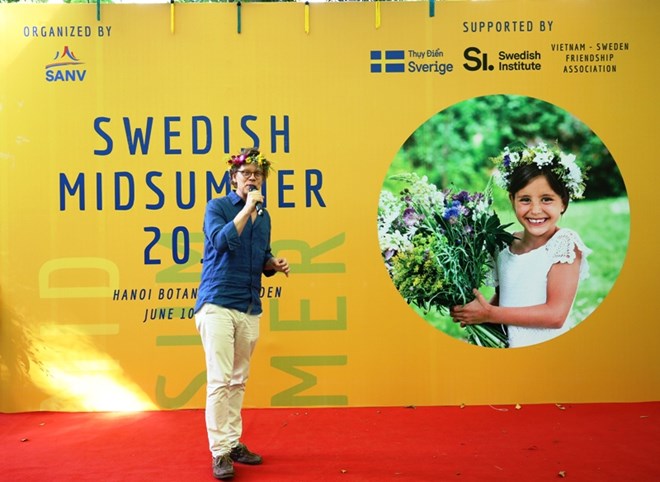 Swedish Ambassador to Vietnam Pereric Högberg at the friendship exchange to mark Sweden’s Mid-summer Day (Photo: dangcongsan.vn) A friendship exchange was held in Hanoi on June 10 by the Vietnam-Sweden Friendship Association, the Swedish Embassy in Vietnam and the Sweden Alumni Association on the occasion of Sweden’s Mid-summer Day. Vice Chairman of the Vietnam-Sweden Friendship Association Dinh Tich said the event aimed to give Vietnamese a chance to learn about one of the most important festivals of the Scandinavian country. He expressed the hope that the event will also help enhance the cooperation between his association and the Swedish Embassy in Vietnam. The Vice Chairman announced that the Vietnam-Sweden Friendship Association will collaborate with the Swedish Embassy in Vietnam and the Sweden Alumni Association to hold activities to celebrate the 50th anniversary of Vietnam-Sweden diplomatic ties in 2019. Swedish Ambassador to Vietnam said Midsummer Day is the most anticipated festival for Swedish people. On the occasion, people don traditional costumes and gather to sing and dance, and join in traditional games. Sweden was the first Western European nation to set up relations with Vietnam. It is now Vietnam’s important economic partner in North Europe with annual two-way trade revenue exceeding 1.2 billion USD. In the first nine months of this year, the figure stood at more than 1 billion USD, up 16 percent year-on-year. Thanh Ha litchi festival opens in Hai Duong 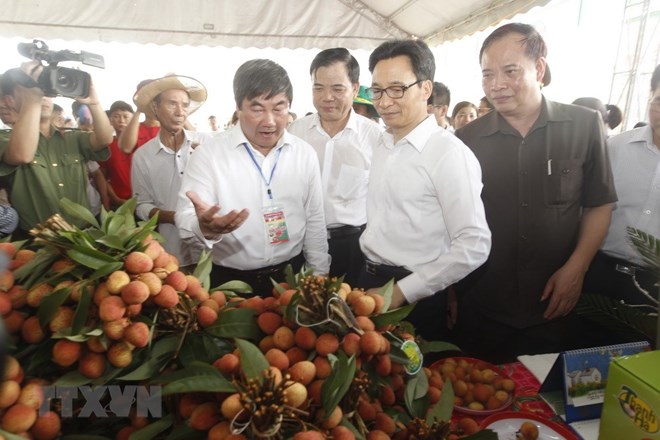 Deputy PM Vu Duc Dam (second, left) at the festival The first-ever Thanh Ha litchi festival opened in the northern province of Hai Duong on June 10 to promote the local specialty fruit. The festival also aims to connect farmers with supermarkets and trade centres, and processing and export firms nationwide. Addressing the event, Deputy Prime Minister Vu Duc Dam said Vietnamese litchi has been put on shelves in many choosy markets, stressing the need to pay more attention to applying cutting-edge technologies and scientific and technological advances in caring, processing and preserving the fruit. He also reminded State management agencies to help farmers promote the image and values of litchi. Apart from litchi production and trade promotion, Hai Duong province in general and Thanh Ha district in particular should heed cultural and tourism development, especially ecological tourism, the official suggested. Minister of Agriculture and Rural Development Nguyen Xuan Cuong said the festival offers an opportunity to honour the local specialty fruit, farmers as well as Vietnam’s agriculture-based economy. According to Nguyen Duong Thai, Chairman of the provincial People’s Committee, ancient documents proved that litchi was grown in Thanh Ha about 200-300 years ago. In 2018, Hai Duong has about 10,500 ha of litchi, mostly in Thanh Ha district and Chi Linh town, which are expected to yield about 60,000 tonnes. Of the total amount, some 1,000 tonnes is qualified for export to the US, Australia and the EU, he said. Within the framework of the festival, Deputy PM Dam and other delegates cut the ribbon to mark the departure of three containers of litchi to the processing zone of ABA Solution and Trade JSC in Me Linh, Hanoi, to export to the US. An array of activities will be held during the festival, including tours to the ancient litchi tree in Thuy Lam village in Thanh Son commune, Thanh Ha district; visits to VietGAP litchi gardens; and boat tours to litchi orchards along Huong river, among others. Visitors can also try their hand at picking litchi in gardens in Thanh Ha district and Chi Linh town. Hai Duong litchi received the geographical indication from the Ministry of Science and Technology’s National Office of Intellectual Property in 2007. The local fruit was listed in the top 10 quality products in 2013 and 2014 and received the Gold Brand prize in 2015. The Vietnam Association of Food Science and Technology granted a “trustful and safe food brand” certificate to Thanh Ha litchi in 2016. The same year, the ancient litchi tree in Thuy Lam village was recognised as the oldest of its kind in Vietnam. Besides the domestic market, Thanh Ha litchi has increased its presence outside the country. The fruit has been exported to Australia, Canada, China, France, Malaysia, the Philippines, Singapore, Sweden, Thailand, the United Arab Emirates and the United States. Swedish ambassador highly values quality of Thanh Ha litchi 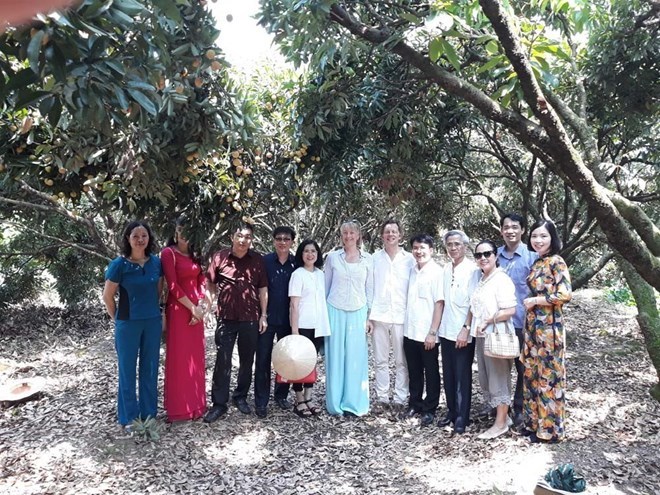 Swedish Ambassador to Vietnam Pereric Hogberg and his wife visited Thanh Ha district, the northern province of Hai Duong on June 9 on the occasion of the first-ever Thanh Ha “thieu” litchi festival 2018. Swedish Ambassador to Vietnam Pereric Hogberg and his wife visited Thanh Ha district, the northern province of Hai Duong on June 9 on the occasion of the first-ever Thanh Ha “thieu” litchi festival 2018. Here, the couple had a chance to experience litchi harvesting at a VietGAP garden in Thanh Xa commune and contemplate the ancient litchi tree in Thanh Son commune. At a working session with the local leaders, the ambassador said he pays special attention to the trading of litchi products and wants to bring them to the Swedish market. Secretary of the Party Committee of Thanh Ha district Nguyen Duc Tuan expressed his wish that Ambassador Pereric Hogberg will support the locality in bringing its specialty fruit to Sweden and Europe in general. After visiting the VietGAP litchi orchard and the ancient litchi tree, and enjoying Thanh Ha ‘thieu” litchi, the Swedish diplomat appreciated the quality of the local fruit as well as the VietGAP production process. He said that there is great potential for Thanh Ha “thieu” litchi to enter international markets. Thanh Ha district has about 4,000 ha of litchi, including 3,000 ha of ‘thieu” litchi, expected to produce 35,000 tonnes this year. Thanh Ha “thieu” litchi received the geographical indication from the Ministry of Science and Technology’s National Office of Intellectual Property in 2007. The local fruit was listed in the top 10 quality products in 2013 and 2014 and received the Gold Brand prize in 2015. The Vietnam Association of Food Science and Technology granted a “trustful and safe food brand” certificate to Thanh Ha litchi in 2016. The same year, the ancient litchi tree in Thuy Lam village was recognised as the oldest of its kind in Vietnam. Besides the domestic market, Thanh Ha litchi has increased its presence outside the country. The fruit has been exported to Australia, Canada, China, France, Malaysia, the Philippines, Singapore, Sweden, Thailand, the United Arab Emirates and the United States. The Thanh Ha “thieu” litchi festival opened on June 10, with an array of activities such as tours to the ancient litchi tree in Thuy Lam village in Thanh Son commune, Thanh Ha district; visits to VietGAP litchi gardens; and boat tours to litchi orchards along Huong river, among others. Visitors can also try their hand at picking litchi in gardens in Thanh Ha district and Chi Linh town. VTV intensifies cooperation with Cuban partners 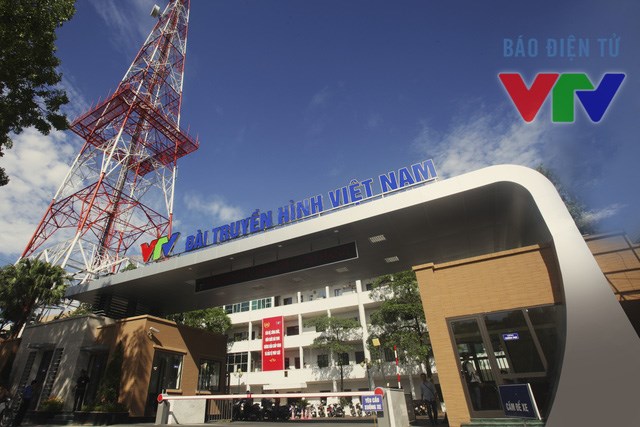 The Vietnam Television (VTV) and the Cuban Institute of Radio and Television (ICRT) will exchange television products. (Photo: vtv.vn) The Vietnam Television (VTV) and the Cuban Institute of Radio and Television (ICRT) will exchange television products and join hands in production as well as personnel training, especially in the field of digital television in the next three years. An agreement to this effect was signed by VTV General Director Tran Binh Minh and ICRT President Alfonson Noya Martinez during their talks in Cuba as part of the former’s visit to the Caribbean country from June 6-10. Minh expressed his gratitude to Cuban colleagues and teachers for their support for VTV in its early days, saying his agency is willing to share its experience in developing the self-control mechanism at a national television with the Cuban institute frankly and wholeheartedly. VTV will also assist Cuban film delegations to Vietnam in making films on leader Fidel Castro’s historic visit to Vietnam 45 years ago (September 1973), and stands ready to expand cooperation in this field. For his part, Alfonson Noya described Vietnam and VTV in particular as a model which overcomes difficulties to develop. In an interview with a Vietnam News Agency correspondent, Alfonso Noya said Vietnam’s experience in audiovisual technologies would be valuable for Cuba. He said he believes that there are many areas for experience sharing between Vietnam and Cuba, thus helping the two nations to enrich their cultural knowledge and promote mutual understanding. At a working session with representatives of the Cuban Ministry of Culture and the Institute of Cinematographic Art and Industry of Cuba (ICAIC), Minh called on the Cuban side to support VTV correspondents in making documentaries on Cuba’s culture. In response, VTV will provide support and documents that the Cuban side needs, he promised. On this occasion, ICAIC Vice President Benigno Iglesias and head of the VTV International Cooperation Department Ho Kien signed an agreement on free-of-charge exchange of audiovisual products. Under the agreement, the ICAIC will hand over the first batch of six documentaries on Vietnam by late director Sangtiago Alvarez, 71 news on the anti-US war in Vietnam produced by the institute between 1960-1990, and two other documentaries by director Isabel Santos to VTV. While in Cuba, Minh and his entourage attended the International Convention of Radio and Television Cuba from June 7-9. Vietnamese culture promoted in Cuba  An art performance at the event Vietnamese landscapes and culture have been introduced to Cuban friends at an annual gala night recently held by the Ho Chi Minh Communist Youth Union’s chapter in the country. With ten performances staged by Vietnamese students in Cuba, the Alma Vietnam 2018 featured the natural beauty of the Southeast Asian nation in four seasons of a year as well as its unique culture with special festivals. This year’s event also saw the participation of Cuban artists. The highlight of the programme was a strong commitment by Vietnamese youth union members to upholding the national traditions. First held in 2015, the annual programme has helped intensify the solidarity among Vietnamese students in the Caribbean country. Tra Vinh spends $88,000 per year for Khmer language teaching 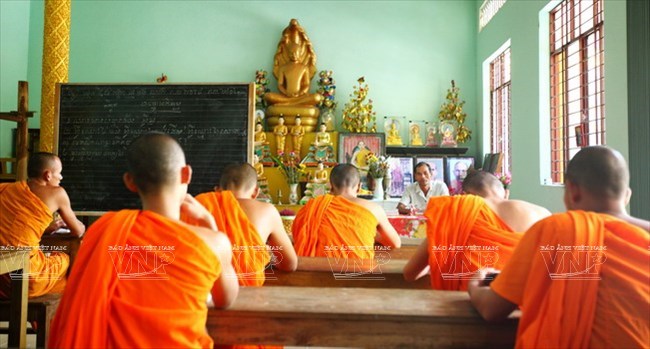 A Khmer class for monks in a pagoda of Tra Vinh The Mekong Delta province of Tra Vinh has spent over 2 billion VND (88,000 USD) each year to support the teaching and studying of the language of the Khmer ethnic minority group in 134 Khmer pagodas across the locality in the 2010-2017 period. According to the provincial Department of Education and Training, the investment is part of the province’s efforts to realise the Government’s Decree 82/2010/ND-CP dated July 15, 2010 on policies on teaching and studying of languages of ethnic minority groups. Pagodas in Tra Vinh welcome about 2,000 school students who come to learn to read and write Khmer language in every summer. Nearly 200 teachers and monks are now paid to teach the students. Tra Vinh currently has 8 boarding schools for ethnic students, along with 121 primary and secondary schools and 8 Pali-Khmer schools that teach Khmer language with about total 19,000 students. The province has delivered 123,000 textbooks to students at total cost of 1.5 billion VND, while presenting 7,700 scholarships to ethnic students. Tra Vinh has sent 307 students to educational facilities for training, while focusing on improving capacity of management officials. The locality now has 2,200 Khmer officials and teachers, of whom 126 are taking post-graduate courses. 100 outstanding blood donors honoured  The ceremony in Hanoi on June 9 honours 100 blood donors from localities across the country A ceremony was held in Hanoi on June 9 to honour 100 outstanding blood donors from 63 cities and provinces nationwide and six ministries and sectors. Of the donors, the oldest is Vo Ngoc Viet, a 61-year-old man from the Mekong Delta province of Long An, and the youngest, Dam Quang Tuan from northern Thai Nguyen province and Nguyen Van Trung from Hanoi, are only 23 years old. Two of the donors have donated their blood for 64 times, 10 have made donations for 51-63 times, 3 for 41-50 times, 8 for 31-40 times and 70 for 8-30 times. Particularly, one donor has the rare blood type O (Rh-). The 100 figures, one-fourth are members and volunteers of the Red Cross Society, are also honoured for their efforts in encouraging up to 2,000 others to join blood donation. Addressing the ceremony, Vice Chairman of the National Assembly Uong Chu Luu described the blood donors as the brightest flowers in a garden of humanity. He said that he hopes the honoured donors will continue acting as key factors in blood donation, helping attract more people to join the movement. He lauded the National Steering Committee for Voluntary Blood Donation’s efforts in organising activities to recognise the great deeds of the donors, asking the committee to advise the Party, State and Government to give more resources to communications on blood donation, thus raising public awareness and encouraging good deeds in the field. President of the Vietnam Red Cross Society and head of the Standing Board of the National Steering Committee for Voluntary Blood Donation Nguyen Thi Xuan Thu showed gratitude towards all blood donors across the country, who she described as “heroes of patients”. She called on the community to join in donating blood as the activity is not harmful to their heath but can save the lives of many people. Since 2004, June 14 was chosen as the World Blood Donor Day. This is a chance to commemorate the birthday of Austrian American scientist Karl Landsteiner who discovered the rare blood type ABO in 1901 for which he received a Nobel Prize in Physiology or Medicine. This year, the event is themed “Be there for someone else. Give blood. Share life”. VOV steps up radio broadcast cooperation with Cuban partner 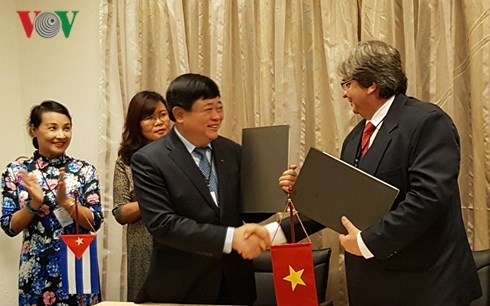 General Director Nguyen The Ky (L) and Alfonso Noya Martinez, President of the Cuban Institute of Radio and Television at the signing ceremony A Voice of Vietnam (VOV) delegation, led by its General Director Nguyen The Ky has been on a visit to Cuba from June 6 – 9 to strengthen bilateral cooperation in radio broadcast. During the visit, Ky attended and delivered a speech at a seminar on historical memory and cultural heritage of the International Convention of Radio and Television in Varadero from June 7-9. He and Alfonso Noya Martinez, President of the Cuban Institute of Radio and Television (ICRT), signed a cooperation agreement, during the framework of the International Convention of Radio and Television. The sides inked their first cooperation pact in 2013. Their new deal was said to add new terms and contents, including the exchange of programmes on politics, economics, social affairs and culture, joint work in reporter training, exchange of high-ranking leaders, and joint production of radio and television programmes. After the signing ceremony, the VOV and ICRT leaders began their discussion. They stressed their determination to realise the agreement via regular liaison, and to drive their collaboration toward effectiveness in contribution to Vietnam – Cuba relations. Attending the signing ceremony and discussion, Vietnamese Ambassador to Cuba Nguyen Trung Thanh said the pact will build on outcomes of Party General Secretary Nguyen Phu Trong’s March visit to Cuba in promoting Vietnam – Cuba trust and comprehensive cooperation. Talking to Vietnam News Agency, Ky said the freshly signed agreement with the ICRT is more practical to both parties involved. Micronesian top legislator visits Hai Phong 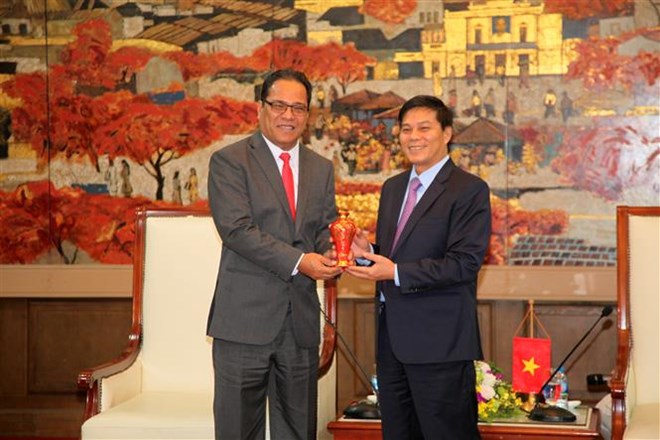 Micronesian Speaker of the Congress Wesley W. Simina (L) and Chairman of the People’s Committee of Hai Phong Nguyen Van Tung Visiting Micronesian Speaker of the Congress Wesley W. Simina expressed his wish to learn experience from the northern city of Hai Phong in boosting industrial growth, during a working session with municipal leaders in the city on June 9. Chairman of the People’s Committee of Hai Phong Nguyen Van Tung introduced the potential and strengths of the over 100-year-old port city with more than 2 million people and per capita income of 3,500 USD per year. The spearhead industry of Hai Phong is port, shipbuilding, and services. Total goods handled by the port expand 15 percent per year averagely, reaching 41.9 million tonnes in the first five months of this year, up 17 percent over the same period last year, noted Tung. He said he hopes the Federated States of Micronesia will strengthen cooperation with Hai Phong in maritime economy, especially shipbuilding, sea medical development, and wastewater treatment. The two sides should exchange delegation, while sharing experience and design specific and efficient cooperation programmes, Tung said. The same day, the Federated States of Micronesia delegation also visited Pharung Shipyard Company in Minh Duc town, Thuy Nguyen district, and toured the Bach Dang Giang historical relic site. Vietnamese traders lose $0.5 million to Russia trade centre blaze  Firefighters at the site Vietnamese traders at a trade centre in Russia’s Kazan city may lose about 31 million rubles (about 0.5 million USD) to a recent blaze there, according to the Vietnamese Association in Kazan. The blaze in Port trade centre in Orenburg street of Kazan city happened on June 5, destroying three buildings and 2,000 kiosks with total affected areas hitting 2,800 square metres. It was distinguished after seven hours with efforts of over 300 people. No deaths were reported, but property loss was big. According to the association, more than a haft of 70 kiosks owned by 31 Vietnamese business households in the centre was completely destroyed, while the rest were seriously affected by trash and smoke that damaged all goods stored there. Doan Danh Lam, President of the association said that on June 6, the owner of the centre, Bulat Nagaev, pledged to restore the damaged buildings in two months, while arranging spaces for the affected kiosk owners and supporting them with one-month rent. Executive board of the association had a meeting on June 7 and decided to launch a charity campaign to support the Vietnamese households suffered from the accident. At the same time, Altyn trade centre’s management board has offered free two-month rent to the Vietnamese people if they wish to move their kiosks to this centre. Counsellor Nguyen Quynh Mai from the Vietnamese Embassy in Russia said that the embassy has kept regular contact with the Vietnamese Association in Kazan and local authorized agencies to seek measures to protect the right and interest of the affected Vietnamese business households and make a plan to call for assistance from the Vietnamese community in Russia. RoK supports Quang Tri with social welfare programmes 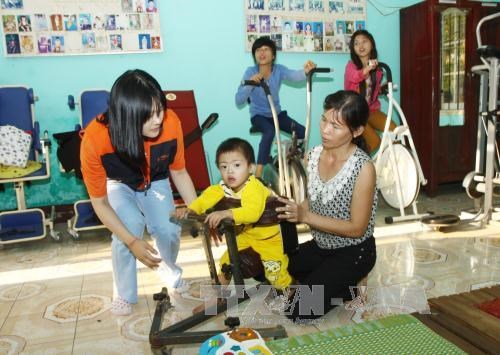 Supporting children with disabilities to access rehabilitation The Republic of Korea (RoK)’s medical organisation for peace (Medipeace) has sponsored over 1 million USD for the central province of Quang Tri to support children with disabilities to access rehabilitation and improve their lives in 2018-2020. The project has been carried out since June 2018 in Go Linh, Trieu Phong and Hai Lang districts. The Korea International Cooperation Agency (KOICA) and the provincial People’s Committee have coordinated to implement the “Happy Quang Tri” programme in Vinh Linh, Hai Lang, Trieu Phong, Cam Lo, Huong Hoa, Dakrong, and Gio Linh districts. This followed the successful implementation of the RoK’s “new village” programme with a total investment of over 11.6 million USD, including more than 9.6 million USD in non-refundable aid package of KOICA. The “Happy Quang Tri” programme covers projects to increase local incomes, build new rural areas, improve health capacity, forestation for environmental protection, public administration management, and develop infrastructure. Its main goals of increasing local incomes and reducing poverty have been achieved. Quang Tri has become more attractive to Korean businesses in recent years, especially in the fields of infrastructure, seaport and energy. Russia Day marked in Ho Chi Minh City  A performance at the Russia Day celebration in HCM City The Russian Consulate General in Ho Chi Minh City celebrated Russia Day (June 12) at a ceremony on June 8 evening. Speaking at the ceremony, Pham Duc Hai, Vice Chairman of the municipal People’s Council, highlighted the Vietnam – Russia traditional friendship and comprehensive cooperation have been cultivated by Vietnamese and Russian leaders and people over nearly seven decades since the countries established diplomatic relations in 1945. On behalf of the city’s authorities, Hai reviewed the outcomes of the May visit to Russia by a Ho Chi Minh City delegation, led by Secretary of the municipal Party Committee Nguyen Thien Nhan. The visit had given a boost to the bilateral ties, with a roadmap set up for 2018 – 2020 cooperation between the southern economic hub and Saint Petersburg. The official said the collaboration and relations between HCM City and other Russian localities like Sverdlovsk province, Vladivostok city and Moscow have been developed across municipal fields, including tourism, education, construction, health care, transport and smart city building. Aleksey Popov, Russian Consul General in HCM City, stated Vietnam is a time-honoured friend and a trustworthy and important partner of Russia. According to the diplomat, Vietnam – Russia comprehensive strategic partnership covers all arenas. Regular meetings of the two countries’ leaders have brought about practical results, as reflected through increased political dialogues, and better cooperation in economics – trade, science – technology, defence, military technology, and humanitarian activities. He praised HCM City’s active engagements with Russia and congratulated the local authorities on their successful visit to his country last May. In 2017, HCM City – Russia trade was close to 324 million USD, and Russian arrivals in the southern hub were recorded at nearly 180,000. Russia is currently investing in 28 projects worth 35 million USD in the city. Cultural exchange bonds Vietnam, Mexico: Mexican Minister 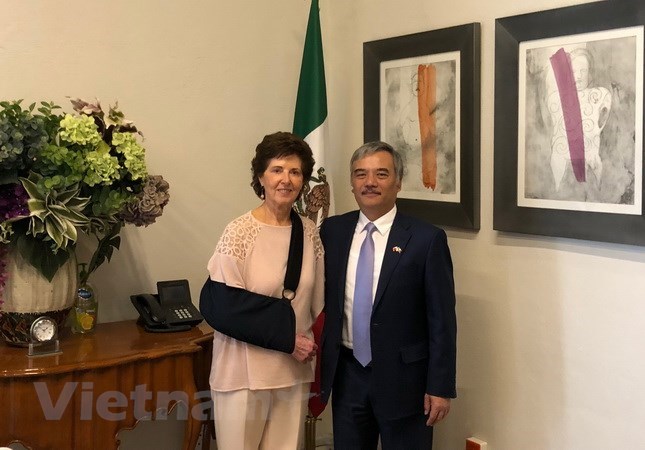 Mexican Secretary of Culture Maria Cristina Garcia Cepeda and Vietnamese Ambassador to Mexico Nguyen Hoai Duong Increasing cultural exchanges based on traditional friendship and cooperation as well as cultural and historical similarities have promote mutual understanding between Vietnam and Mexico, said a Mexican official. Mexican Secretary of Culture Maria Cristina Garcia Cepeda made the comment while receiving Vietnamese Ambassador to Mexico Nguyen Hoai Duong on June 8. At the reception, the diplomat conveyed to his host the greetings and expectation to increase bilateral cultural exchanges from Vietnamese Minister of Culture, Sports and Tourism Nguyen Ngoc Thien. Duong said he hopes to receive further support of the Mexican Secretariat of Culture in boosting joint cultural activities between Vietnam and Mexico in art, literature, music, photography, painting, and cultural heritage preservation. He mentioned a culture – education cooperation pact signed by Vietnam and Mexico for 2015 – 2019, with a vision toward 2020, the year the two countries will celebrate 45 years of their diplomatic relations. Agreeing with proposals made by the Vietnamese ambassador, Maria Cristina Garcia Cepeda lauded the embassy’s plan to organise a Vietnamese cultural week on the occasion of Vietnam’s National Day in September. The event will feature Vietnamese contemporary art, films and culinary delights. The minister pledged to direct relevant agencies in facilitating the Vietnamese Embassy’s organisation of cultural promotion and exchange activities. Children design smarter, child-friendly city  Children talk about their ideas for a smarter and more child-friendly city More than 270 children aged 8 to 14 are taking part in a summer programme to design a “smarter and more child-friendly” city. The programme called “Children Innovate: a Smart and Child-friendly City” kicked off on June 8. It was organised by UNICEF Vietnam in collaboration with the Saigon Innovation Hub (SiHub) under the city’s Department of Science and Technology, Department of Planning and Architecture, and Arkki - School of Architecture for Children and Youth in Finland. “The programme creates an environment for children to express their opinions about decisions that may affect them,” said Marianne Oehlers, chief of programme partnerships office at UNICEF Vietnam. It consists of 11 creative thinking workshops during this summer for children, including vulnerable and disadvantaged children. Each workshop lasts for five days with a daily schedule from 9am to 4pm. There will be three hands-on working sessions during each day. Participants will use clay, wood, computers, Sketch up and Microsoft Hololens to express their ideas. Nguyen Phi Van, chairwoman of Saigon Innovation Hub’s Board of Advisors, said: “Our aim is to provide kids with human-centered design thinking, important skills for the 21st century, and STEAM (Science, Technology, Engineering, Arts, and Math) knowledge.” Twenty-five children took part in the first workshop, she said. "I find the program a lot of fun. We have learned many ways to build a child-friendly city based on our own views,” said Hoang Mai Anh, 11, from Tran Van On Secondary School in District 1, who attended the first workshop. All the ideas and projects will be displayed at an exhibition during Creativity and Innovation Week in October to urban planning experts, decision-makers and the public. The best ideas and projects will receive awards from the organisation. The programme is part of the city’s Child Friendly City Initiative Project that runs from 2017 to 2021. Vietnamese, Lao youths boost cooperation 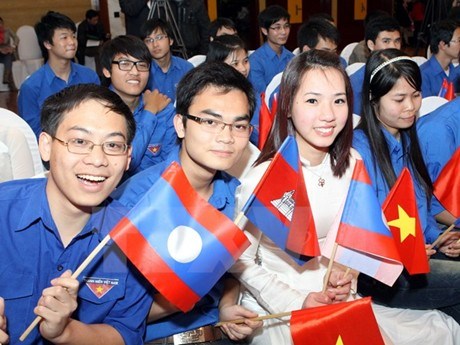 Vietnamese, Lao and Cambodian youths sit together at an event (Photo: chinhphu.vn) Youth unions in the Central Highlands province of Dak Lak and Lao province of Champasak signed a memorandum of understanding on cooperation for 2018 – 2022 at a meeting on June 8 in Dak Lak’s Buon Ma Thuot city. Secretary of the Dak Lak provincial committee of the Ho Chi Minh Communist Youth Union (HCYU) Y Nhuan Bya said the MoU on cooperation in work related to young people and young entrepreneurs is a tradition of the HCYU and the Lao People’s Revolutionary Youth Union. Under the MoU, the sides agreed to increase communication campaigns on Vietnam – Laos time-honoured relations and political-security collaboration. They said they will hold youth exchanges to help their young people learn from each other in starting their own business and build their career. The two unions agreed to encourage the youths to join socio-economic cooperation activities in their respective localities, while stressed that cultural and sport exchanges to boost mutual understanding are also necessary. The two sides also pledged to hold trade promotion events, provide each other with information on trade fairs and business workshops, and support products introduction activities to help young entrepreneurs in the two provinces. The sides said they will take turns in organising capacity-building courses and business exchanges for their youths. Youth activities of both sides took the occasion to discuss issues related to the freshly signed MoU, concerning support in tertiary education and vocational training for young people and youth union activists. Hanoi, Dell to cooperate in building e-government, smart city 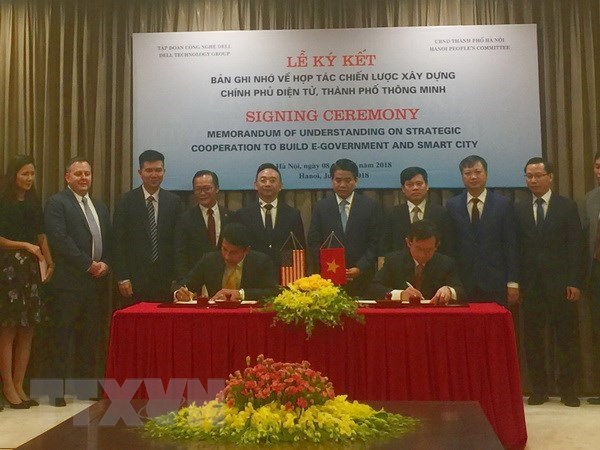 Scene at the signing ceremony Hanoi authorities and US-based Dell Technologies Inc. on June 8 secured a memorandum of understanding (MoU) on strategic cooperation in building the local e-government and smart city. The pact was inked by Director of the capital Department of Information and Communications Nguyen Ngoc Ky and Ravi Bharadwaj, a vice president at the Strategy & Business Development Department of Dell Global B.V.’s Asia Pacific & Japan (Singapore branch). The MoU aimed at creating an unbinding framework for both sides to cooperate. Accordingly, Dell, via its Singapore branch, will provide free consultations on e-government and smart city building for Hanoi and on information technology for the city’s selected partners. The Hanoi department said the capital’s e-government and smart city structure must be in line with Vietnam’s e-government structure framework as well as the Ministry of Information and Communications’ guidance on building provincial e-government and orientations for IT and communications in smart city building. VNN |
↧
Article 0
‘Vintage’ phones a rising trend among consumers in Ho Chi Minh CityA used phone can cost as much as a brand new mid-range smartphone  A buyer browses for phones of older models at a shop in Ho Chi Minh City. Photo: Tuoi Tre Many consumers in Ho Chi Minh City are willing to pay a high price for used mobile phones of older models despite the continuous release of new designs and technology by famous smartphone brands. Some people are not hesitant to open their wallet for cellphones that are up to 10 to 15 years old, as they consider them ‘vintage products.’ Tuoi Tre (Youth) newspaper reporters paid a visit to a shop on Pham Ngu Lao Street in District 1, Ho Chi Minh City, where a variety of older models of Nokia, Motorola, and Sony phones are offered at VND2 million (US$88) to VND10 million ($440) apiece. Some of the store’s best sellers are the Nokia 8800 Anakin, whose price is VND3.5 million ($154), 8800 Sirocco, selling for over VND4.5 million ($198), and 8800 Arte, costing more than VND7 million ($308). These phones were first released around 2005. Other types of flip phones produced by Nokia and Motorola are also preferred by many buyers. Nguyen Dinh Huy, a resident in District 8, who had just bought a Nokia 8800 model at VND4.7 million ($207), said he could be able to purchase a brand new mid-range smartphone at a similar price. However, Huy still preferred the used Nokia device for its classic design. According to the owner of the shop, he can sell up to 300 old phones on a daily basis. At another store on Le Van Sy Street in Tan Binh District, some gold-edition Nokia mobile phones are sold at a whopping VND10 million ($440) to VND30 million ($1,320). Although many brands have decided to relaunch their older models, the majority of buyers are looking for the used products that were manufactured many years ago, said Nguyen Trung Duong, the store owner. Most buyers of these ‘vintage’ handsets are middle-aged people as the devices give them a sense of nostalgia, sellers stated, adding that others pick the old models because of their old habits. Some also believe that the old phones would provide higher security and lower risks of information leakage. According to experts, buyers should pick reputable shops and sellers when it comes to purchasing phones of older models. Dishonest merchants may take out some parts of the original handset, which is difficult to notice, thus the entire value and quality of the phone would be reduced. A warranty is also necessary as used phones are more likely to malfunction. Tuoi Tre News |
↧
Article 2
PM: Vietnam ready to enhance cooperation with partnersHanoi -The Asia Pacific Foundation of Canada (APF Canada) has published on its website an interview with Vietnam’s Prime Minister Nguyen Xuan Phuc at the conclusion of the 44th G7 summit held on June 8–9, 2018, in Quebec. The following is the full text of the interview.  Prime Minister Nguyen Xuan Phuc. (Photo: VNA) Correspondent: Ocean is an agenda item for this year’s G7 Leaders’ Outreach Session. We know that Vietnam is a coastal country highly vulnerable to the impacts of climate change. Mr. Prime Minister, could you please share with us the policies that Vietnam is pursuing to develop its marine economy and protect the marine environment? Prime Minister Nguyen Xuan Phuc: The 21st century is the century of oceans, as the seas and oceans are the habitat and development space for the coastal countries in general and the planet as a whole. Therefore, the development of maritime economy and the protection of the marine environment play a very important role in the sustainable development of coastal countries, including Vietnam. Our country has immense potential for marine economy development: a 3,260 km long coastline, or one kilometer of coastline for every 100 square kilometers of land, six times greater than the world average. Vietnam has 1 million square kilometers of territorial waters, endowed with rich and lucrative resources, such as seafood (3 to 3.5 million tonnes), oil and gas, and other mineral resources. Vietnam has more than 2,770 islands and islets, and many beautiful bays recognized as world heritages, such as Ha Long Bay, and 125 beautiful scenic beaches, 20 among them are of international standards. These make for enormous potential for the development of maritime tourism. In addition, Vietnam is also located in a very important geo-strategic position on the international trade lane connecting the Pacific and Indian Oceans. Five out of ten largest sea lanes in the world pass through the East Sea (a.k.a. South China Sea), accounting for more than 50 percent of total global shipments. With more than 90 ports, including deep-water international transit ports, Vietnam boasts excellent potential in the development of sea transport, transit and logistics. Given such rich potential, marine economy and seaward development have been Vietnam's strategic development orientation for many years. Our vision is to build Vietnam into a marine-capable country. We have set the target that by 2020, the marine and coastal economic sectors shall account for 55 percent of our GDP and 60 percent of gross export. To realize the above vision and goal, Vietnam has been implementing many policies, plans and measures to develop the marine economy and protect the marine environment. First, we have been improving the institutions, policies, legal framework and planning for the sea and islands. The Sea Law, Marine Resources and Environment Law and relevant regulations are being effectively implemented. Vietnam has acceded to multiple international maritime protocols and agreements in order to create the legal framework for the development of the marine economy. Second, we are consistently implementing policies pertaining to the research and development and application of marine science and technologies. We are modernizing the marine infrastructure to support the marine economy such as coastal roads and the port network. Vietnam has established a number of competitive marine industries, such as tourism, aquaculture, fishing and seafood processing, oil and gas exploitation and production as well as fifteen coastal economic zones. The export value of seafood in 2017 exceeded 8.3 billion USD, a record year-on increase of 19 percent. The figure for the first five months of 2018 amounted to 3.15 billion USD, up 11 percent year-on year. Third, we consider the protection of the marine environment and ecology an extremely important, regular and long-term mission. Developing the marine economy concurrently with the protection of the marine environment is Vietnam's consistent position in her marine strategy, the principle being that “use and extraction” need to go hand-in-hand with “protection and renewal”, without trading off the environment for economic growth. All development projects must ensure full and effective observance of environment protection regulations. The Vietnamese government encourages businesses within and outside of Vietnam to invest into the sustainable development of the marine economy, such as marine ecosystem protection, sustainable aquaculture and renewable energy development, treatment of waste discharged into the sea, and enhancing capacity for responding to climate change and rising sea level. Fourth, we will step up international cooperation and integration, thus making active and responsible contribution to the reinforcement of peace and stability in the seas. Vietnam supports the effort of the international community that contributes substantially to the maintenance of peace, stability, security, safety and freedom of navigation and overflight, and to the protection of the marine environment. Vietnam’s consistent policy is to resolve differences and disputes through peaceful means in compliance with international law, in particular the 1982 United Nations Convention on the Law of the Sea; respect the diplomatic and legal processes; promote mutual trust; refrain from the use or threat of force; fully and effectively implement the Declaration of Conduct of Parties in the South China Sea (DOC); and work towards the early conclusion of a substantive and effective Code of Conduct of Parties in the South China Sea (COC). Vietnam stands ready to promote cooperation with all countries and partners in the development of marine economy, on the basis of equality, mutual benefit and observance of international law towards the common goal of clean, peaceful and stable oceans for the common prosperity. Correspondent: Mr Prime Minister, Vietnam has been invited by host countries to the 2016 G7 Leaders’ Outreach Session in Japan, the 2017 G20 Summit in Germany and again to the 2018 G7 Leaders’ Outreach in Canada. This seems to indicate the growing role and status of the country in the international arena. Could you please give us some ideas about the messages and initiatives of Vietnam at the 2018 G7 Leaders’ Outreach Session? Prime Minister Nguyen Xuan Phuc: In implementing our foreign policy of independence, self-reliance, diversification and multi-directionalisation of our external relations, Vietnam is carrying out active and extensive international integration in a variety of areas. As a trustworthy friend and partner, Vietnam has been making active and responsible contribution to matters of common interest to the international community at many important multilateral forums, such as the United Nations, ASEAN, APEC and ASEM to name a few. The fact that Vietnam was invited to join the recent G20 and G7 Leaders’ Outreach Summits indicates that the international community acknowledges Vietnam's active role, efforts and contributions to the maintenance of a peaceful and stable environment for cooperation and development in the region, the promotion of the shared interests, as well as the settlement of the common challenges of the world and the region. The agenda of this year's G7 Leaders’ Outreach Session prioritizes discussion on the ocean. This is a matter of existential importance to the survival and development of coastal countries and the planet at large. At the Summit, the leaders of G7 countries and invited countries and international organizations shared their views and ideas on the promotion of international cooperation to enhance capacity in climate change and rising sea level adaptation and response, sustainable extraction of marine resources, and protection of the marine environment and ecology. The fact that Vietnam was invited to the G7 Leaders’ Outreach Session by Canada is both another step forward in the Vietnam – Canada Comprehensive Partnership established in November 2017, and a testimony to the role, status and efforts of Vietnam in climate change response, marine economy development and marine environment protection that are acknowledged by the international community. At this Summit, Vietnam has provided concrete and responsible inputs to the discussions of many important agenda items, in particular the promotion of serious implementation of the Paris Agreement on Climate Change, the protection of the marine environment and ecosystem, and the prevention of plastics pollution the oceans where as much as 8 million tonnes of plastic are being added every year. We welcome Canada and G7 countries’ initiatives to promote cooperation to prevent marine litter, advance gender equality and facilitate women's access to basic resources and services for climate change response. On our part, Vietnam suggested that the international community should discuss the possibility of a Global Agreement on the Prevention of Plastic Litter in the Ocean, akin to the Paris Agreement on climate change. In addition, Vietnam also calls upon the G7 countries to consider establishing an Expanded Cooperation Forum between G7 countries and coastal countries on climate change and rising sea level response and marine environment and ecosystem protection. Such initiatives stem from the urgent need of the international community for the promotion of concrete and effective cooperation in climate change response and marine environment protection, and thus were welcomed and highly regarded by many countries at the Summit. Vietnam stands ready to promote cooperation with all countries and partners in implementing the above-mentioned initiatives through concrete and practical programs and projects, for the common sustainable development and prosperity of our planet as a whole. VNA |
↧
↧
Article 1
Việt Nam commits to stable business community HÀ NỘI — Việt Nam is committed to maintaining a stable environment to ensure the rights and interests of foreign businesses investing in the country, said Deputy Prime Minister Trương Hòa Bình at the 24th International Conference on the Future of Asia in Tokyo on Monday.
Deputy Prime Minister Trương Hòa Bình makes speech at the 24th International Conference on the Future of Asia in Tokyo. — Photo baodientuchinhphu.vn He said the Government would continue to work on the legal system and policies related to investment in a consistent and transparent manner. The Government would also strive to improve law enforcement, strengthening and focusing on solving problems for investors. According to the deputy PM, the peaceful environment, co-operation and development had made Asia an economic, political and cultural centre accounting for 45 per cent of global GDP, which is expected to rise to 50 per cent by 2025. Asian countries have also become bigger players in global trade and investment, accounting for around one-third of international foreign direct investment, import and export values. "Openness and co-operation are key factors for recovery and to create new momentum for economic growth," the Deputy PM said. Bình was optimistic about the future, but warned of potential challenges to the regional and global economies. He mentioned three major risks. Firstly, the rising tide of protectionism, increased uncertainty in powerful countries and tensions in trade relations among the world’s leading economies. "In a world of tightly intertwined interests, any escalation of tensions could disrupt the international financial system, as well as regional and global supply chains. Policies that go against globalisation, trade and investment liberalisation could have unpredictable implications. Putting national interests in conflict with the global interests would undermine confidence and achievements," said Bình. Secondly, with progress in science and technology, the industrial revolution 4.0 opens up tremendous growth opportunities but also presents challenges for Asian countries, especially developing countries. According to the International Labour Organisation, more than two thirds of workers in the textile and footwear sectors as well as manufacturing industries in Southeast Asia are threatened by the rapid application of science and technology. Thirdly, non-traditional security issues such as natural disasters, food-water-energy security, epidemics, maritime security, climate change and the rich-poor divide and social diversification are challenges for the development of Asian countries. In order to build a prosperous and stable Asia, environmental protection needs to be a pillar of development. Bình said Việt Nam highly valued the Japanese Government’s efforts to accelerate the conclusion of the Comprehensive and Progressive Agreement for Trans-Pacific Partnership. "We hope that Japan, as a leading economic partner of many Asian economies, will serve as a locomotive to enhance regional economic integration and connectivity," said Bình. At the summit, the Deputy PM also highlighted the important progress that Việt Nam had made over the past three decades, linked to Asia’s growing status and regional economic integration. Open, multilateral and diversified foreign policy had helped Việt Nam overcome difficulties and integrate with the world, he said. The renewal process had helped the country to transform and achieve significant socio-economic development. With an average annual growth rate of 6.6 per cent over the past three decades, Việt Nam’s GDP soared 35 times to US$220 billion in 2017 and was expected to reach $300 billion by 2020. In 2017, The country maintained macroeconomic stability, controlled inflation (at 3.5 per cent), reached a record $425 billion in trade turnover and over $60 billion in foreign exchange reserves. The country has attracted $325 billion of registered FDI from 127 countries and partners around the world. In 2017, the country rose 14 places on the global business environment index to 68/190, according to the World Bank. Việt Nam’s competitiveness index also rose 5 places to 55/137 on the World Economic Forum’s ranking. Credit rating agencies such as Moody’s and Fitch have raised the rating level for Việt Nam’s economy from "stable" to "positive", and a number of transnational corporations have chosen Việt Nam to invest in development and connectivity in the global value chain, said Bình. The deputy PM said that Việt Nam and Japan were preparing to celebrate the 45th anniversary of Việt Nam-Japan relations (1973-2018). Japan is the largest investor in Việt Nam with total direct investment of more than $9 billion. Two-way trade reached over $33 billion. The recommendations of the Japanese business community are always recognised and resolved by the Vietnamese Government, said Bình. VNS |
↧
Article 0
President Ho Chi Minh Mausoleum closes for maintenanceHanoi -The President Ho Chi Minh Mausoleum in Hanoi will be closed to visitors for maintenance from June 15 to August 15, according to the mausoleum’s Management Board.  President Ho Chi Minh Mausoleum (Photo: VNA) In its statement, the board said that the adjacent Monument to Heroic Martyrs will be also closed in the same period for annual maintenance and renovation. The sites will resume operation from August 16, said the statement. The Ho Chi Minh Mausoleum is an important landmark of Hanoi capital city and stands integrated to the political and social history of Vietnam. After his death on September 2, 1969, President Ho Chi Minh was embalmed and put for view in this granite mausoleum. The mausoleum, modelled after Lenin's tomb in Moscow, was built in two years, from 1973 to 1975, with materials donated by people from all over the country. The mausoleum welcomed nearly 51,000 visitors, including 11,500 foreigners during holidays in celebration of the 43rd National Reunification Day (April 30) and International Workers’ Day (May 1) this year. VNA |
↧
Article 1
BUSINESS IN BRIEF 12/6 Code and barcodes are necessary to ensure safety 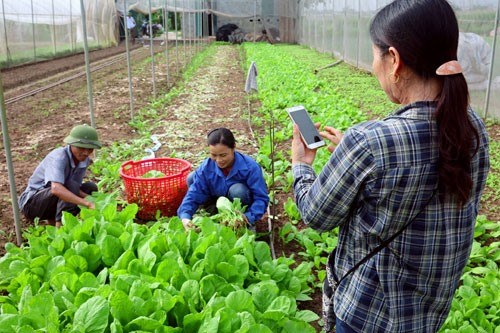 Farmers of Chuc Son Fruit and Vegetable Cooperative in Chuong My district, Hanoi, check the bar code of their produce The use of codes and barcodes on products has helped improve the competitiveness of enterprises and ensured effective monitoring on the origin of goods for consumers. However, to meet the requirements of management agencies and consumers, the application of codes and barcodes needs more comprehensive solutions relating to management and technology. Codes and barcodes help quickly and accurately distinguish different types of products. The code consists of a sequence of numbers, which allow people to identify factors relating to the goods. Barcodes consist of a pattern of parallel lines in varying widths, along with numbers, which are read by a computer of scanner. According to the Vietnam Code and Barcode Association, in recent years, the application of codes and barcodes in production and business has become increasingly popular nationwide. There are about 180 trade centres, 800 supermarkets, 4,000 convenience stores, and 9,000 family run stores that use them. Previously, codes and barcodes were mainly used when importing goods, as well as for payments at counters. Nowadays, codes and barcodes are used for warehouse management, pricing, and logistics. They’re also used to trace the origin of goods, especially foodstuffs, in order to ensure safety for consumers, and to ensure the quality of exported goods. Ha Minh Hiep, Deputy General Director of the Vietnam Directorate for Standards, Metrology and Quality (VNDSMQ) told Ha Noi Moi (New Hanoi) newspaper that the use of codes and barcodes is an effective application of technology which aims to help consumers and enterprises quickly identify information about products. However, the technology hasn’t reached its full potential, he said. At present, many companies haven’t employed codes or barcodes for their products, preventing legal access to the retail industry. Notably, the use of fake codes and barcodes has been reported. Recently, bar code scanning software has been widely used by smart phone users to identify the origin of goods. According to a representative of the Vietnam Code and Bar Code Association, the use of smart phones to scan bar codes for the purpose of distinguishing real goods or counterfeit goods is necessary effort. Unfortunately, many goods have a standard bar code, but were fake or poor-quality. Seeking the origin of products by scanning their code or barcode is necessary, but in order to effectively promote the circulation of goods in the market, additional tools are needed to ensure safety and quality. According to Ha Minh Hiep, one of the key tasks that the VNDSMQ has been implementing is to build a national data centre storing all information on codes and barcodes. “We will have information resources on products and goods, so enterprises, manufacturers, supermarkets, and retailers can access data and better develop their services,” he said. Phan Hong Nga, head of the code and barcode office under VNDSMQ, said according to the Ministry of Science and Technology’s regulations on code and barcode granting, use and management, enterprises must periodically notify the list of codes and bar codes of their products. VNDSMQ’s free online software – idd.gs1vn.org.vn – was set up for businesses to declare product information quickly and accurately. The information is then automatically updated on the national data system. According to Ha Minh Hiep, legal documents relating to codes and bar codes in Vietnam are now relatively up to date. VNDSMQ is submitting a project on managing the origin of products to the Ministry of Science and Technology. Once the project is approved, we will have additional tools to identify goods and remove poor-quality goods from the market. Fast growth – a condition for sustainable development: Deputy PM Deputy Prime Minister Vuong Dinh Hue speaks at the symposium in Hanoi on June 10 Fast growth is a condition for sustainable development, Deputy Prime Minister Vuong Dinh Hue said at a symposium in Hanoi on June 10. Amid the Fourth Industrial Revolution (Industry 4.0), Vietnam can easily lag behind if it does not develop rapidly, he said at the event, which saw the presence of Chairman of the Theoretical Council of the Party Central Committee and Director of the Ho Chi Minh National Academy of Politics Nguyen Xuan Thang, representatives of central sectors, and scientists. The symposium, held by the Vietnam Academy of Social Sciences (VASS), discussed solutions to reinforce and create the basis for fast and sustainable development in the new context in Vietnam. Director of the VASS’s Centre for Analysis and Forecast Nguyen Thang said to capitalise on opportunities and minimise challenges in Industry 4.0, the country needs to address major issues, including ensuring that regulations are updated to pave the way for new technologies and modes of production to be applied in life. It should promote skills update amid the technology race and solve outstanding socio-economic and environmental problems. It is also critical for Vietnam to learn experience of other countries, especially those taking the lead in Industry 4.0, he added. Dang Kim Son, former specialist at the Institute of Policy and Strategy for Agriculture and Rural Development under the Ministry of Agriculture and Rural Development, said to successfully become an industrialised nation, Vietnam needs to boost the role of agriculture and rural areas in industrialisation, application of scientific and technical advances in the reality, and connection with urban areas so as to promote the quality and sustainable values of the economy. Other participants at the event also stressed the necessity for openness and transparency to achieve fast and sustainable growth. Tay Ninh draws over 14.3 trillion VND in solar power projects The southwestern province of Tay Ninh has granted investment licenses to five solar power projects worth over 14.3 trillion VND (629.9 million USD) in Duong Minh Chau and Tan Chau districts. The plants with a combined capacity of 560 MWp will be built on 20,620 hectares in the area of Dau Tieng reservoir. Their construction is set to commence at the end of this year. Three projects were invested by Dau Tieng Tay Ninh Energy Joint Stock Company. The Dau Tieng 1 and 3 solar power plants are designed with the same capacity of 150 MWp and have respective investment of over 3.9 trillion VND (171.7 million USD) and 3.6 trillion VND (158.5 million USD). The Dau Tieng 2 solar power plant worth over 4.9 trillion VND (215.8 million USD) has a capacity of 200 MWp. The other projects were invested by Tri Viet Tay Ninh Joint Stock Company and Bach Khoa A Chau Tay Ninh Joint Stock Company with the same capacity of 30 MWp and investment of over 760 billion VND (33.4 million USD). In recent years, the Dau Tieng reservoir has played an important role in providing water for agriculture, industry and local daily activities. It holds great potential for solar energy production. According to the Government’s targets, solar power is expected to become the main renewable energy source in the future, with installed capacity to be increased from 6-7 MW by the end of 2017 to 850 MW by 2020 (1.6 percent of the country’s power generation) and 12,000 MW by 2030 (3.3 percent of the country’s power generation). Vietnam is among countries that enjoy the most sunlight in the world, with the Central Highlands and south central regions recording between 2,000 and 2,600 hours of sunshine every year, reported the Vietnam Clean Energy Association. Average solar radiation is 150 kcal/sq.m, about 2,000 to 5,000 hours per year. Vietnam, China promise optimal conditions for lychee export Deputy Prime Minister Vuong Dinh Hue called on the Chinese side to facilitate customs clearance of Vietnamese agricultural products, including lychees, while addressing an economic forum in Bac Giang province on June 8. The forum focused on the production and consumption of lychees and other key agricultural products of the northern province, which is home to the largest concentrated lychee farming area in Vietnam – more than 28,000 hectares. Sharing the Deputy PM’s view, officials of the districts with big farm produce output in Bac Giang like Luc Ngan, Yen The, Tan Yen and Hiep Hoa also asked the administration of Pingxiang town, the Chinese province of Guangxi, to create more favourable conditions for vehicles transporting agricultural products, especially lychees, to go through its border gates as soon as possible. Representatives from Lang Son and Lao Cai provinces, which border China, pledged to provide the best conditions for the customs clearance of farm produce and coordinate with Chinese authorities to remove export-import obstacles. Meanwhile, the Chinese side also promised to swiftly handle customs procedures for Bac Giang lychees. A leader of the Pingxiang fruits association said more than 200 traders are in Bac Giang and some localities of nearby Hai Duong province to purchase lychees in big volume. At the forum, Vice Chairman of the Bac Giang provincial People’s Committee Duong Van Thai said local authorities have provided the best support possible for lychee farmers and domestic and foreign businesses to harvest and purchase lychees. The province is also actively taking measures to expand the market for the fruit in both Vietnam and other countries. Lychees are one of the 52 key agricultural products of Bac Giang, a list approved by local authorities in 2017. About 13,500ha of lychee trees in Bac Giang are farmed under VietGAP standards with an estimated output of 90,000 tonnes. Of that area, 218ha with more than 10,000 tonnes of lychees are cultivated under GlobalGAP standards and eligible for export to demanding markets. Total lychee output in the province is expected at 150,000 – 180,000 tonnes in 2018. Quang Tri approves two wind, solar power projects Chairman of the People’s Committee of Quang Tri province Nguyen Duc Chinh on June 8 signed decisions approving two wind and solar power projects with total investment of over 2.7 trillion VND (120 million USD). Under Decision No.1250/QD-UBND, the provincial authorities allowed Tan Hoan Cau Corporation to carry out Huong Hiep 1 wind power plant project in Huong Hiep commune, the mountainous district of Dakrong. With 12 wind turbines, the plant has a total capacity of 30MW, generating more than 126 million kWh of electricity per year on a site of nearly 8ha. The project costs over 1.55 trillion VND, valid for 50 years. The plant is being built from June 2018 to December 2020. Under Decision No.1247/QD-UBND, the Licogi 13 JSC was allowed to build LIG-Quang Tri solar power plant in Gio Hai and Gio Thanh communes, Gio Linh district with a designed capacity of 49.5 MWp, generating 67,960 MWh of electricity each year. Costing 1.2 trillion VND, the project will be implemented from June 2018 to June 2019, using 58ha of land. The provincial authorities have agreed with a plan to build five wind power projects with a combined capacity of 150MW, which are expected to be put into operation in 2030. The central locality is calling for investment in 17 solar power projects with a total capacity of more than 930MW to be built on about 1,400 ha. Capital mobilisation in Ho Chi Minh City up over 14 percent Capital mobilization by banks in Ho Chi Minh City reached over 2,082 trillion VND (88.1 billion USD) as of May, up 0.83 percent from the previous month and 14.47 percent year on year, said the municipal branch of the State Bank of Vietnam (SBV) on June 7. Of the amount, commercial joint stock banks accounted for 50.85 percent, up 9.08 percent from the same month last year. Saving deposits made up 49.81 percent of the total, marking a 7.54 percent yearly increase. As of early May, total outstanding loans surpassed 1,855 trillion VND, up 16.82 percent annually and 5.37 percent monthly. Commercial joint stock banks accounted for over 972.2 trillion VND, or 52.39 percent of the total and up 12.76 percent year-on-year. May was the second consecutive month the SBV had pumped money into the banking system. The inter-bank rate was more stable in early May but increased in the latter half of the month, especially for short-term loans. Experts said there is no need to worry about the system’s liquidity, but close watch should be kept on new factors such as trade deficit and the tendency of capital withdrawal by foreign investors. The USD Index went up 7 percent to 94.8 point, pushing up the US dollar price to over 22,880 VND, 0.64 percent higher than the level in the beginning of the year. However, the foreign exchange is still cushioned by several factors, including a record foreign reserve of 64 billion USD. The SBV adjusted the daily reference exchange rate down to 22,566 VND on June 1, thus pushing the US dollar price down to 22,840 VND. According to experts, it is necessary to closely keep track of banking liquidity, trade deficit and indirect capital flows. Vietnam has good growth momentum: Fitch forum The Vietnamese economy is enjoying stronger growth compared to 2017 with increasing foreign reserves and tight control of foreign debt, said Fitch experts at the “Fitch on Vietnam” forum held in Hanoi on June 8. Speaking at the event, Sagarika Chandra, senior analyst at Fitch Vietnam, said in May 2018, Fitch had improved Vietnam’s Long-Term Foreign-Currency Issuer Default Rating (IDR) rating from BB- to BB with a stable outlook, thanks to a rise in foreign exchange reserves and strong economic growth. Vietnam records a high growth rate in comparison to emerging economies or other BB-ranked nations, she said. The country’s GDP growth was above 6 percent in 2017 and is expected to reach 6.7 percent in 2018 and following years, she noted, adding that this was one of the important factors that helped improve Vietnam's rating. According to the expert, the rating is a result of the country’s maintenance of macroeconomic stability, stronger resilience to external risks and compliance with financial criteria. The Vietnamese government promulgated a flexible exchange rate mechanism in early 2016, and committed to limiting national debt as well as to restructuring state-owned enterprises. Among those factors, sustainable macroeconomic performance and increased foreign reserves are the two most important elements of Fitch's rating. Fitch forecasted the Vietnamese economy could grow 6.7 percent in 2018, making Vietnam one of the fastest growing economies in Asia-Pacific and the fastest among BB-rated countries. Can Van Luc, chief economist of the Investment Bank for Development of Vietnam (BIDV), said Vietnam sees a positive economic outlook with recognition of many international organisations. The World Bank has also revised up Vietnam's economic growth forecast to 6.8 percent from the previous 6.5 percent, he added. Luc said two other factors making the economy more attractive is the fast expansion of private sector consumption, which increased by about 10 percent in the past year, and the surge in private investment besides the inflow of foreign capital. Sebastian Eckardt, the World Bank's Lead Economist for Vietnam, highlighted a number of risks and challenges to Vietnam in future. He said the economy is highly open, making it vulnerable to impacts of external factors such as trade fights, higher oil prices, and geopolitical instability. In addition, the tightened monetary policy adopted by many state banks is expected to exert great impacts on the world economy and Vietnam will not be spared, he said. Measures sought to facilitate Vietnam’s shrimp export to US High anti-dumping tariff and the US Seafood Import Monitoring Programme (SIMP) are now key barriers facing Vietnamese shrimp exporters. According to the Vietnam Association of Seafood Exporters and Producers (VASEP), though shrimp export in the first four months grew by 13.8 percent annually to over 1 billion USD, the April figure dropped by 0.4 percent year-on-year, reaching over 275 million USD. Last year, while shrimp export to countries surged, it fell by 8 percent from 2016 in the US market, partly due to high anti-dumping tax. In early March, the US Department of Commerce (DOC) announced preliminary results of anti-dumping tax on Vietnamese shrimp during the 12th period of review from February 1, 2016 to January 31, 2017, amounting to 25.39 percent, much higher than the previous reviews. Though lawyers discovered DOC’s miscalculations and preliminary results only serve as a reference, the ruling worried both sellers and buyers. In April 2018, shrimp was added to the SIMP by the National Oceanic and Atmospheric Administration. Accordingly, shrimp importers must fully abide by SIMP’s requirements by December 31, 2018. Specifically, they must be US citizens with International Fisheries Trade Permit from NOAA, declare necessary data to ensure legal imports. Such data must be kept within two years. VASEP General Secretary Truong Dinh Hoe said the US has high demand for aquatic products, especially shrimp. It imports nearly 600,000 tonnes of shrimp for domestic consumption. However, Vietnam’s shrimp export to the US only accounts for 10 percent annually, or around 60,000 tonnes. Meanwhile, Vietnam could ship 150,000 tonnes to the country so that firms need to improve quality and competitiveness to expand their market share. VASEP has recently sent a document to the Ministry of Agriculture and Rural Development suggesting measures for sustainable shrimp production and export. It asked the government to heed high-level diplomatic activities so that the US could rapidly lift trade barriers, especially anti-dumping taxes on shrimp. Domestic market remains stable in May The domestic market remained stable in May with total revenue from goods retail sales and services exceeding 354 trillion VND (15.6 billion USD), up 1.5 percent against the previous month and 10.4 percent year-on-year. The amount lifted the total revenue from goods retail sales and services in the first five months of this year to nearly 1.75 quadrillion VND (77.2 billion USD), an increase of more than 10 percent over the corresponding period last year, according to the Ministry of Industry and Trade (MoIT)’s Domestic Market Department. The value was mainly contributed by essential goods like food and foodstuff, garments-textiles and household utensils. Of note, revenue from tourism services expanded by 23 percent thanks to effects of the beginning of the tourism season and Vietnam’s efforts to develop the tourism sector. Despite rosy signs of the market in the five months, huge inflation pressure is forecast to persist in the time ahead, mainly due to increasing trends of prices of petroleum and other major materials, plus results of the market price roadmap for several public services like health care and education. Besides, the adjustment of the basic salary from July 1 is expected to impact on prices of goods and domestic consumption. Given this, the MoIT has underlined the need to keep a close watch on the market in the remaining months of the year in order to ensure macro-economic stability. Viettel opens its 10th international mobile network in Myanmar The Vietnamese military run telecom Viettel Corporation officially launched its 10th international mobile network in Myanmar, under the brand name of Mytel, on June 9. As the fourth network in the Myanmar market, Mytel aims to be the largest operator in both infrastructure and business. It is the first and only mobile network in Myanmar to be equipped with nationwide, state-of-the-art, 4G technology, immediately following its launch. Speaking at the ceremony, Senior General Min Aung Hlaing, commander-in-chief of the Myanmar Armed Forces, said that the event is a milestone in the history of Myanmar, and also a milestone in the relationship and cooperation between Vietnam and Myanmar in the field of ICT. He expressed his belief that the Mytel joint venture would continue to succeed and contribute to the development of telecommunications and high quality human resources for Myanmar. In addition to its business operations, Mytel expects to spend US$80 million over 15 years for social responsibility projects in Myanmar, of which 80% will be allocated to support the education sector. According to Nguyen Thanh Nam, General Director of Mytel, his network’s goal is to create a real information highway with extensive 4G infrastructure in order to empower local people and the country of Myanmar in the Industrial Revolution 4.0. As has been deployed in other international markets, Viettel has set the top target of becoming No. 1 in mobile broadband, thus significantly improving the world rankings of the telecommunications infrastructure in the country in which they are investing, Nam added. Among the ten international markets where Viettel has run business, Myanmar is the country with the fastest deployment of telecommunications infrastructure and is the biggest foreign market of Viettel up to now. To date, Viettel's registered capital in foreign countries has reached over US$2 billion, with profit at US$516 million, or nearly 45% of the total investment. Dragon fruit dominates Vietnam fruit exports Dragon fruit has dominated Vietnamese fruit exports in the first four months of 2018 with total exports reaching USD427 million, a year-on-year increase of 9%. According to the General Department of Vietnam Customs, dragon fruit accounted for 32% of the total export value of Vietnamese vegetables and fruits. The export value of dragon fruit was nearly four times higher than the two fruit exports ranked below it – longan, which had an export value of US$121 million, and mangos, whose export value stood at US$104 million. Dragon fruit exports also outperformed the vegetables group, which had an export value of US$143.8 million, and processed products, at US$143.6 million. Thanks to favourable exports, prices of different variations of dragon fruit in the raw materials sector have remained high since the beginning of the year. The price of white dragon fruit currently stands at about VNĐ20,000 (US$0.87) per kg while red dragon fruit sells for VNĐ40,000 per kg. In addition to Bình Thuận, called the “dragon fruit capital,” the fruit is now being grown in many southern provinces in Vietnam, specifically Long An and Tiền Giang. Aside from dragon fruit, mango exports also made a strong impression by doubling its export value in the first four months of the year compared to the same period last year, reaching US$104 million and pushing its market share from 5% in 2017 to nearly 8% from January to April 2018. Mangoes are mainly exported to China, the Republic of Korea, Australia, and Japan. The value of mango exports to Chinese market during the same period reached US$95 million, up 119% over the same period last year and accounting for 91% of Vietnam’s total export turnover of mangoes. According to statistics from the Department of Farm Produce Processing and Market (DFPPM) under the Ministry of Agriculture and Rural Development, fruit and vegetable exports from January to May reached US$1.62 billion, an increase of 16.4% against the same period last year. China remains Vietnam’s largest importer of vegetables and fruits. In the first five months of 2018, Vietnam’s total import value reached $575 million, a year-on-year increase of 15.3%. In order to maintain the export growth of vegetables and fruits and avoid devaluation, the DFPPM said Vietnam’s fruit and vegetable industry must maintain control over quarantine and food hygiene and safety, especially pesticide residues. In addition to inspecting and speeding up the processing of factories every year, they must coordinate with localities to concentrate on reinforcing the raw materials sector to ensure the quality of raw materials for production and processing for export, the DFPPM said. Conference debates sustainable energy obstacles Renewable energy does not need to be imported and will help Vietnam save lots of money in the future, according to Bui Vinh Thang, Business Developer at Mainstream Renewable Power Ltd. Many experts in Vietnam and overseas attended the conference about wind power held by the Ministry of Industry and Trade, the Embassy of Denmark, the Embassy of Germany and the German International Co-operation Agency (GIZ) on June 7. Wind power is the world's fastest-growing energy source in the past 15 years. More and more countries are developing wind powers because of its socio-economic benefits and positive environmental impacts on reducing greenhouse gas and other air pollutant emissions. Wind power is the answer when Vietnam needs an affordable and clean energy. Bui Vinh Thang, Business Developer at Mainstream Renewable Power Ltd, said, "We have to import a large amount of coal, and hydropower exploitation is reaching its limits. Solar and wind power are renewable so in the future, solar and wind power will be much cheaper than coal power." The banks in many countries have stopped providing loans to coal power projects while renewable energies are encouraged. Steve Sawyer, general secretary of Global Wind Energy Council, said they wanted to help Vietnam enjoy the benefits of wind power in boosting economic development, ensuring energy security, generating jobs and developing modern technologies. According to the experts, even though Vietnam already has its national energy policy framework, it needs to work more to improve the effectiveness and transparency of various regulations. Once the legal problems are dealt with, the wind power sector will experience rapid growth and attract international investors to Vietnam. The Global Wind Energy Council advised Vietnam to complete the power purchase agreements' terms, clarify and simplify project approval processes, build a grid development plan and establish a national wind power association. Thang said currently, the investment risks in Vietnam is high. For example, the investors want a 20-year operation plan but it is stated in the power purchase agreements that EVN can cancel the contract anytime and only need to compensate for the revenue earned in one year. Nguyen Van Thanh, deputy head of the Electricity and Renewable Energy Department under the Ministry of Industry and Trade, said Vietnam had issued many policies to encourage renewable energy development such as solar, wind and biomass energy to replace the fossil fuel. However, the growth is slow as only seven wind power projects with total capacity of 190 MW had been put into operation. Thanh went on to say that the Ministry of Industry and Trade wanted to gather opinions from both firms and experts about their experiences in power development with new technology and in different terrains and climate in order to build Vietnam Power Development Plan to 2030 with a view to 2050. PVcom Bank, PGT Group ink financial agreement The Viet Nam Public Commercial Joint Stock Bank (PVcom Bank) has signed a financial agreement with Da Nang-based PGT Group to arrange loans for property investment projects in central Viet Nam. Chairman of PGT Group Le Anh Trieu said the agreement, which was signed on June 9, will help mobilise capital for tourism property projects, including hotels and service, as well as for hi-tech farming in the central region. The agreement will also help free up loans to provide financial services for customers in the region with a network of 102 transaction branches throughout the country. Earlier, PGT Group, in co-operation with PVcom Bank, inaugurated the 12-storey PGT Tower – the first co-working space of its kind in central Viet Nam – with total investment of VND100 billion (US$4.4 million) on June 9. As planned, PGT Group will launch its initial public offering (IPO) on the stock exchange in 2022. Da Nang is seen as a favourite destination for foreign investment and as an increasingly popular tourism hub in central Viet Nam. Last year, the city hosted 6.7 million tourists, of which 2.3 million were foreigners. More than three million tourists have visited the city in the first five months of this year. According to the city’s Investment and Promotion Agency, the city has attracted 546 foreign direct investment (FDI) projects, with total investment of $3 billion. Tourism property and service projects attracted total FDI of $1.8 billion. The city’s hospitality service has offered the market with 27,000 rooms including villas and condo hotel projects. Sacombank upgrades core banking system Swiss IT company Temenos has begun to upgrade Sacombank’s core banking system. The switch from the company’s T24 –R11 platform to the latest T24-R17 platform will be completed in September 2019. Sacombank is the first lender in Viet Nam to upgrade to the R17 version, which boasts breakthrough features and is considered highly suitable for digital banking. Nguyen Xuan Vu, member of Sacombank’s executive board, who is overseeing the upgrade, said it would enable the bank to improve its operational efficiencies and compliance and risk management and develop new innovative products quickly. Temenos is a global leader in banking software and has over 3,000 clients, including 41 of the top 50 banks. Russian automaker keen on joint venture in VN Russian automotive manufacturer Gorkovsky Avtomobilny Zavod (GAZ) will establish a joint venture to distribute its products in the Vietnamese market after it received good feedback at the Vietnam AutoExpo 2018 held in Ha Noi from June 6-9. It was GAZ’s first participation at an auto expo in Viet Nam. It introduced five types of vehicles to explore the Vietnamese market, including GAZelle NEXT trucks, GAZelle NEXT Citiline buses with 19 seats, GAZelle Business 4x4 trucks, GAZon NEXT medium-duty cargo and Sadko 4x4 trucks. The firm said it would come up with a detailed plan for assembling cars in Viet Nam. Christian Kremer, deputy director of Global Sales and Marketing of GAZ, said the models displayed at the AutoExpo were models representing different segments of the best-selling commercial vehicles in the market of commercial light trucks in Russia and Europe. He said the firm considered Viet Nam a potential market with great growth in the coming years. From this year, GAZ began implementing the intergovernmental protocol signed between Russia and Viet Nam on supporting the production of motorised transportation vehicles in Viet Nam. GAZ is currently exploring the possibility of establishing a joint venture and starting sales in Viet Nam, Kremer said. GAZ has 13 production facilities in Russia and assembly plants in Turkey and Kazakhstan, with more than 500 types of vehicles, including passenger cars, trucks, buses, military vehicles and special vehicles. It has exported products to more than 40 countries across the world. HCM City to host Mekong Beauty Show More than 200 Vietnamese and foreign cosmetics firms will showcase their new technologies and innovations at the 2nd Mekong Beauty Show in HCM City from June 14 to 16. The annual business-to-business beauty exhibition has established a platform for industry players in the entire supply chain covering beauty and cosmetics, hair and nails, herbal and health, and OEM and packaging, Joy Zou, international marketing manager of Informa Exhibitions, the organiser, said. The South Korean beauty industry would be the most important driver of the event, with 110 firms from that country exhibiting more than 400 brands, Zou told a press meeting on June 7. More than 150 buyers from Viet Nam, Cambodia, Laos and Myanmar are expected to visit the event to source products and seek new partnerships, she said. The three-day expo at the Saigon Exhibition & Convention Centre is expected to attract more than 12,000 visitors. Tran Quang Thang, director of the HCM City Institute of Economics and Management, said Viet Nam’s cosmetics industry with annual growth of 30 per cent offers enormous potential for foreign and local firms. The country’s middle class is set to become 33 million strong by 2020, and is looking for healthier and higher quality brands, he said. Seeing the huge potential of the beauty market, most premium foreign brands have entered the market and now dominate all categories of the industry, he said. But counterfeit beauty products have also flooded the market, with more than 50 per cent of products sold online being substandard or fake, he added. Bart Verheyen, commercial director of beauty, health and wellbeing retail chain MEDiCARE, said its number of stores would be expanded to 100 by the end of this year from the current 72 to meet the rising demand. The chain enjoyed growth of 30 per cent last year, he said. GELEX fined to more than $53,000 for erroneous tax declaration The Hanoi Department of Taxation has just issued a fine of more than VND181 million ($8,000) to Vietnam Electrical Equipment JSC (GELEX) for erroneous tax declaration, along with over VND1.03 billion ($45,400) in tax arrears and late payment fees. Additionally, GEX also has to pay more than VND1.03 billion ($45,400), including VND906 million ($39,900) in tax arrears and VND125 million ($5,500) in penalty for late payments. According to the Ho Chi Minh City Stock Exchange (HSX), the Hanoi Department of Taxation has issued a fine for GELEX (code: GEX)’s administrative violations. The company submitted a false declaration, which resulted in reduced tax payments. Thereby, GEX was fined over VND181 million ($8,000), equivalent to 20 per cent of the difference between the declared and due tax value. Related to this incident, GEX's Accounting Department told VIR that the corporation had just finished its tax payments before receiving the decision of the Hanoi Department of Taxation. In 2017, GEX’s revenue increased by 1.8 times, and recorded VND526 billion ($23.2 million) in profit from selling investment projects. The company reported after-tax profit of VND1.307 trillion ($57.6 million), doubled the 2016 profit and exceeding the annual plan by 24.5 per cent. Gelex has officially listed 266.8 million shares on HSX in early 2018. In the first quarter of 2018, GEX's net revenue hit over VND2.8 trillion ($123.35 million), equivalent to the same period last year. After-tax profit reached VND312 billion ($13.74 million), a slight increase on-year. Gelex's total revenue is expected to hit VND15 trillion ($660.8 million) this year, including VND12.5 trillion ($550.6 million) from electric devices and the rest from logistics and infrastructure investment. Facebook selling user data—this time to mobile manufacturers Hot on the heels of Facebook’s data leak in March, the social network is once again in hot water for sharing user data with mobile manufacturers, including Chinese brands that hold large market shares in Vietnam such as Huawei, Oppo, Xiaomi, and TCL, and even global brands like Samsung, Apple, Blackberry, and Amazon. The New York Times reported that on June 5, Facebook admitted to strike deals with four Chinese mobile giants, Oppo, Huawei, Xiaomi, and TCL. Accordingly, the deal between Facebook and Huawei has been going since 2010, while the deals with other mobile manufacturers could have been going for similar durations. Facebook’s representative also said that its partnership with four Chinese brands remains effective, but the social network will soon cancel the deal with Huawei. This particular round of scandal broke earlier this week, when Facebook was revealed to allow access to user data for 60 firms, including Amazon, Apple, Blackberry, and Samsung. The New York Times also quoted Facebook’s representative as explaining that the deals were a small part of its efforts to lure people to the social network site since 2007, and was made prior to the Facebook smart phone applications. The co-operation has allowed mobile manufacturers to look at users’ personal information, such as addresses, the number of likes, and status updates. The co-operation with Facebook is supposed to help Huawei – the world’s second largest mobile manufacture – in creating its own application named “social phone” which will allow users to read messages and manage their accounts of many different social networks. Facebook’s representative stated that data shared with Huawei is located on users’ devices and is not moved to the Chinese mobile manufacturer’s servers. “The deals between Facebook and Huawei, Lenovo, Oppo, and TCL have been under control right from the start,” affirmed Fransico Varela, deputy chairman of Facebook. “We wanted to make it clear that all the information from these integrations with Huawei was stored on device, not on Huawei’s servers.” Facebook is getting mired down in data leak scandals left and right, getting to the point that there are hardly a couple of weeks between compromising information about the company making headlines in the global media. These news uncovering newer and newer facets of the corporation’s dealing point at core-deep troubles in its attitude to and handling of the personal information of its users. It is either a blatant disregard of the sanctity of personal information or an astonishing inability to regulate the sprawling corporation’s inner dealing, as one hand does not know what the other is doing. With the huge market shares of the leading mobile brands as well as the popularity of Facebook among Vietnamese people (64 million registered users as of July last year), the deals could have contributed to these firms’ making bank in Vietnam. Latest data released by market research company IDC shows that Samsung leads the Vietnamese smart phone market with 32 per cent, followed by China-based Oppo with 24 per cent. “Tenderfoot” Xiaomi and giant Apple rank at the third position, each with 7 per cent. One year after entering Vietnam, Xiaomi has quickly gained a foothold and rose to the same standing as Apple. Xiaomi CEO Lei June also plans to expand market share as well create fresh competition between mobile brands in Vietnam. “We will create more competition by offering premium configurations at reasonable prices,” June added. Lately, Huawei—the world’s second largest mobile manufacturer with 153 million mobile phones sold in 2017—also announced plans to become the second best-selling mobile phone brand in Vietnam by 2020. No transactions on first day of listing of Halico No transactions occurred on first day of listing Hanoi Liquor JSC (Halico) on the Unlisted Public Company Market (UpCOM) on June 8. On June 8, 20 million shares of Halico (ticker HNR) were officially listed on the UpCOM at the reference price of VND31,900. However, after the first transaction session, no Halico’s shares saw trading. Even, the British multinational alcoholic beverages company Diageo Plc., the second largest shareholder of Halico with 45.5 per cent, gave Halico the cold shoulder. This is no surprise because the firm’s listing occurred while it is flooded by massive losses. The listing is part of Habeco’s plan to divest Halico due to its bleak business results, however, if the firm remains unmarketable for a long time, it may throw a wrench in Habeco’s plans. Halico was Vietnam’s leading domestic branded spirit producer with the No.1 vodka brand Vodka Hanoi. The firm reported soaring revenue in 2008-2011, with 2011 revenue reaching a record VND1.067 trillion ($46.86 million). However, in the past years, business started going downhill. Notably, in 2014, the company reported a revenue of VND397 billion ($17.4 million), with only VND30 billion ($1.3 million) of profit. In 2015, business deteriorated even further with the reported loss of VND21 billion ($922,426). As of the end of 2017, the firm reported a consolidated loss of VND255 billion ($11.2 million). Yeah1 may break record share value Once Yeah1 succeeds in selling 7.8 million shares at the unit price of VND300,000 ($13.17), it will become the most valuable stock in Vietnam, exceeding the record VND230,000 ($10.09) of Sabeco. A leading global digital network, Yeah1 is confident that the sale will be successful, generating proceeds of $100 million. To date, numerous foreign firms from the UK, Singapore, Japan, and Thailand registered to buy 70 per cent of the offered shares. Some of the largest names are Capital Asset Management, Probus Group, and TT International Limited. Once successful, Yeah1 will spend the proceeds on expanding its operations via investments, M&A deals, as well as partnerships. Along with Yeah1, there were numerous large-scale M&A deals in the digital networks on the world. According to Fiercecable, in April 2016, new over-the-top player Verizon (NYSE: VZ) purchased a 24.5 per cent stake in AwesomenessTV, a youth-focused digital media company that branched out from its original roots as a YouTube multichannel network. Combined with majority owner DreamWorks Animation and minority owner Hearst (which also holds a 24.5 per cent stake), AwesomenessTV's valuation was $650 million. With the investment of Verizon, AwesomenessTV will create short videos to launch exclusively on Verozon's Go90 OTT service, while previously it only developed original content for Go90 OTT. This year, Yeah1 targets earning VND1.6 trillion ($70.2 million) in net revenue and VND172 billion ($7.55 million) in net profit, signifying increases of 90 and 109 per cent. This investment moved Verizon's OTT strategy ahead as it continues to target millennial viewers on its mobile-first service. Meanwhile, according to The New York Times, in March 2014 Walt Disney Company took a big step to embrace the new digital sector by spending $500 million on acquiring Maker Studios, a YouTube-based video supplier that generates more than 5.5 billion views a month from a subscriber base of 380 million. Kevin A. Mayer, Disney’s executive vice president for corporate strategy and business development stated that through the deal Disney gains access to a large audience group, which would be hard to build from scratch. “Maker brings to Disney a substantial digital audience, some of the biggest stars in the space, and also a real understanding of how to manage big brands on YouTube. Look at what Maker has done for Epic Rap Battles and Snoop, and imagine what they can do for Iron Man, Mickey, and Yoda,” said Brent Weinstein, who leads United Talent Agency’s digital media division. Established in September 2006, Yeah1 specialises in entertainment for young people in Vietnam and runs a series of entertainment channels, including Yeah1TV, Yeah1family, Imovietv, and SCTV2, with nine subsidiaries and four indirect subsidiaries, including Yeah1 Vietnam Co., Netlink Online Corporation, and TNT Media Advertising. In 2008, DFJ VinaCapital, a venture fund of Vietnam’s leading asset manager VinaCapital, invested $1.4 million in Yeah1. VNN |
↧
Article 0
Government News 12/6 Nearly 80 participants attend the 3rd Ocean dialogue in Hanoi 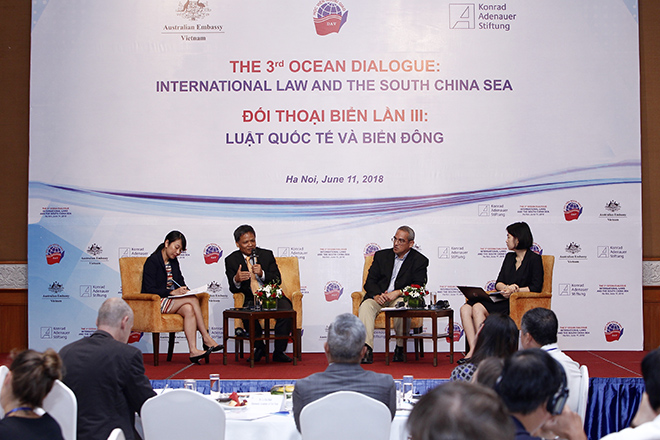 Approximately 80 participants attended the 3rd event in the Ocean Dialogue series on international law and the South China Sea held in Hanoi on Monday. The event, which was jointly held by the Diplomatic Academy of Vietnam (DAV), the Konrad-Adenauer-Stiftung (KAS) and the Embassy of Australia in Hanoi saw the attendance of experts from Vietnamese government ministries, academia, the Diplomatic community in Hanoi and Australian Alumni attended the Dialogue. According to the Australian Embassy, the Dialogue focused on recent developments in the South China Sea from a legal perspective and how stakeholders could cooperate to manage disputes in the region. The 3rd Ocean Dialogue is timely, as in the past months developments in the South China Sea have raised security concerns for countries in the region as well as other major stakeholders, the embassy said. China and ASEAN countries are currently negotiating the Code of Conduct of parties in the South China Sea (COC), attracting significant attention of legal experts and scholars. However, two years after the release of the Arbitral Tribunal Award in the case between the Philippines and China regarding the South China Sea, no significant improvement has been achieved to reduce disputes in the region. Speakers at the 3rd Ocean Dialogue discussed a wide range of legal issues concerning the South China Sea, including the rule of law, the status of structures in the South China Sea, the Arbitral Tribunal Award, the idea of “joint development” between states in the South China Sea, the Code of Conduct of parties in the South China Sea, and how to promote a common interpretation on international law in the South China Sea. In his opening speech, Dr. Le Hai Binh, Vice President of the DAV, highlighted the role of international law in maintaining rule-based international order. "International law is the backbone for international and regional security and stability," Binh stressed. "With regard to the South China Sea, all main stakeholders explicitly announced that they abide by international law. However, their different interpretations of the international law have been a major challenge for regional cooperation." Dr. Binh, therefore, contended that such dialogue would help promote shared understanding among experts, policy makers, and the wider audience, thus contribute to narrow perception gaps and facilitate cooperation in the South China Sea. Resident Representative of KAS, Peter Girke, underlined that rule of law and peace are core values of KAS and that “the South China Sea is in dire need to find joint and peaceful solutions respecting international law to settle the conflicts about territorial claims. We hope that the 3rd Ocean Dialogue discussion stimulated legal experts and policy makers to further think and work on international principles of law to address these disputes”. Speaking at the dialogue, Ms Stacey Nation, Counsellor (Political) shared that “The Australian Embassy is pleased to sponsor this Third Ocean Dialogue in support of a commitment made in Australia’s Foreign Policy White Paper to support a secure, inclusive and prosperous Indo-Pacific region in which the rights of all states are respected and in which disputes are resolved peacefully and in accordance with international law”. Vietnam, Mozambique further foster agricultural cooperation
Delegates to the conference on “Agricultural Cooperation Promotion between Vietnam and Mozambique” pose for a photo. A conference on “Agricultural Cooperation Promotion between Vietnam and Mozambique” was held in the capital city of Maputo, Mozambique, on June 11 by the Embassy of Vietnam to further foster the two countries’ partnership in this area. Opening the event, Vietnamese Ambassador to Mozambique Le Huy Hoang said the Government and people of Vietnam always attach great significance to developing ties with Mozambique and wants to strengthen the traditional bilateral relations and economic cooperation in key sectors, including agriculture. Hoang noted Vietnam looks to continue partnering with Mozambique and other African countries, thus contributing to ensuring food security and improving the local living standards. Mozambican Minister of Agriculture and Food Security Francisco de Marrule spoke highly of what the Government and people of Vietnam have done to develop the economy, ensure social welfare and gain a higher status in the international arena. Mozambique is blessed with large fertile land, favourable climate and long coastline for the development of agriculture and aquaculture, he said, adding that Mozambique is formulating new policies to facilitate foreign investors doing business in the country, particularly in agricultural production and processing. The minister welcomed Vietnamese businesses to enhance investment in Mozambique and suggested them focus not only on production of short-duration plants like rice and vegetables but also on high-value industrial crops such as cassava, cashew, coconuts and coffee. Speaking at the conference, Director General of the Agricultural Research Institute of Mozambique (IIAM) Olga Faftine highly valued the effectiveness of a joint project between the two countries to develop food crops in Zambezia province. Most of the objectives of the 2.2-million-USD project have been achieved, she noted. A group of Vietnamese experts have been sent to Mozambique to work with a local centre for agriculture studies to open about 50 training courses on techniques for cultivation of rice, soybean, sweet potatos and vegetables, she stated. Faftine proposed Vietnam continue supporting Mozambique in the second phase of the project to ensure its sustainable results. More efforts to enhance Vietnam-US comprehensive partnership
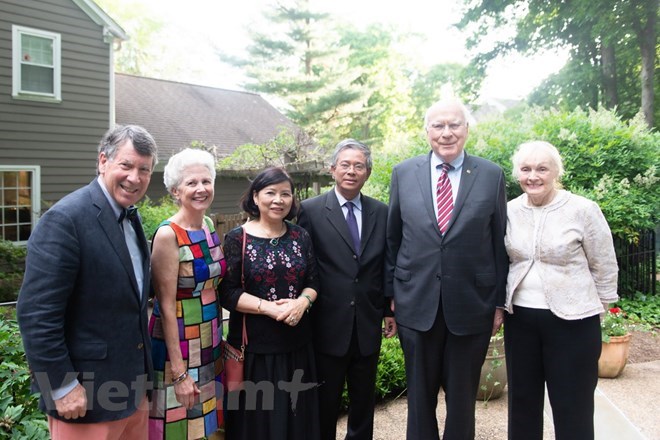 Vietnamese Ambassador to the US Pham Quang Vinh (middle), Senator Patrick Leahy (second, right) and US friends. Vietnamese Ambassador to the US Pham Quang Vinh has highlighted the significance of the development of the Vietnam-US comprehensive partnership in different fields. During his meetings with representatives of US agencies and friends last week, Vinh also talked about the success of high-level visits by leaders of the two nations over the past three years. At the meetings with Senator Patrick Leahy and US friends, Vinh thanked them for their valuable contributions to the enhancement of the comprehensive partnership. Vinh’s meetings with representatives of the US-ASEAN Business Council (USABC) and the US Chamber of Commerce (USCC) on June 5 and May 31, attracted the participation of many leading US groups and businesses which are operating in Vietnam. On this occasion, the USABC and USCC hosted farewell parties for the ambassador. The two agencies lauded efforts made by the diplomat during his tenure in the US and expressed their belief that the Vietnam-US ties will continue to develop strongly in the time to come. Vinh assumed the post as Vietnamese Ambassador to the US in late November, 2014. Over the past three years, the Vietnam-US relationship saw progress with numerous high-level visits, including the visit to the US by General Secretary of the Communist Party of Vietnam Nguyen Phu Trong in July 2015, the US visit by Prime Minister Nguyen Xuan Phuc in May 2017, and the Vietnam visits by President Donald Trump in November 2017 and President Barack Obama in May 2016. Son La, Laos’ Xaysomboun enhance collaboration 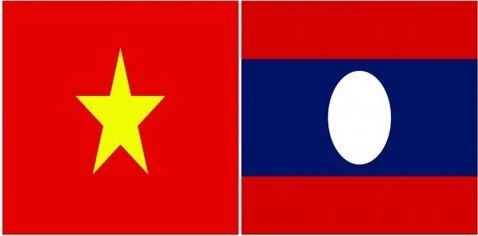 Secretary of the Son La provincial Party Committee Hoang Van Chat lauded a visit by Governor of the Lao province of Xaysomboun Thong Loi Silivong as an opportunity to raise mutual understanding during their talks in Son La on June 11. Chat briefed the guest on the local socio-economic development, Party building, external activities, and outstanding results in agriculture and investment attraction over the past time. He said over the past years, Son La has offered support to northern Lao provinces, including Xaysomboun, in building key facilities and developing agriculture with technical support, materials and varieties, and selling farm produce. Silivong, who is also Secretary of the provincial Party Committee, said Xaysomboun mostly relies on hydropower plants and agriculture and expressed his wish that the two provinces will share experience and support each other in the field. Both sides agreed to raise public awareness of the tradition of special friendship and solidarity, and comprehensive cooperation between Vietnam and Laos, and between Son La and Xaysomboun in particular. They will jointly hold major celebrations and exchanges and facilitate visits at all levels while enhancing partnership in agriculture, trade promotion, and sharing experience in the fields of culture, health care and education. Concluding the talks, the two sides signed a memorandum of understanding on cooperation for the 2018-2020 period, under which Son La will provide 5 billion VND (219,750 USD) to Xaysomboun to build a workforce training establishment. At current, 37 students from Xaysomboun are pursuing study in universities and colleges in Son La, contributing to strengthening the special friendship and comprehensive cooperation between the Parties, States and people of Vietnam and Laos, and between Son La and Xaysomboun in particular. HCM City leader meets outgoing UK ambassador Secretary of the Ho Chi Minh City Party Committee Nguyen Thien Nhan hosted a reception for outgoing UK Ambassador to Vietnam Giles Lever in the city on June 11. Nhan highly valued contributions of the UK Ambassador to the development of the two countries’ ties. He proposed that the UK assist Ho Chi Minh City in developing a smart city, noting that the city has planned to build an administrative centre in the Thu Thiem urban area and a contest on designs for the centre will be held soon. The municipal leader also hailed contributions of the UK ambassador in improving Vietnam’s legal system, including anti-corruption regulations. He underscored that the Vietnamese Government has paid due attention to transparency, while listening to public opinions and giving prominence to the role of the press in fighting corruption. Ambassador Lever noted that the UK-Vietnam cooperation has been deepened over the past four years in the traditional areas of trade and education, and expanded to other fields such as anti-corruption. He spoke highly of Vietnam’s efforts in strengthening the prevention and fight of corruption and encouraging transparency as well as the press’s involvement in anti-corruption, which is an important factor to avoid corruption. In late 2018, the UK will launch a programme to give technical assistance to Vietnam in improving business environment, intelligence property, capital management, and finance, he said. Lever added that Ho Chi Minh City is one of the 40 cities around the world receiving support from the UK to build smart cities. VNN |
↧
↧
Article 1
BUSINESS IN BRIEF 13/6 Da Nang sets economic goals towards 2030 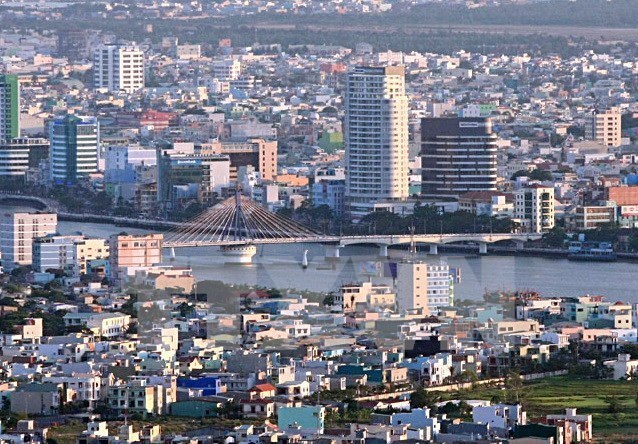 The central city of Da Nang aims to have the GRDP growth of 9 – 11 percent and GRDP per capita ranging between 7,000 USD and 9,000 USD for 2018 – 2030. The goals were mentioned at a workshop held by the municipal People’s Committee on June 11 to discuss the city’s development by 2030 with a vision towards 2045. The workshop gathered urban planners, economists and policy makers both at home and abroad. These experts shared hands-on experience from a number of local and foreign cities to give leaders of Da Nang a broader view of the city’s advantages, competitiveness, capacity to expand urban spaces in tandem with development of public transport, and how to build policies and raise capital for infrastructure development and develop the city sustainably. To meet the achievements, Da Nang plans to achieve strong economic growth with breakthroughs by promoting Industry 4.0 and international integration; develop a local and regional hub for startups, innovation and creativeness; strive towards industrialisation and modernisation to motivate the growth and integration of the central and Central Highlands regions. In addition, it will ensure social welfare, maintain defence, security, and marine sovereignty and have a civilised urban lifestyle. Da Nang is a young city with an area of more than 1,280 sq. km., including the Hoang Sa (Paracel) island district’s area, and a population of about 1 million people. The city is blessed with about 92 km of coastline and 11 public beaches. It looks to develop as a green, modern and smart city with unique identity. To realise the goals, the city and FPT, a Vietnamese software giant, in April inked a Memorandum of Understanding (MoU) on building Da Nang as a ‘smart city’ for the 2018-20 period. The MoU helps the city develop smart solutions in traffic, agriculture, English language training, health care and tourism. The two sides also agreed to complete online service in traffic and agriculture to boost connection between the city’s administration and local residents, as well as to promote transparency in administrative procedure. As planned, FPT will invest 15 billion VND (664,000 USD) to build pilot projects with smart applications in 2018-19. According to Vice Chairman of the municipal People’s Committee, Ho Ky Minh, the MoU will help Da Nang improve administrative reform and transparency for local people, businesses and tourists, and build Da Nang as a ‘liveable’ city in the near future. He said the city’s e-government system, which was launched in 2014, had been used by 225 agencies and 4,000 users. About 50 percent of public procedures were also posted online. He said Da Nang’s IT infrastructure was now available for smart connections among air control, water, garbage, meteorology, and energy agencies. It could also provide earthquake and tsunami warnings, and data on flooding, erosion, sewage management, and bridges. The city will be ready for 4G LTE (Long-Term Evolution) this year. The central city has provided 1,196 online administration procedures, including one-stop shops, residential management, public transport and water supervision through the e-government system. One more foreign investor flees from Hoa Sen Group Hoa Sen Group’s newest dissident is major foreign shareholder Tundra, which has officially sold 1.36 million stocks, equaling 0.4 per cent of the charter capital of one of the Vietnamese largest steel makers. zing.vn stated that foreign investor Tundra Vietnam Fund is not a large shareholder of Hoa Sen Group (code: HSG) since June 5, as its current ownership rate is 4.78 per cent (large shareholders are counted from 5 per cent). Tundra’s divestment from Hoa Sen Group took place as the HSG stock has increased value three times to reach VND12,850 on June 5, after hitting the low-point in the past 52 weeks at VND10,600 on May 31. It is estimated that Tundra could earn VND17.5 billion ($770,925) from the divestment. Many large shareholders of the steel giant have been completely divesting HSG despite the low stock price, as they were unoptimistic of the company’s future performance. Most recently, Tam Thien Tam One Member Ltd., managed by Hoang Thi Hoang Xuan (the wife of Hoa Sen Group’s chairman Le Phuoc Vu), sold its entire 19.24 million HSG shares, equaling 5.49 per cent of the charter capital. The transaction was performed with the value of VND230 billion ($10.1 million). In this February, Amersham Industries Limited sold 600,000 HSG stocks. The foreign investor made quite a deal, as the divestment took place quickly and earned about VND14 billion ($616,740). In 2014, Vietnam Enterprise Investment Ltd. sold 300,000 stocks. After the transaction, the firm retained 7.9 million HSG shares, equaling 2.25 per cent of Hoa Sen Group’s charter capital, officially leaving the group of the firm’s largest shareholders. In 2018’s first five months, Hoa Sen Group’s stock fell by 51.8 per cent, going from VND23,976 ($1.05) to VND11,550 ($0.5), scaring away shareholders. Thus, its market capitalisation was reduced by VND4.347 trillion ($191.4 million). The firm’s first quarter financial report shows that its revenue growth increased by 23 per cent on-year but profit only reached VND87 billion ($3.83 million), only one-fifth of the figure from the same period last year. Experts said that raising debts to maintain its market share (from 33.1 per cent in 2016 to 34.7 per cent in 2017) has reduced Hoa Sen Group’s rates of return. Hung Vuong Corporation reports loss of $12 million in second quarter Hung Vuong Corporation's (code: HVG) consolidated financial statement for the second quarter of this year showed falling business performance, while the price its stock goes for the same as a cup of road-side tea. Revenue from sales and services in the second quarter was VND2.58 trillion ($113.66 million), down 55 per cent on-year. Gross profit from sales and services was VND116 billion ($5.1 million), equivalent to the same period. Meanwhile, financial revenue was negative VND73.7 billion ($3.25 million) due to liquidating investment in subsidiaries. As a result, Hung Vuong lost over VND272 billion ($12 million), doubling its losses from the same period last year. Consolidated gross revenue in the financial year’s first half (between October 1, 2017 and March 31, 2018) was VND5.812 trillion ($256 million), down 40 per cent on-year. Revenue from the feed segment decreased by 15 per cent to VND1.473 trillion ($65 million), materials for animal feed processing reduced by VND1 trillion ($44 million) to approximately VND332 billion ($14.6 million), seafood declined by VND1.267 trillion ($55.8 million) to nearly VND768 billion ($33.8 million), while revenue of real estate increased to VND354 billion ($15.6 million). Thanks to the VND7 billion ($308,370) first quarter profit, accumulated losses of the fiscal year’s first half were VND264.7 billion ($11.66 million). Up to date, the total accumulated losses of Hung Vuong are VND749 billion ($33 million). With these bad business results, it is very hard for the "King of Pangasius" Hung Vuong to reach the VND800 billion ($35.2 million) profit target. Moreover, Hung Vuong is one of the companies most affected by the decision of the Department of Commerce (DoC) this year to apply export tax between $2.39 and $7.74 per kilogramme on pangasius. In a document sent to the State Securities Commission to outline its plans to overcome the accumulated losses in 2018, Hung Vuong revealed plans of entirely divesting from subsidiaries like Sao Ta Foods JSC (FIMEX VN), and selling half of Viet Thang Feed JSC (code: VTF), including 24 per cent already sold to VinEco in last March. This company will liquidate land plots at 765 Hong Bang and 94 Pham Dinh Ho in Ho Chi Minh City, as well as close some ineffective seafood processing factories due to a lack of materials. On the Ho Chi Minh City Stock Exchange (HSX), the price of HVG’s share is as cheap as a cup of tea at VND2.980, and Hung Vuong's capitalisation has been reduced to VND690.5 billion ($30.4 million). HVG’s share has been under supervision by HSX. HCM City publishes info on real estate investors’ mortgage loans HCM City is publishing information on activities of several real estate investors that have applied for mortgage loans secured by their property and land-use rights. The city said it wanted to provide customers with more information about what investors were doing with their properties. For instance, Hoang Phuc Real Estate Management Ltd applied for a mortgage loan for its The Western Capital project in District 6 with VPBank, while An Phu Long Real Estate Company applied for a mortgage loan for its D-Vela project in District 7 with the Joint-Stock Commercial Bank for Investment and Development of Vietnam. Several real estate experts noted that, as the property market in HCM City has become more active, it is normal to see many real estate companies applying for loans for projects and using their projects as their own security. However, there have been cases of companies using their mortgage loans for other projects rather than the projects used as security for those loans. In addition, some companies are using property currently owned by customers for mortgage loans, or are selling properties used as security to buyers. For example, many customers that had bought land plots in the Everluck Residence Project are involved in a dispute with the investor the Tuong Phong Real Estate Company. They said the company had not provided them with red books (house-ownership certificates) and had used land plots sold to customers as security for mortgage loans for the company’s other projects. The Everluck Residence project is seized for sales by a bank that Tuong Phong is borrowing capital, and many customers have voiced their complaints over the possibility of losing their land. Real estate customers have been urged to carefully investigate the reputation and capability of real estate investors before making decisions on buying property or land. Number of farm households in HCM City decreases: GSO The number of agricultural households has decreased gradually in HCM City, according to a recent report on results of the Rural, Agricultural and Fishery Census conducted by the General Statistics Office. It is due to increasing urbanisation, natural causes like climate change, and low incomes from farming, and many people working in the agricultural sector have switched to other vocations. Agriculture used to be an important sector that provided jobs for thousands of people in the city since 1986. But from around 2000 its importance began to decline, and the number fell from 140,045 workers then to 43,355 by 2016. By July 2016, the rate of agricultural households (farming, forestry, fishing) in the city fell to 6.8 percent. One of the reasons for the decline is the lack of government support for agriculture. Phan Quoc Hung of District 12 has grown orchids for 20 years. Recently, he and his father created an app to help grow fresh vegetables in plastic trays in apartment buildings. But he has not received any financial support from local authorities. He said: “I have invested about 1 billion VND (44,000 USD) in my farm. But I need 3 billion VND to develop my business.” To develop their aquaculture potential, Can Gio and Nha Be districts plan to have 6,000ha of shrimp farms. However, each hectare requires up to 700 million VND to develop, meaning many farmers are unable to afford them, and the plan remains unfulfilled. The city rolled out several policies last year to support agriculture, especially people investing in clean agriculture and those using high technology. A training programme has been instituted to train 3,000 agricultural workers in 2018- 2020. Nguyen Hai An, director of the High-Tech Enterprise Training Centre, said: “Our goal is to become the top service centre for high-tech agricultural production. Our centre will provide legal consultancy and training for potential agricultural companies.” Le Thanh Liem, Vice Chairman of the municipal People’s Committee, has instructed agricultural officials to draft a plan for developing agriculture from now through 2020. Vietnam Blockchain Chapter launched The Vietnam E-Commerce Association (VECOM) officially launched the Vietnam Blockchain Chapter (Vietblockchain) on June 8. Given the challenges and also opportunities presented by blockchain for the global digital economy and for Vietnam, VECOM has recommended the country accelerate its research and apply blockchain technology in the field of economics, as it is now considered a fundamental technology for a digital economy. VECOM therefore established Vietblockchain on April 23 and officially launched it at the Vietnam Blockchain Summit (VBS) on June 8, with the theme “From Technology to Policy”. According to Mr. Bui Trung Kien, Head of Vinaphone’s online sales business, the chapter will be involved in increasing information dissemination and conducting training. It will work with State management agencies and policy-making agencies on consulting on and reviewing policies as well as contribute to completing guidelines and legal norms to create a favorable environment for the research, development and application of blockchain technology in Vietnam. Vietblockchain will also coordinate businesses, especially e-commerce businesses, to improve the ability to connect applications and also use blockchain technology in VECOM’s activities to bring economic efficiency to members. It will also actively cooperate with other organizations and associations in training and guidance for students, the business community, and startups in Vietnam. Vietblockchain will be a venue for VECOM members and organizations and individuals interested in researching and applying blockchain technology. Fintech (financial technology) and fund raising, however, are not included in Vietblockchain’s activities. VECOM expects the chapter will contribute positively to the application of blockchain technology in many economic sectors from 2018 to 2020. Hai Duong exports about 9,500 tonnes of litchi The northern province of Hai Duong has exported about 9,500 tonnes of litchi from the beginning of this year’s crop, according to the provincial Department of Industry and Trade. The department said they shipped about 9,340 tonnes of litchi to China, 120 tonnes to the Republic of Korea, and 40 tonnes to Australia, the UK and France. Besides, the province sold 18,500 tonnes of litchi the domestic market, including major cities like Hanoi and Ho Chi Minh City, Hai Phong city, wholesale markets, trade centres and supermarkets. According the provincial Department of Agriculture and Rural Development, in 2018, Hai Duong has about 10,500 ha of litchi, mostly in Thanh Ha district and Chi Linh town, which are expected to yield about 60,000 tonnes. Of the total amount, some 1,000 tonnes is qualified for export to the US, Australia and the EU, he said. Currently, 131.68 hectares of local litchi cultivation are qualified for exports to the US, EU and Australia. The province is also home to 334 hectares of litchi grown in accordance with VietGAP standards. The harvest time is from May 15 to the end of June. Hai Duong litchi received the geographical indication from the Ministry of Science and Technology’s National Office of Intellectual Property in 2007. The local fruit was listed in the top 10 quality products in 2013 and 2014 and received the Gold Brand prize in 2015. The Vietnam Association of Food Science and Technology granted a “trustful and safe food brand” certificate to Thanh Ha litchi in 2016. The same year, the ancient litchi tree in Thuy Lam village was recognised as the oldest of its kind in Vietnam. Besides the domestic market, Thanh Ha litchi has increased its presence outside the country. The fruit has been exported to Australia, Canada, China, France, Malaysia, the Philippines, Singapore, Sweden, Thailand, the United Arab Emirates and the United States. Soc Trang secures nearly 123 trillion VND in investment Nearly 123 trillion VND (5.4 billion USD) will be poured into 47 projects in the Mekong Delta province of Soc Trang, focusing on renewable energy, wind power, solar power, high-tech agriculture, and tourism services. The information was heard at a press conference held in the locality on June 11. According to Vice Chairman of the provincial People’s Committee Ngo Hung, the province’s investment conference in 2018 will be held on June 19 to introduce local socio-economic achievements, investment potential and preferential policies. It will help mobilise both foreign and domestic capital for local rapid and sustainable development in the coming time, he said. A ceremony to launch the province’s startup programme and an agricultural development conference are scheduled for June 18. In April, a lot of investors operating in the fields of wind power, solar power and agriculture came to the locality to seek investment opportunities. The Ministry of Industry and Trade approved 22 locations with potential for wind power development in the province. These locations cover a total area of 35,740 hectares with plants holding a combined designed capacity of 1,470MW. Investors have made fact-finding tours and mapped out projects at the planned locations. 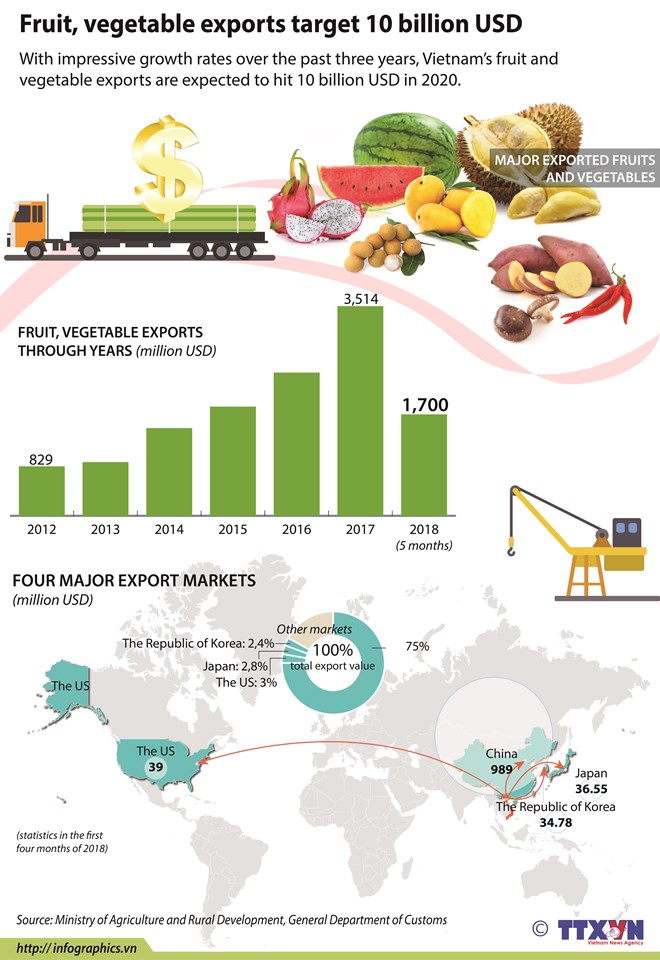 Catfish skin - a promising export Catfish is one of Vietnam’s major seafood exports with a turnover of 1.8 billion USD, and its skin, a waste product, is also being exported starting recently. Research is increasingly indicating that catfish skin has many nutritious substances that are good for health like collagen and gelatin. While processing, a plant produces five to eight tonnes of catfish skin daily. In the domestic market, it is sold at 10,000 VND (0.45 cent) per kilogramme for making animal feed, but since 2017, Co May Enterprise in the Mekong Delta province of Dong Thap has started exporting it to Singapore for 22,000 – 24,000 VND (around 1 USD) per kilogramme. In Singapore it is made into a snack and sold at 136,000 VND (6 USD) for a small pack of 230g. The company exports 50 -60 tonnes a month and plans to expand both the production of catfish and export of skin. It will also carry out research on demand in various markets like the EU, Singapore and Malaysia, and build a plant to make the catfish skin snack. Catfish processor Vinh Hoan has already built a plant for making 2,000 tonnes collagen a year from the skin. “Each kilogramme of collagen fetches 25 USD on the global market while catfish skin only fetches 1 USD,” a Vinh Hoan spokesperson said. The company earned 1 million USD from catfish skin exports last year, and plans to increase this to 5 million USD this year. With 2.6kg of catfish only yielding 1kg of fillet, the rest of the fish is considered waste and processing plants have the responsibility of disposing of 700,000 tonnes of it every year. The spokesperson said: “If the waste is taken and processed, it can bring a huge income to enterprises. Otherwise, it would become a burden on the environment.” The price of catfish fillet in the EU and the US is very low at around 2.6 USD per kilogramme, while the cost of processing has doubled, meaning profits are very low for exporters. Many are trying to diversify their products mainly targeting the domestic market. Besides the meat, the fat is processed for oil and the fish’s stomach is a popular dish, while other parts are mostly sold for making animal feed. Some of the other parts can be used to manufacture collagen and bio-fuel. Processing company Go Dang has built a plant to process all catfish wastes and exports them to the Republic of Korea, Singapore and China. But while there are 100 catfish processing plants in the Mekong Delta alone, there are still only a small number of plants processing wastes. “Relevant authorities should [help] increase exports of waste and deal with the environmental aspect,” the spokesperson added. HCM City: Home-businesses jump regulations More than a year after it rolled out support policies to help household businesses become enterprises, only 3,950 out of 250,000 have done so, the Ho Chi Minh City Department of Taxation has said. Tran Thi Thanh Phuong, Director of Phuong Cat Tax Agency, said that tax agencies have offered free tax registration and tax return filing services to new enterprises and household businesses, under the department’s programme to support new enterprises. Free counselling was offered in all districts, including outlying districts like Nha Be and Binh Chanh, she said. For new enterprises, registration and certain annual fees for the first three years are waived under the 2017 Law on Supporting Small to Medium Businesses. The city’s authorities have organised 250 counselling and encouragement events to raise awareness among people running household businesses. But only 3,950 have upgraded their business status, with many others being reluctant to become enterprises since it could entail paying higher taxes and social insurance. Mac Quoc Anh, Deputy Director and General Secretary of the Hanoi Small and Medium Enterprises Association, said some of the businesses might also want to remain being household firms since it would help them conceal their true income. Nguyen Nam Binh, deputy chief of the department, admitted that many of the owners may also not be fully aware of enterprise-related regulations and procedures such as enterprises registration and keeping proper records. Some household firms also find these regulations too complicated and prefer to stay small so that they do not have to deal with enterprise responsibilities such as obligations to employees or implementing regulations on environment, noise reduction or fire fighting. Nguyen Duc Nghia, head of the HCM City Taxation Agency Club, said tax procedures are too complicated and enterprises often have to hire service providers, adding that the procedures need to be simplified to make them easier for small and new businesses. Phuong said policies to support small and medium-sized enterprises are not well developed. According to the department, there are many household businesses that are more than capable of becoming enterprises, including over 420 that employ more than 10 staff, which is illegal according to the current law, 14,800 that use invoices and over 21,000 with monthly revenues of 50-100 million VND (2,200-4,400 USD). The city aims to have 1 million enterprises by 2020. Working with foreign retailers helps local firms boost innovation Thanks to their cooperation with multinational groups and foreign retailers, many Vietnamese businesses have been stepping up innovation to meet standards in both domestic and foreign markets, Deputy Minister of Industry and Trade Do Thang Hai said. At a workshop of AEON Vietnam’s suppliers in Ho Chi Minh City on June 11, Hai said promoting the presence of made-in-Vietnam products in modern distribution channels is now an important task of the industry and trade sector. The Ministry of Industry and Trade always creates the best possible conditions for multinational groups and retail firms, including Japanese-invested AEON Vietnam, to develop in the country, he affirmed. Hai urged AEON Vietnam to enhance coordination with local agencies to help improve the production and business capacity of domestic firms, as well as the quality of and requirements for Vietnamese goods, which, he said, is critical for the retail market of the country. Some market research agencies reported that in the local retail market, consumers’ habits are being modernised while businesses are adopting more methodological production and business models. As a result, companies are gradually improving their competitiveness and further engaging in global supply chains. Sharing the view, Vietnamese enterprises said boosting the purchase and export of goods through modern distribution channels create chances for them to change production and business models and better integrate into the world economy. Through the distribution networks of multinational groups and foreign retailers, Vietnamese products are sold in the domestic market as well as other potential markets where these firms have distribution systems, they added. Yasuo Nishitohge, General Director of AEON Vietnam, said after five years since it entered the Vietnamese market, AEON Vietnam has set up nine member companies operating in various fields and opened four trade centres. It is planning to inaugurate two other shopping malls in the capital city of Hanoi and the northern port city of Hai Phong and expand its shopping mall in Ho Chi Minh City’s Tan Phu district in the time ahead, he said. The firm is also going to open stores specializing in certain products like bread or bicycles, he said, noting that it wants to expand its investment and business network by cooperating with Vietnamese localities and companies. AEON Vietnam also hopes to enhance cooperation with domestic and foreign suppliers to serve local consumers and increase Vietnamese exports to Japan and other Asian markets, Nishitohge added. The workshop attracted 150 representatives of 75 potential suppliers in such industries as food, garment and household appliances. Viettel launches its 10th int’l mobile phone service in Myanmar The military telecom group Viettel has launched its 10th international mobile phone network, Mytel, in Myanmar. Mytel, the fourth mobile phone operator in that country, is the brand name of Telecom International Myanmar, a joint venture between Viettel and two local partners, Star High Public Company and Myanmar National Telecom Holding Public. It targets to become the biggest in the country in terms of both infrastructure and business. It is the only network with a customer service channel with video calling in Burmese, English and Shan, the language of the 6-million strong Shan people. Other networks only have Burmese and English. It already has in place more than 7,000 4G base transceiver stations (BTSs) and over 30,000km of fibre-optic cable that cover the entire nation, enabling it to provide a diverse range of services such as smart agriculture solutions (Nextfarm), traffic signal management system (Smart Light), an electronic wallet, route surveillance equipment and more. At the grand opening ceremony, Viettel Group announced its no-international-roaming-fees policy in Myanmar for its subscribers in Vietnam, Laos and Cambodia and vice versa, the first of its kind in the world. As of Mytel’s opening, Viettel Group’s registered overseas investment is over 2 billion USD. It has repatriated profits of 516 million USD to Vietnam. Ornamental fish production reaches higher standards The HCM City Fisheries Sub-department has selected four ornamental fish farms that meet conditions to produce ornamental fish under Good Manufacturing Practice (GMP) standards. The farms, Đồng Khởi Ornamental Fish Farm and Niềm Đam Mê Discus Farm in Củ Chi District, and AMR Farm and Xanh Tươi Ornamental Fish Farm in Bình Chánh District, produce ornamental fish for sale in domestic and foreign markets. The Đồng Khởi Ornamental Fish Farm, which covers 4,000 sq.m in Trung Lập Hạ Commune’s Xóm Mới Hamlet specialises in producing neon ornamental fish, tiger barb and rummy-nose Tetra for exports. The Niềm Đam Mê Discus Farm specialises in producing discus ornamental fish. The sub-department has provided the farms with quality techniques that meet standards and focus on environmental protection, disease prevention, quality of ornamental fish seed and fish feed. The city has exported 10.5 million ornamental fish worth US$12.7 million this year, up 14.8 per cent in volume and 10.6 per cent in value against the same period last year, according to the Department of Agriculture and Rural Development. The city has exported 60 more fresh water ornamental fish species. Of the figure, more than 40 species have been produced artificially, while the rest are caught from rivers and springs. Exports of marine ornamental fish, which have high value, account for 1 per cent of the city’s ornamental fish exports. The city’s ornamental fish is exported to the EU, Asia, America, and South Africa. Two ornamental fish trading areas are located on Nguyễn Thông Street in District 3 and Lưu Xuân Tín Street in District 5. Võ Thanh Liêm, owner of the Dã Tượng ornamental fish shop on Lưu Xuân Tín Street, who has been in business for many years, said the sector is developing strongly. Wholesale traders in other provinces and cities in the country are visiting HCM City to buy ornamental fish. Discus ornamental fish tops the city’s list of ornamental fish exports, which has been identified as a key product of the city’s agricultural sector. The city, which is the country’s largest ornamental fish producer, has about 88ha of land devoted to raising ornamental fish in outlying districts, with more than 290 households involved in production. The Sài Gòn Ornamental Creatures Co-Operative in Củ Chi District has worked closely with 80 local ornamental fish farming households to have a stable quantity of ornamental fish for exports. The co-operative exports about 1.9 million ornamental fish a month. Nguyễn Văn Thủy, chairman of the co-operative, said that demand for ornamental fish huge from both domestic and foreign markets. The hobby of breeding ornamental fish is no longer limited to those with high incomes, as average-income people can now join in the trade, he added. Vietnamese sticky rice sees price reduction The prices of Viet Nam’s sticky rice are facing a downward trend due to its over-supply and dependence on a single large market, according to the Department of Farm Produce Processing and Market Development under the Ministry of Agriculture and Rural Development (MARD). Although it is now the beginning of the harvest of the summer-autumn crop, the sticky rice farmers are quite passive because they have few orders and few prospective buyers. The statistics of Viet Nam Food Association (VFA) showed that, in 2017, Viet Nam exported 1.4 million tonnes of sticky rice, mainly to China. Last year, as Viet Nam was expanding sticky rice production, China also quickly increased sticky rice cultivation. The current inventory of Chinese enterprises is quite large; therefore, promoting the export of sticky rice to China’s market in the near future is impossible, a sticky rice exporter to China revealed. Due to the declining demand for sticky rice, its price declined sharply from US$530-540 per tonne in January-February to $460-470 at the moment. The domestic sticky rice price also fell sharply compared to other types of rice. In contrast, the consumption of fresh rice IR50404 in the last winter-spring crop in the Mekong Delta has been quite "smooth". Domestic supply is not sufficient to meet all export contracts. Therefore, prices of IR50404 rice in this region have continuously risen, setting the highest record in recent years. In some periods, the price of fresh rice IR50404 in the field was purchased by traders at a price of nearly VND6,000 per kg, up VND1,000 per kg compared with the peak price of 2017. The export price of this type of rice also rose significantly, higher than the price for rice from Thailand, India and Pakistan. Looking at the contrast between the two types of rice, it is clear that the current crop structure in the country’s largest granary is not yet flexible enough to quickly adapt to meet market demands. Dang Thi Lien, director of Long An Foodstuffs Company Limited, said that the problem of sticky rice cultivation has been discussed already. In the recent winter-spring crop, as her firm realised it was heavily dependent on the Chinese market, it called for farmers to shift their sticky rice cultivation to high quality rice variety Dai Thom 8 and agreed to collect all the output. However, farmers wouldn’t follow through, believing that the sticky rice market will recover soon. According to Lien, warning enterprises is not enough; persuading growers to switch requires the participation of State management agencies as well as support from the press. In order to avoid the oversupply of sticky rice and the undersupply of other types, MARD should coordinate with the Ministry of Industry and Trade (MoIT) and the VFA to study the import market and the demand for each type of rice. Then they can provided information to farmers, enterprises and localities to make adjustments before the planting season, she suggested. An expert in agriculture, Vo Tong Xuan, said market demand varies from year to year. This year, Indonesia and the Philippines are increasing imports, but it’s not certain that next year they will continue to import. Indonesia, for example, has not been importing rice for the past few years, but suddenly announced its purchase of 500,000 tonnes in early 2018. Therefore, the Viet Nam Trade Commission in the countries should collect and supply information on the market demand of the host country to the MARD and MoIT for synthesis. From there, it is possible to analyse market demand. In addition to providing market forecast information, some enterprises said that in order to improve the competitiveness of the rice industry, the State should have appropriate mechanisms and policies for businesses and farmers to actively approach the source of raw materials for export. Vinalines Logistics targets 10% profit growth in 2018 Vinalines Logistics Viet Nam Joint Stock Company targets a total revenue of more than VND3.5 trillion (US$153.2 million) and a pre-tax profit of VND22 billion in 2018. The figures mark a year-on-year increase of six per cent and 10 per cent, respectively. This was revealed in a company document ahead of the 2018 shareholders’ meeting on June 15. The firm also plans to produce 51,000 TEUs (twenty-foot equivalent units) of commodity output and a dividend yield of seven per cent. According to Vinalines Logistics’ leaders, the market will face many difficulties in 2018 due to fierce competition from domestic and foreign competitors; therefore, the company intends to maintain a profit growth of three to five per cent compared to 2017. The goal in 2018 is to improve the quality of logistics services and expand the business area to upgrade the Vinalines Logistics brand within and outside the country. Also in 2018, Vinalines Logistics will complete the final step to operate Vinalines Hoa Lac Logistics Joint Stock Company and deploy necessary procedures to build a warehouse, yard systems and a logistics centre at the Hoa Lac High Tech Park. Last year, the firm recorded a total revenue and pre-tax profit of nearly VND3.29 trillion and VND19.8 billion, respectively. Thai Nguyen seeks investment in 65 projects The northern province of Thai Nguyen will publish a list of 65 projects calling for investment at the investment promotion conference to be held here on July 1. Fifteen of these projects are related to the industry sector, 19 to the agriculture sector, 12 to the trade, culture, sports and tourism sectors, 15 to transport and urban area development, while the remaining are related to healthcare and education. Among these projects are the infrastructure developments of 10 industrial clusters such as Quyet Thang, Ba Xuyen, Nam Hoa and Kim Son; a 220ha hi-tech farming in three communes of Tan Duc, Uc Ky and Xuan Phuong, a hi-quality tea processing plant covering 100ha in Dai Tu District and Dong Tam Dao eco-tourism complex spanning 5,000ha in two communes of Thanh Cong and Phuc Thuan. Others include a 3ha agricultural and food market which will be home to 2,000 traders in Thai Nguyen City and Song Cong II urban area and service complex in Song Cong City. In the past few years, Thai Nguyen has provided many incentives to investors, including those in land rental and clearance, infrastructure development, corporate income tax and others in trade promotion, personnel training and IT appliance and transfer. The province has also drawn up a scheme on improving its investment climate from now until 2020, with a focus on speeding up administrative reforms, building new investment policies and attracting more investment capital. In the first five months of this year, the province granted in-principle investment approvals to five projects, expected to cost more than VND3.4 trillion (US$124 million). It also licensed eight others, capitalised at VND1.8 trillion ($79 million). Currently, the province is home to 900 valid projects with a total investment capital of some VND15 trillion ($658 million). Of these, 120 are foreign-invested, valued at $7.2 billion. During a working session with Deputy Prime Minister and Foreign Minister Pham Binh Minh late last week, provincial leaders proposed that the ministry support the introduction and connection with foreign diplomatic missions, international organisations, investors, business associations and potential foreign enterprises to help promote investment in the province. For his part, Minh urged the ministry’s agencies and other relevant units to co-ordinate with Thai Nguyen’s departments and agencies to prepare for the upcoming investment promotion conference. He also suggested the province focus on calling for investment in key areas as well as the best commitments on preferential policies for investors. VIB launches premium World MasterCard credit card Vietnam International Commercial Joint Stock Bank (VIB) last week launched a premium credit card - VIB World MasterCard. The card provides special offers on dining, travelling, relaxing and shopping to cardholders who often go on business or travel aboard. By now, banks in Viet Nam have introduced many kinds of credit cards designed to meet the needs of each group of customers, ranging from common consumers to businesspeople. “VIB World MasterCard credit card has been designed for the convenience and benefits of cardholders, specifically those who often travel within the country or abroad, be it for personal or business reasons,” VIB said in a statement. VIB World MasterCard cardholders can use a credit limit of up to VND1.2 billion (nearly US$53,000), with an interest rate of zero per cent within 55 days. Cardholders can get many offers at airports, such as free services up to four times per year in more than 850 VIP lounges around the world, and save while purchasing products or services from more than 400 of VIB’s partners that have eateries, spas and shopping stores at airports. To mark the launch of the credit card, the bank will give 140 Accor Plus membership cards to VIB World MasterCard cardholders with the highest value of monthly spending. With the Accor Plus card, travellers can avail a free night stay in one of the 700 hotels and resorts in 18 Asia-Pacific countries, including Viet Nam. Seven trips to Singapore worth VND50 million each will also be gifted to cardholders who have the highest value of total monthly transactions. Vingroup to produce smartphone Vsmart Property developer Vingroup on Tuesday announced its plan to produce electronic equipment, starting with the smartphone brand, Vsmart. Implementing the strategy to expand its industrial production sector following VinFast’s automobile and electric motorbike manufacturing project, Vingroup has set up the VinSmart Joint Stock Company with a charter capital of VND3 trillion (US$131 million). VinSmart will operate in two main areas: one is the production of smart electronics and the second is researching, experimenting and applying artificial intelligence (AI), automation and new generation materials. Vsmart’s production plant will be built in accordance with international standards at the VinFast automobile and electric motorbike manufacturing complex in Dinh Vu-Cat Hai industrial park in the northern port city of Hai Phong. In terms of technology, Vingroup is working with the world’s leading consulting firms to hire design consultants, seek qualified professionals, acquire design licences for smartphone components and purchase equipment for telephone production. The co-operation with leading partners will ensure that the smartphones are manufactured by using the most modern and advanced technology to optimise efficiency and ensure product quality. In its second area of operation, VinSmart will also actively study and buy the copyrights of inventions and experiments in Viet Nam to bring these innovations to life. Nguyen Viet Quang, vice chairman cum general director of Vingroup, said the group wanted to invest significantly in the research and application of new technologies to contribute to the emergence of Viet Nam on the world’s technology map. Participating in high-tech and complex sectors, such as smartphone manufacturing, confirms Vingroup’s determination to move towards knowledge- and science-based production that contributes to improving productivity of the domestic economy, Quang added. By manufacturing smartphones and engaging in experimental research and application of advanced technologies, Vingroup not only plans to build a new future for the Vietnamese industry, but also contribute to the building of a solid knowledge-based economy by capturing the opportunities for growth from the fourth industrial revolution. VNN |
↧
Article 0
Social News 13/6 (Hourly Updated) Son La: 20 bricks of heroin, 17,000 synthetic pills seized
Ly La was arrested for carrying 20 bricks of heroin from Laos to Vietnam. (Photo: VTV) A man carrying 20 bricks of heroin was arrested on June 12 in Chieng Khuong village, Chieng Khuong commune, Song Ma district, the northern mountainous province of Son La. The arrest was carried out by the provincial police in collaboration with the Chieng Khuong border guard station and customs. The arrested is Ly La or No La, born in 1992, and resides in Long Ku village, Vieng Say district, Houaphan province of Laos. Ly La said he was hired by a strange man to transport the drug from Laos to Vietnam. On June 11, the Son La police and relevant authorities arrested Mua Thi Keo, born in 1996, for illegal trade of drugs, seizing 17,000 synthetic drugs and related evidence. Keo resides in Vieng Say district, Houaphan province of Laos. The cases are under investigation. Kien Giang strives to recover, develop coastal protection forests
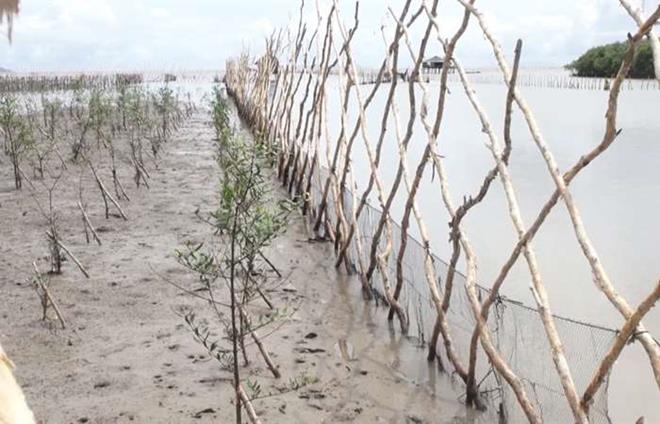 Kien Giang province has gained initial encouraging outcomes in recovering and developing its coastal protection forests amid coastal erosion and climate change worsening across the Mekong Delta region (Photo: thst.vn) Kien Giang province has gained initial encouraging outcomes in recovering and developing its coastal protection forests amid coastal erosion and climate change worsening across the Mekong Delta region. According to the provincial Department of Agriculture and Rural Development, Kien Giang has a 200-km coastline, stretching from Mui Nai in Ha Tien township to Tieu Dua of An Minh district. The eroded sections are about 70km long in total, accounting for more than one-third of the coast length, seriously affecting local people’s production and daily life. Kien Luong, Hon Dat, An Bien and An Minh districts record the most severe coastal erosion. Facing this problem, 13 projects have been built in Kien Giang to protect the marine environment, prevent coastal erosion and natural disasters and respond to climate change between 2016 and 2020. Among them, the project on recovering and developing coastal protection forests has initially generated positive outcomes. It has been carried out along the 60km-long coast from Mui Ranh in Tay Yen commune, An Bien district, to Tieu Dua canal in Van Khanh Tay commune, An Minh district. Tran Phi Hai, Director of the An Bien – An Minh forest management board, said two sub-projects are underway to recover and develop protection forests long the coast and create the ground for planting submerged water plants to protect sea dykes. Coastal alluvial grounds have been afforested with about 290 hectares of “mam” (Avicennia) and 88 hectares of “duoc” (Rhizophora apiculata) trees. At least 85 percent of the newly planted trees have survived, helping to recover coastal protection forests and reduce coastal erosion. These forests have also helped speed up sea encroachment and protect forestry and fishery production behind the protection forests, he noted. Hai added his management board also surveyed areas subject to the afforestation along the An Bien – An Minh coast. Accordingly, eligible areas will be planted with Avicennia trees, a species able to keep land and create alluvial grounds to support the development of other submerged plant species like “duoc” (Rhizophora apiculata), “ban” (Sonneratia caseolaris), “su” (Aegiceras corniculatum) and “vet” (Bruguiera gymnorrhiza). Meanwhile, bamboo or cajeput barriers will be erected on the edge of vulnerable areas to create alluvial grounds for planting Avicennia trees. Aside from these two sub-projects, the An Bien – An Minh forest management board will also implement some other projects funded by the World Bank and the KfW bank of Germany. These projects also aim to recover and develop coastal protection forests in the two districts. Binh Thuan ensures safety for tourism activities The People’s Committee of the central coastal province of Binh Thuan has instructed relevant agencies and localities to ensure security, order and safety for tourists in the province, said a local official. Vice Chief of the Office of the People’s Committee Vo Thanh Huy said on June 12 that communication work has also been stepped up so that tourists will not be incited to participate in activities affecting security, and social order and safety. The provincial Department of Culture, Sports and Tourism has sent a document to the tourist association and notices to tourist accommodations and sites, asking them to reinforce security to absolutely protect property and life of holiday-makers on major tours in the locality. Security guards and fire fighters have been increased to promptly deal with unexpected situations, ensuring safety for vacationers and assets of businesses. The south central coastal province of Binh Thuan aims to develop sustainable tourism to become a national and regional tourism attraction. It has 192 kilometres of coast with beautiful beaches, landscapes, clean environment, national historical – cultural relics and festivals. As of the end of 2017, the province had 390 tourism projects, worth 63.5 trillion VND (2.79 billion USD), covering 7,400 hectares. It is home to more than 300 tourist accommodations, with 11,000 rooms and over 500 villas and apartments for tourists. The locality expects to welcome around seven million tourists by 2020, contributing 10 percent to provincial GRDP. USAID-funded project helps minimise plastic waste in Thua Thien-Hue 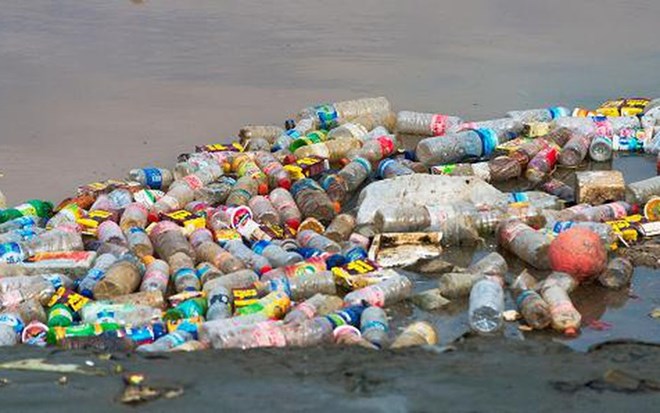 The US Agency for International Development (USAID) has provided a non-refundable assistance package worth 53,858 USD for the central province of Thua Thien-Hue to implement a project to recycle urban waste. The two-year project aims to improve the ecological environment and minimise pollution caused by plastic waste in Hue city, rivers and coastal areas of the province. It is also hoped to contribute to raising public awareness of negative effects of plastic waste on the environment, as well as the importance of promoting efforts to protect the environment. The project features a workshop on measures to reduce waste on Huong River and waterways, campaigns to collect waste on local beaches, a waste classification programme, and contests to gather initiatives for protecting the environment. Previously, Truong Son Xanh (Green Annamites) Project, also funded by USAID with total investment of nearly 10 million USD, was launched in Thua Thien-Hue on April. The project supports the locality in protecting the region’s globally significant biodiversity and help local and ethnic minority communities to diversify and improve their livelihoods. It targets improving the livelihoods of 20,000 forest dependent people and the biodiversity of over 400,000 hectares of natural forest, mobilising at least 20 million USD in public and private resources for sustainable livelihoods and forest conservation, and avoiding and/or removing the equivalent of at least 7 million metric tons of carbon dioxide from the atmosphere. Over 1,500 delegates to attend Hanoi 2018 conference
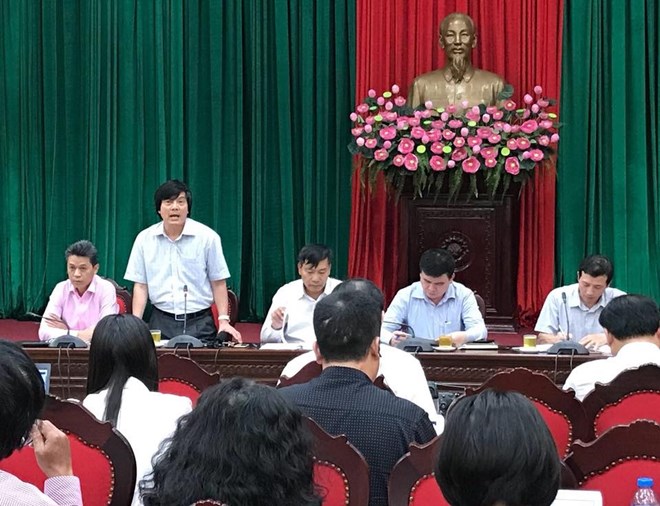 Vice Director of the Department of Information and Communication of Hanoi Nguyen Minh Khanh speaks at the press conference (Source:http://hanoimoi.com.vn) Over 1,500 delegates, including Government, ministry, sector and locality leaders, representatives from international organizations and diplomatic agencies, investors, and businesses are expected to attend the conference “Hanoi 2018- Cooperation, Investment and Development”. The conference is scheduled for June 17, Vice Director of the Department of Information and Communication of Hanoi Nguyen Minh Khanh said at a regular press conference of the Hanoi Party Committee on June 12. At the conference, ministry, sector, industry, and locality leaders and businesses will work to seek to attract investment into Hanoi, together with discuss joint projects, regional connectivity, and Hanoi’s leading role in steering the development in other regions. The capital city will review its cooperation outcomes with other provinces and cities in 2016 and 2017 and will introduce its key goals and projects calling for investment in the 2018-2020 in Hanoi and other provinces and cities in the region. At the conference, memorandums of understanding on cooperation in smart city building, tertiary education, high-tech agriculture, healthcare, tourism and environment and investment certificates will be handed over while individuals, organizations and local and foreign businesses having contributed to spurring Hanoi’s socio-economic growth and regional connectivity will be honoured. Through the conference, Hanoi’s authority will continue affirming their effort to unceasingly improve the investment environment in compliance with the international integration process, provide the best optimal conditions for investors and businesses’ long-term operations, and seek to create connectivity between the city and the northern key economic region, the Hong (Red) River delta and Capital regions. Short-film making contest on illegal wildlife trade launched 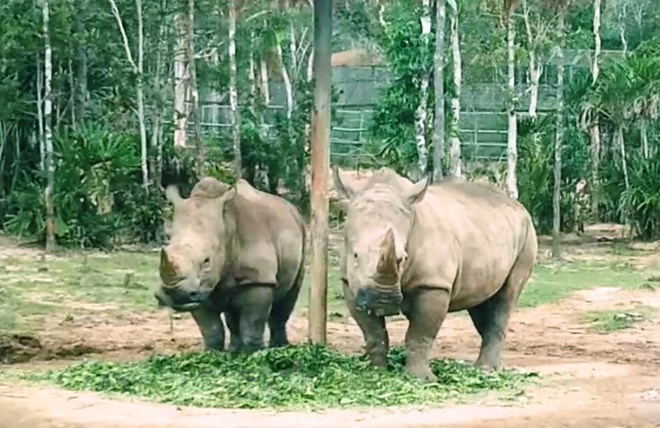 The UK Government, in conjunction with the Luang Prabang Film Festival, the World Wildlife Fund (WWF) and the Wildlife Conservation Society (WCS), has launched a short-film making contest on illegal wildlife trade, said the UK Embassy in Vietnam on June 12. The contest aims to raise awareness of the public and policy makers of the importance of protecting endangered species, thus increasing specific actions to protect wild animals as well as of devising relevant sustainable and long-term measures for countries along the Mekong River. It is available for all filmmakers in the region, with each entry will not be over 6 minutes. The best filmmaker will be awarded a prize worth 5,000 USD, and be invited to attend the International Conference on Illegal Wildlife Trade in London in October and the Luang Prabang Film Festival in December. Apart from professional filmmakers, students are also encouraged to participate in the contest as youths play an important role in creating changes. More information about the contest can be found at http://www.lpfilmfest.org/content/IWTMekong.html The deadline for submission is August 15, 2018. Ministry submits plan to give presents to revolutionary contributors 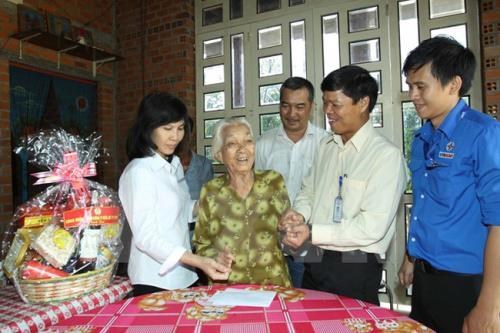 The Ministry of Labour, Invalids and Social Affairs (MoLISA) has proposed a plan on giving presents to people with meritorious services to the country’s revolution on the occasion of the 71st anniversary of War Invalids and Martyrs Day (July 27). Under the plan, which will cost more than 355.4 billion VND (over 15.5 million USD), gifts worth 400,000 VND (17.5 USD) each will be presented to Vietnamese heroic mothers; war invalids and sick soldiers who have lost 81 percent or more of their working capacity; veteran revolutionaries who lost 81 percent or more of their working capacity due to exposure to toxic chemicals during the war; and fallen soldiers’ next of kin who enjoy monthly daily living allowances. Meanwhile, gifts worth 200,000 VND (nearly 9 USD) each will be distributed to war invalids and sick soldiers who have lost 80 percent or less of their working capacity; veteran revolutionaries who lost 80 percent or less of their working capacity due to exposure to toxic chemicals during the war. Prime Minister Nguyen Xuan Phuc authorized the Minister of Labour, Invalids and Social Affairs to submit the plan to the President for approval. The total amount of money for the gifts donation will be sourced from the 2018 State budget. More than 100 works win 12th National Press Awards
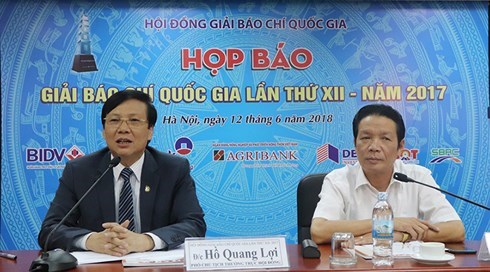 Standing Vice Chairman of the Vietnam Journalism Association Ho Quang Loi (L) at the press conference (Photo: kinhtedothi.vn) As many as 105 media works winning the 12th National Press Awards 2017 will be honoured at an award ceremony in Hanoi on June 21, the Vietnam Revolutionary Journalism Day. The winning works include eight A prizes, 25 B prizes, 43 C prizes and 29 consolation prizes, heard a press conference in Hanoi on June 12. According to Ho Quang Loi, Standing Vice Chairman of the Vietnam Journalism Association and Vice Chairman of the Council of the National Press Awards 2017, the council decided to raise the prize values from the 2017 season, with each A prize winner receiving up to 100 million VND (4,400 USD). The 12th National Press Awards attracted 1,753 entries from 155 press agencies and individuals across the country. There was no big difference in the quality between works of central and local press agencies, Loi said, noticing that reportages and documentaries made by local reporters were highly appreciated. Regarding the 2018 edition, Loi underlined that a special prize will be chosen from A prizes and it will be kept secret until the award ceremony. A confidential group of critics will be set up to give further evaluation of the works entering the final round. After 12 years of organisation, the National Press Awards has attracted the proactive participation of press agencies and journalists nationwide. The event aims to honour authors and group authors with excellent media works. Two more prosecuted in Đông Á Bank case
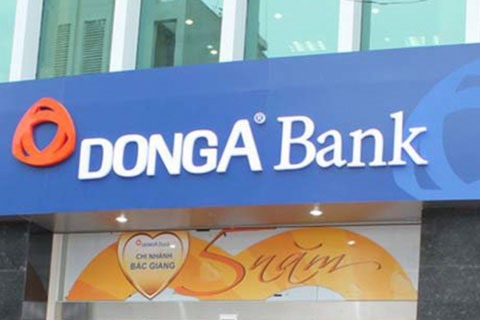 The Ministry of Public Security announced yesterday legal proceedings against two more people related to the ongoing Đông Á Bank corruption case.— Photo thoibaonganhang.vn The Ministry of Public Security announced yesterday legal proceedings against two more people related to the ongoing Đông Á Bank corruption case. The newly-announced proceedings were against Phạm Văn Phước, former director of Nam Định Food Joint Stock Company, for “abusing position and power to appropriate properties”, and Nguyễn Thị Cúc, former head of Đông Á Bank’s Control Unit, for “lack of responsibilities causing serious consequences.” Phước has been detained for investigation while Cúc has been forbidden from leaving her residential area. The Đông Á Bank case is under the supervision and instruction of the Central Steering Committee on Anti-Corruption. The case has led to legal proceedings against 25 suspects and confiscated property worth VNĐ2.8 trillion (US$124.4 million). Decreasing use of methadone in rehab
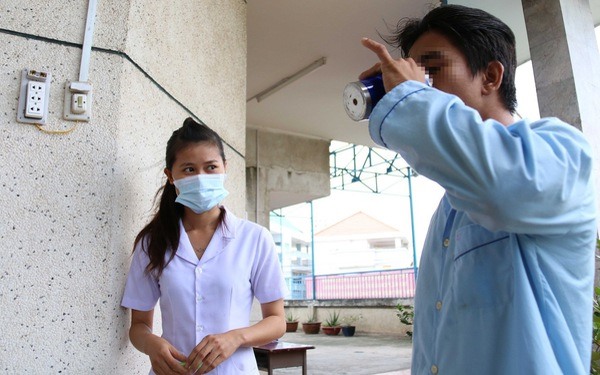 Just 1,300 people are still using methadone in drug rehabilitation treatment out of a total of more than 3000 registered patients.– Photo tuoitre.vn Just 1,300 people are still using methadone in drug rehabilitation treatment out of a total of more than 3000 registered patients. By the end of May, in the northern province of Sơn La, two thirds of those receiving treatment had stopped using methadone to treat morphine addiction, with the exception of 43 dead patients, the Vietnam News Agency reported. “The Sơn La Department of Health has already established a technical assistance team to distribute methadone to the communes’ centres. However, the distance from the villages to the centres is quite far, and as such many patients have simply given up,” said Nguyễn Thị Kim An, Vice Director of the Sơn La Department of Health. The main reason for this could be because the mountainous terrain makes patients unwilling to travel to the healthcare centres. In Sơn La Province, 13 rehab stations are equipped to treat morphine addiction, 12 of which are located in wards, and one in Sơn La City. As many as 51 communes’ clinics are allowed to treat by addiction with methadone. Many patients proposed that methadone be distributed to their doorsteps instead. Swine flu victim discharged from Đắk Lắk hospital
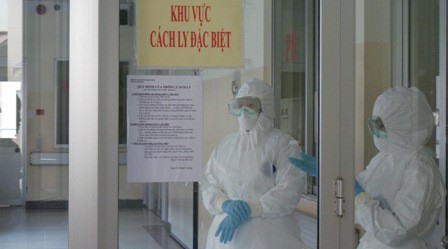 Đắk Lắk’s Department of Health discharged a patient from hospital yesterday who had been diagnosed with swine flu A/H1N1 10 days ago.— Photo dantri.com.vn Đắk Lắk’s Department of Health discharged a patient from hospital yesterday who had been diagnosed with swine flu A/H1N1 10 days ago. Lê Thị Kim Trang, 41, from Cuôr Knia Commune in Buôn Đôn District, was hospitalised on June 3 suffering from stomach pains, vomiting and diarrhoea. She was diagnosed with a gynaecological disease and transferred to Từ Dũ Hospital in HCM City for treatment, where she contracted A/H1N1. Phạm Văn Lào, director of the Đắk Lắk Preventive Medicine Centre, said that Trang was quarantined and treated based on health and safety regulations. Cần Thơ General Hospital also announced yesterday that it has been treating the first swine flu A/H1N1 in the Cửu Long (Mekong) Delta this year. The 84-year-old patient was taken to hospital on June 8 after five days of treatment for high blood pressure at a medical station in the southern province of Vĩnh Long. Doctors said that her condition was improving, however, three medical workers are being monitored after showing symptoms of the virus. Vừ A Dính Scholarship Fund raises $1.3 million
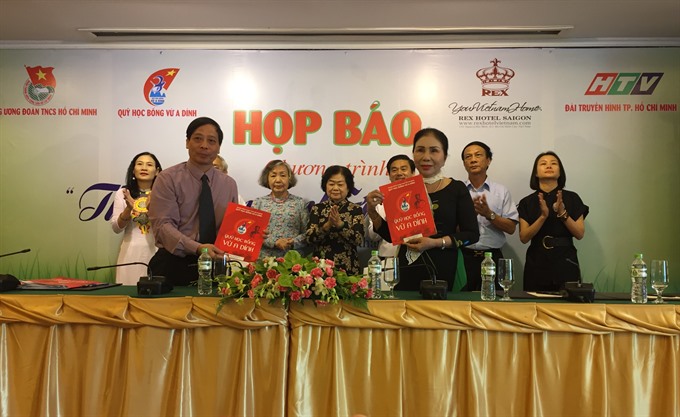 A representative of the Vừ A Dính Scholarship Fund signs agreements with donors in HCM City on June 12. The HCM Communist Youth Union’s Vừ A Dính Scholarship Fund said it has attracted donations of nearly VNĐ29 billions (US$1.3 million) from 37 local and foreign organisations and individuals this year. Since its inception in 1999 the fund has provided scholarships to 80,000 disadvantaged students in mountainous regions and islands, Trương Mỹ Hoa, former vice president of Việt Nam and the chairwoman of the fund, told a press conference in HCM City yesterday. She thanked the donors and praised the efforts of the students who have benefited. “The projects [carried out by the fund] reflect great humanitarian and social values and responsibility towards the community.” The projects include Ươm mầm tương lai (Nurturing The Future) in collaboration with private schools in HCM City, which has helped disadvantaged ethnic students continue studying. There have also been Mở đường đến tương lai (Opening Paths to The Future) to award scholarships to ethnic minority girls to enable them to complete high school and tertiary courses, and Chắp cánh ước mơ (Giving Wings to Your Dreams) to provide monthly support to disadvantaged until they finish their high school and tertiary education. Thắp sáng tương lai (Brighten The Future) has funded construction of schools, bridges, roads, and clean water supply works in deprived localities inhabited by ethnic minorities. In 2014 the fund launched the Club for Beloved Hoàng Sa and Trường Sa to support fishermen and soldiers protecting the country’s sovereignty in the East Sea by donating houses to them and offering scholarships and healthcare support for their children. On June 16 a programme called Thắp sáng những ước mơ (Brighten Your Dreams) will be organised in HCM City to present Vừ A Dính Awards to nine outstanding collectives and 13 ethnic minority individuals for making important contributions to the community. HCMC hosts 2nd World Skin Summit
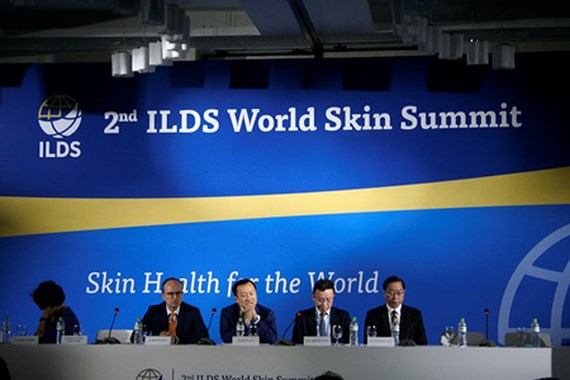 The Second World Skin Summit was held yesterday in Ho Chi Minh City (HCMC), co-organized by the Vietnam Dermatological Society and the HCMC Skin Hospital. The World Skin Summit is a forum to share and discuss issues related to the design and development of strategies to improve skin health in all levels, ranging from grassroots to international scale; the current international challenges in skin care; the research on rarely seen skin diseases; and the health care for patients in remote areas with limited medical resources. According to Professor Doctor Tran Hau Khang, Director of the Vietnam Dermatological Society, the organization of the 2nd World Skin Summit is a good opportunity for domestic doctors to meet and exchange knowledge with their international counterparts, helping them to easily integrate with the medical community in the neighborhood as well as in the world. This, in turn, will aid in the development of suitable strategies for the medical growth of Vietnam. As said by Prof. Dr. Tran Hau Khang, the Vietnam Dermatology Society has been a member of the International League of Dermatological Societies (ILDS) since 2011. It has offer many chances for Vietnamese doctors to widen their knowledge, skills, and experience via training and discussions, which sequentially help the growth of the dermatology field in the country. In this event, the ILDS will summarize and evaluate achievements of its members, followed by necessary recommendations, including plans and directions for many new strategies and projects, in order to come closer to the fulfillment of the goal ‘For skin health in the world’. Taking part in the 2nd World Skin Summit were Professor Doctor Tran Hau Khang, Director of the Vietnam Dermatological Society cum Deputy Director of the Asian Dermatological Society; Professor Doctor Nguyen Tan Binh, Director of the HCMC Department of Health; and more than 200 delegates from 30 nations worldwide as well as members of the ILDS. Vietnamnese surgeons save French man from myocardial infarction Surgeons are carrying out the operation to save the French man
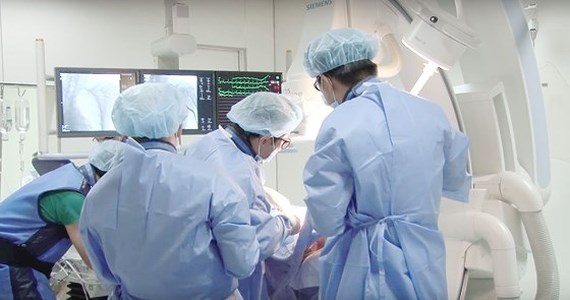 Hoan My Cuu Long Hospital in the Mekong delta city of Can Tho yesterday announced its surgeons saved a French man who had myocardial infarction A 69-year-old man with French national went on a sightseeing tour with his wife in the Mekong delta. In the mid night, he suddenly suffered the heart attack; accordingly, he was taken to the hospital. he was diagnosed to have acute myocardial infarction, he underwent a coronary stent placement. The surgery took place in 90 minutes. After the surgery , he was recovering. HCMC to pilot clean food supply program for schools in 6 districts
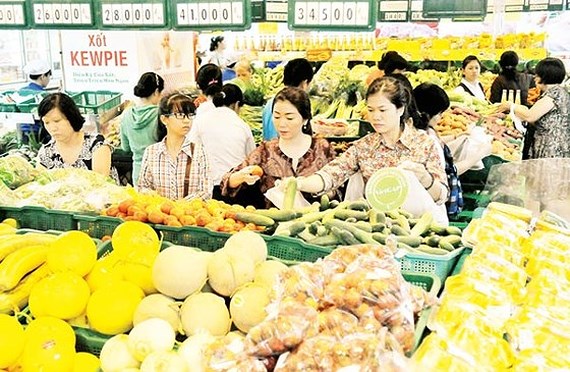 Ho Chi Minh City (HCMC) is piloting the program to deliver food in accordance with the food hygiene and safety regulations for all schools in six municipal districts. The HCMC Department of Education and Training has just issued a document to instruct heads of the Division of Education and Training in all 24 districts citiwide to carefully select food suppliers for schools in order to guarantee food quality and safety. Accordingly, in the six piloted districts of 3, 5, 8, 11, Tan Binh, and Binh Thanh, 100 percent schools must choose food suppliers, meeting the food hygiene and safety regulations issued by the Food Safety Management Authority of HCMC, or other similar certificates like ISO 22000:2005, Hazard Analysis and Critical Control Points (HACCP), Vietnamese Good Agricultural Practice (VietGap), Global Good Agricultural Practice (GlobalGap), and Good Manufacturing Practices (GMP). In the other 18 districts, the HCMC Department encourages its members to prepare a route to implement this program beginning this academic year of 2018-2019. It is expected that in 2020, all canteen and kitchens of schools citiwide must receive high-quality food. Particularly, any school which has not terminated its contract with low-quality food suppliers in the academic year of 2017-2018 must announce the contract termination time in written form and send to the Division of Education and Training for a summary report to the HCMC Department of Education and Training. ‘Student Research Awards 2018’ launched The Ministry of Education and Training (MOET) has just introduced a detailed plan on launching the ‘Student Research Awards 2018’. This is an annual award presented to students who love doing research all over the country, co-held by the MOET, the Ministry of Science and Technology, the Central Committee of the Ho Chi Minh Communist Youth Union, and the Vietnam Union of Science and Technology Associations (VUSTA). All submitted projects for the award must be approved by the scientific committee at grassroots level. What is more, the nominated must be innovative and novel, feasible and scientifically valued. Projects that have been published in national and international scientific journals or are now implemented in reality will be preferred. Besides the requirement of ensuring honesty in scientific research, those projects must not receive any ministry-leveled awards at the time of submission. There are six scientific and technological fields of natural science, science and technology, medical science, agricultural science, social science, and humanities. All submitted projects will be evaluated in preliminary round first and then the final round. The award ceremony is expected to be held at the end of this November. HCMC students bring classical dramas onto stage
 A scene of My Sister's Keeper where Kate (sitting on wheelchair) says the very last words to her family before her death Students at the Faculty of Foreign Languages at the HCMC Open University staged My Sister's Keeper, an American novel by Jodi Picoult, at the Drama Theater in downtown HCMC last Saturday. This is one of four American and British novels brought onto stage under the university’s Theater in Education program, with an aim to encourage the English language-learning community in HCMC to practice English and embrace their love for world-known English and American literary works. My Sister's Keeper tells the story of 13-year-old Anna Fitzgerald as she sues her parents, Brian and Sara, for medical emancipation after she discovered she was supposed to donate a kidney to her elder sister Kate, who is dying from acute leukemia. The story focuses on nurturing the love and affection among family members. However, above all, love must be fair in any case and the people, especially children, must have the ultimate right to their own body. Even parents should get their permission for doing anything that may affect their physical condition. With the help of their teachers as mentors and language editors, the students, even though amateur, acted so naturally and emotionally, bringing the audience a memorable and meaningful night. “Everything, from lighting and sound system, to stage properties, the organizers, tea break, and especially the students’ acting, are so professional. If they don’t say they are students, I would think they are professional actors,” a spectator named Vo Thanh Tuan told the Daily. According to Le Quang Truc, the lecturer who initiated Theatre in Education, the program has received great support from heads of the HCMC Open University, the university’s alumni, sponsors, the media, and many volunteers. One of the most enthusiastic volunteers is Ilse Zoerb, an American teacher at ILA English Center in HCMC, who helped the students with their pronunciation and played the judge in My Sister's Keeper. “The untrained actors are oftentimes just as interesting and watchable as trained actors. The students inspired me and I admired them a lot. They are very brave since it is difficult to stand on stage and share a story, especially taking on the added challenge of acting in a language that was not their mother tongue,” she said. “The performance is so smooth. I think the students had practiced very hard, with all their love and passion. I’m really impressed by the girl who played the mother as she acted naturally and her intonation was really good,” said Nguyen Ngoc Vinh, an audience, to the Daily after the show. My Sister's Keeper is the fourth and also the last drama brought onto stage under the Theatre in Education program. The earlier plays include The Happy Prince by Oscar Wilde, which opened the program on May 19, Agnes Grey by Anne Bronte, and Emily Bronte’s Wuthering Heights. The plays not only brought wonderful moments to the audience but also conveyed humanitarian values to the community and provided Vietnamese students majoring in English with opportunities to practice English, learn about English and American literary works, and boost their creativity. “By joining the program, I can learn a lot about teamwork, especially how to get along well with other people and sacrifice my private affairs for the team. In addition, the program helps me improve my English and acting skill, and boost self-confidence,” said Le Vo Nhat Huy, third-year student at HCMC Open University, who played the Mayor in The Happy Prince. Speaking to the Daily after The Happy Prince, Dinh Thi Ngoc Lan who played little swallow, said the play encourages her and other people to help each other, and create a better and happier life. Initiated in 2016 by Le Quang Truc as he wanted to use dramas to teach foreign language and assist his students to delve into English and American literature and culture, Theater in Education has been an attractive and meaningful annual program for the English language-learning and expat communities in HCMC. Communication workshop held in response to immunisation week
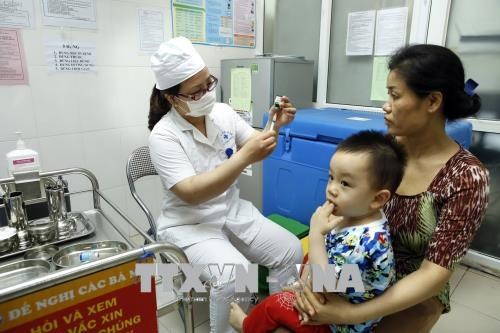 A communication workshop was held in Hanoi on June 12 in response to the immunisation week. Director of the National Institute of Hygiene and Epidemiology (NIHE) Dang Duc Anh said the week is carried out this month with a view to increasing the effective implementation of the national expanded vaccination against infectious diseases. This is a practical activity to raise public awareness of the importance of vaccination and call for the involvement and investment of authorities at levels and domestic and foreign organisations, he added. According to the NIHE, the coverage of immunisation in the first three months of 2018 was on progress. Specifically, the rate of infants receiving hepatitis B vaccines within the first 24 hours after birth was 16.9 percent, higher than the same period last year (16.2 percent). The number of whooping cough cases in January-March was reduced in comparison to the same period in 2017. No diphtheria cases were reported in the reviewed period (five cases recorded in the first quarter of 2017). Particularly, in February 2018, the measles-rubella vaccine produced by Vietnam was utilised for children in Nam Dinh, Khanh Hoa, Dak Nong and Ba Ria-Vung Tau provinces. As a result, 7,787 children aged 18-24 months received vaccination and no serious reaction cases were recorded after that. The national vaccination information management system has been operated nationwide with more than 11,000 vaccination sites at medical stations in communes and wards. Training courses for vaccination workers were held. The immunisation week was initiated by the World Health Organisation in 2011. At present, 180 countries and territories have joined this event to protect the public health. Gender equality significant for nation’s global integration: official
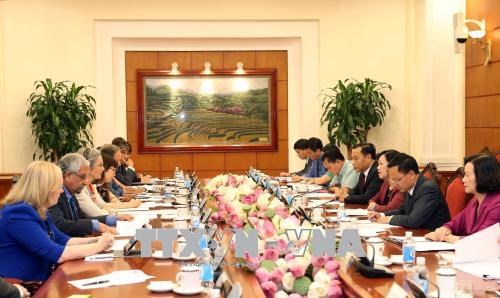 At the meeting between head of the Party Central Committee’s Commission for Mass Mobilisation Truong Thi Mai and Informal Ambassadors and heads of Agencies Gender Policy Coordination Group on June 12. Fulfilling gender equality criteria is significant for Vietnam, especially when the country is integrating deeply into the global economy, said Head of the Party Central Committee’s Commission for Mass Mobilisation Truong Thi Mai. In a meeting with the Informal Ambassadors and Heads of Agencies Gender Policy Coordination Group in Hanoi on June 12, Mai laid stress on Vietnam’s efforts to realise gender equality targets. Despite limitations, the implemented policies have made significant contributions to raising public awareness on creating equal chances for female workers. The amended Labour Code will be submitted to the National Assembly in May, 2019, she noticed, adding that it will ensure rights of the labourers, gender equality, social welfare and the unanimity of the legal system, which are in line with international treaties which Vietnam has involved in. Kamal Malhotra, Co-Chair of the Informal Ambassadors and Heads of Agencies Gender Policy Coordination Group and the Resident Coordinator of the United Nations in Vietnam, said that he wants to study Vietnam’s stance and the promotion of gender equality in the amended labour code, especially empowerment for women, gender equality and female workers, harmony of the retirement age between men and women, and regulations on sexual harassment and gender-based violence at working place. He believed that removal of gender prejudice will help unlock women’s potential, thus improving labour quality and reducing labour shortage. The group also hoped that the amended labour code will maintain regulations on maternal leave and breastfeeding period, Kamal Malhotra added. VNN |
↧
Article 4
Plastics manufacturers struggle to survive amid M&A boom While more and more foreign giants are coming to Vietnam, domestic plastics companies are still fumbling for a way to control supply sources. 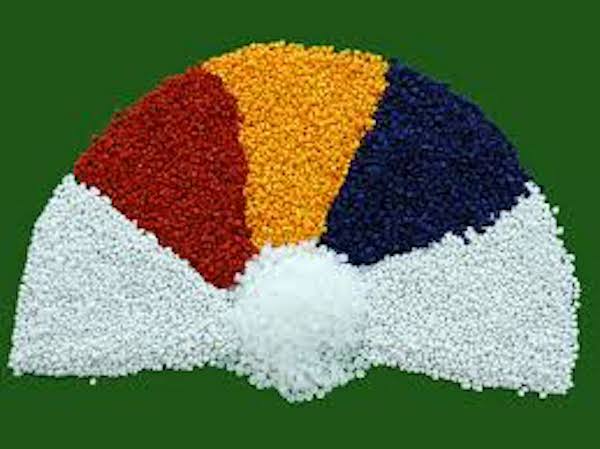 In the plastic tube market segment, for example, Tien Phong Plastics holds 60 percent of northern market share and Binh Minh 50 percent of southern market share. Acquiring Tien Phong’s or Binh Minh’s shares would allow foreign investors to easily set foot in the Vietnamese plastic tube market. Nawaplastic Industries, a subsidiary of Siam Cement Group (SCG), has become the biggest shareholder of Binh Minh with 50.9 percent of shares. Analysts say the deal helped SCG realize its ambitious plan of building up a value chain in Vietnam’s plastics industry. SCG also owns a plastic bead manufacturing company and holds a stake in several other companies, including Vietnam-Thailand Plastchem, TPC Vina, Chemtech and Minh Thai Company. SCG’s president Kan Trakulhoon has said the group would pour more capital into Vietnam and take over domestic companies.
Japanese have also geared up with a plan to take over Vietnamese plastics companies to make products for export to Japan, which has become Vietnam’s biggest export market. United, Goldsun and Dong A have fallen into Japanese hands. Analysts say that investors from South Korea and China are also taking steps to penetrate the Vietnamese market. Vietnam doesn’t set limits on the foreign ownership ratio in Vietnamese plastics companies, which means that foreigners can buy up to 100 percent of shares of the companies. Foreign investors can see great potential there: the plastics consumption level is 41 kilograms per head per annum, which is still lower than the average level of 48 kilograms in Asia and 70 kilograms in the world. According to BMI Research, Vietnam’s food sector would see 10.9 percent growth ate in 2015-2019, and the bottled drink sector 17-25 percent, which will give great opportunities for the plastics industry to develop. However, though the market has great potential, Vietnamese enterprises have to struggle to exist. Their biggest problem is the heavy reliance on input material imports. According to the HCM City Rubber & Plastics Association, Vietnam would need 5 million tons of materials by 2020. Meanwhile, 70-80 percent of materials are imports. As a result, Vietnamese enterprises have to spend big money to store materials and do not have a lot of working capital. They also face risks from exchange rate fluctuations and world oil prices. VNN |
↧

